









For over a decade, our portfolio of in-house magazines has been lovingly produced, printed, and distributed to our esteemed subscribers across the globe from our headquarters in the UK.


But now we are moving with the times, adopting a digital-first approach by producing online-only publications. A major factor in this decision is to minimize our environmental footprint, reducing the carbon emissions involved in the logistics of print magazine distribution and the resources required therein.

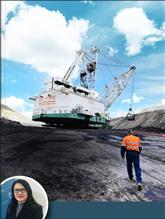

“We always planned that when our digital subscribers consistently accounted for 85% of our total magazine subscribers, we would cease printing our publications in-line with our environmental and sustainability goals.”
Going forward, we will provide print orders of any magazine in-line with the requests of our featured companies, subscribers, and conference & expo partners.


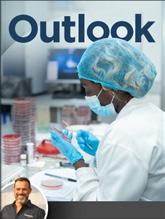
Please get in touch for a print-on-demand quote or visit our website to find out more.

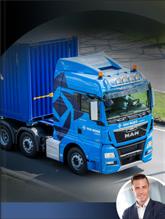
– Ben Weaver, CEO, Outlook Publishing Ltd
EDITORIAL
Head of Editorial: Marcus Kääpä marcus.kaapa@outlookpublishing.com
Senior Editor: Jack Salter jack.salter@outlookpublishing.com
Editor: Phoebe Harper phoebe.harper@outlookpublishing.com
Editor: Lucy Pilgrim lucy.pilgrim@outlookpublishing.com
Editor: Ed Budds ed.budds@outlookpublishing.com
Junior Editor: Rachel Carr rachel.carr@outlookpublishing.com
PRODUCTION
Production Director: Stephen Giles steve.giles@outlookpublishing.com
Senior Designer: Devon Collins devon.collins@outlookpublishing.com
Designer: Sophs Forte sophs.forte@outlookpublishing.com
Junior Designer: Louisa Martin louisa.martin@outlookpublishing.com
Production Assistant: Megan Cooke megan.cooke@outlookpublishing.com
Digital Marketing Manager: Fox Tucker fox.tucker@outlookpublishing.com
Social Media Executive: Bria Clarke bria.clarke@outlookpublishing.com
Web Editor: Oliver Shrouder oliver.shrouder@outlookpublishing.com
BUSINESS
CEO: Ben Weaver ben.weaver@outlookpublishing.com
Managing Director: James Mitchell james.mitchell@outlookpublishing.com

Sales Director: Nick Norris nick.norris@outlookpublishing.com
Commercial Director: Joshua Mann joshua.mann@outlookpublishing.com
REGIONAL DIRECTORS
David Knott david.knott@outlookpublishing.com
Tom Cullum tom.cullum@outlookpublishing.com
PROJECT MANAGERS
Felix Revell felix.revell@outlookpublishing.com
Lauren Robinson lauren.robinson@outlookpublishing.com
Louis Locke louis.locke@outlookpublishing.com
Michael Sommerfield michael.sommerfield@outlookpublishing.com
Scarlett Burke scarlett.burke@outlookpublishing.com
HEADS OF PROJECTS
Callam Waller callam.waller@outlookpublishing.com
Deane Anderton deane.anderton@outlookpublishing.com
Eddie Clinton eddie.clinton@outlookpublishing.com
Ryan Gray ryan.gray@outlookpublishing.com
Thomas Arnold thomas.arnold@outlookpublishing.com
TRAINING & DEVELOPMENT DIRECTOR
Marvin Iseghehi marvin.Iseghehi@outlookpublishing.com
SALES & PARTNERSHIPS MANAGER
Donovan Smith donovan.smith@outlookpublishing.com
SALES MANAGERS
Alfie Wilson alfie.wilson@outlookpublishing.com
Jordan Sibley jordan.sibley@outlookpublishing.com
Krisha Canlas krisha.canlas@outlookpublishing.com
ADMINISTRATION
Finance Director: Suzanne Welsh suzanne.welsh@outlookpublishing.com
Finance Assistant: Suzie Kittle suzie.kittle@outlookpublishing.com
Finance Assistant: Victoria McAllister victoria.mcallister@outlookpublishing.com
CONTACT
North America Outlook Norvic House, 29-33 Chapelfield Road
Norwich, NR2 1RP, United Kingdom
Sales: +44 (0) 1603 363 631
Editorial: +44 (0) 1603 363 655
SUBSCRIPTIONS
Tel: +44 (0) 1603 363 655 marcus.kaapa@outlookpublishing.com www.northamericaoutlookmag.com
Like us on Facebook: @northamericaoutlook
Follow us on Twitter: @NA_Outlook
Welcome to our latest issue of North America Outlook magazine!
In this 18th edition, we take a look at the pressing importance of industrywide decarbonization developments. Whether operating in the transport, healthcare or technology sectors, efforts exist to bring about a low carbon future for the region and build a healthier and happier world.
Beyond the sustainability space, our cover feature is one that truly encapsulates happiness; Canada’s Wonderland has been creating amusement all year round since 1981 and has entered this decade with a bang, bringing with it fun for everyone.
“We have great thrill rides and exciting roller coasters, but we also provide great experiences for families with our children’s areas and 20-acre water park,” opens Phil Liggett, Vice President and General Manager. “Helping to create that fun and those memories is the best part of what we do at the park every day.”
On top of this, and fitting with this month’s July 4th celebrations, we take to the freedom of the waves with Saltchuk Marine, proudly serving the US with its seafaring fleet of reliable, versatile and responsive tugboats.
“We provide rescue tows around the world and emergency response when called upon. As proven by the COVID-19 pandemic, we are an essential service that keeps the wheels of commerce turning,” details Jason Childs, President and CEO.
Elsewhere, dive into the secrets of logistical streamlining with UPS Supply Chain Solutions®, sustainable foodservice practices with Mahoney Environmental, aircraft turbine applications with Moeller Aerospace, innovative gas systems with Galileo technologies, and many more.
We hope you enjoy your read.
Marcus Kääpä
Head of Editorial, Outlook Publishing




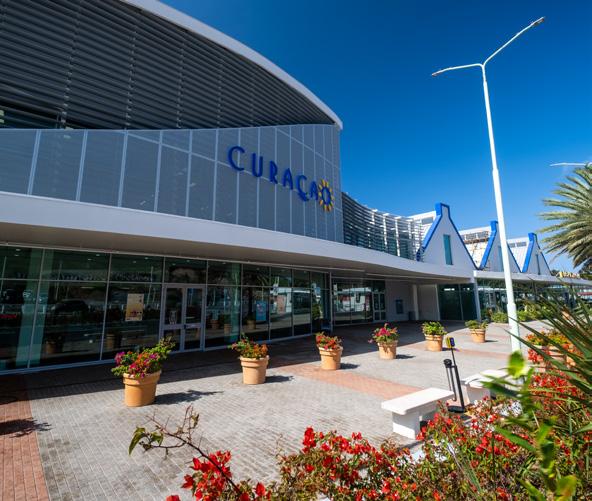
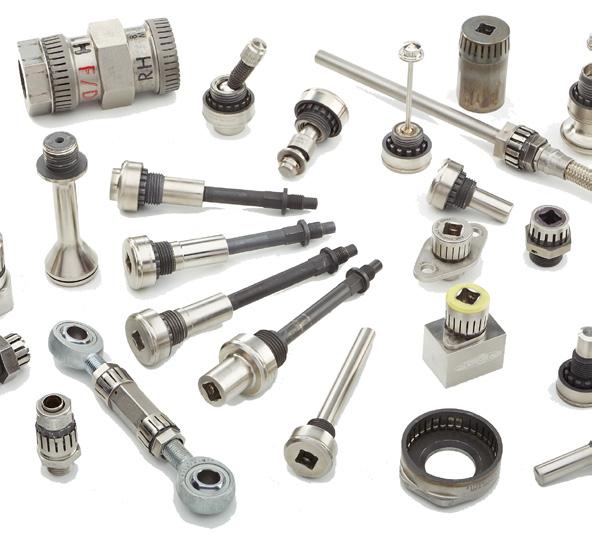





FOLLOWING A GLOBAL crackdown on account sharing from brands such as Netflix, Costco has decided to follow suit and take preventive measures into its own hands.

The US retail behemoth is clamping down on shoppers craftily sneaking into its stores and trying to do their shopping with other people’s membership cards.
Having always employed the policy
of asking shoppers for their membership cards at the cash registers before they pay, customers will now be asked to show a photo ID to prove the membership is their own.
Costco stands apart from most retailers because of its unique business model, as the bulk of its earnings stems from membership fees, which help to keep product prices extremely low.
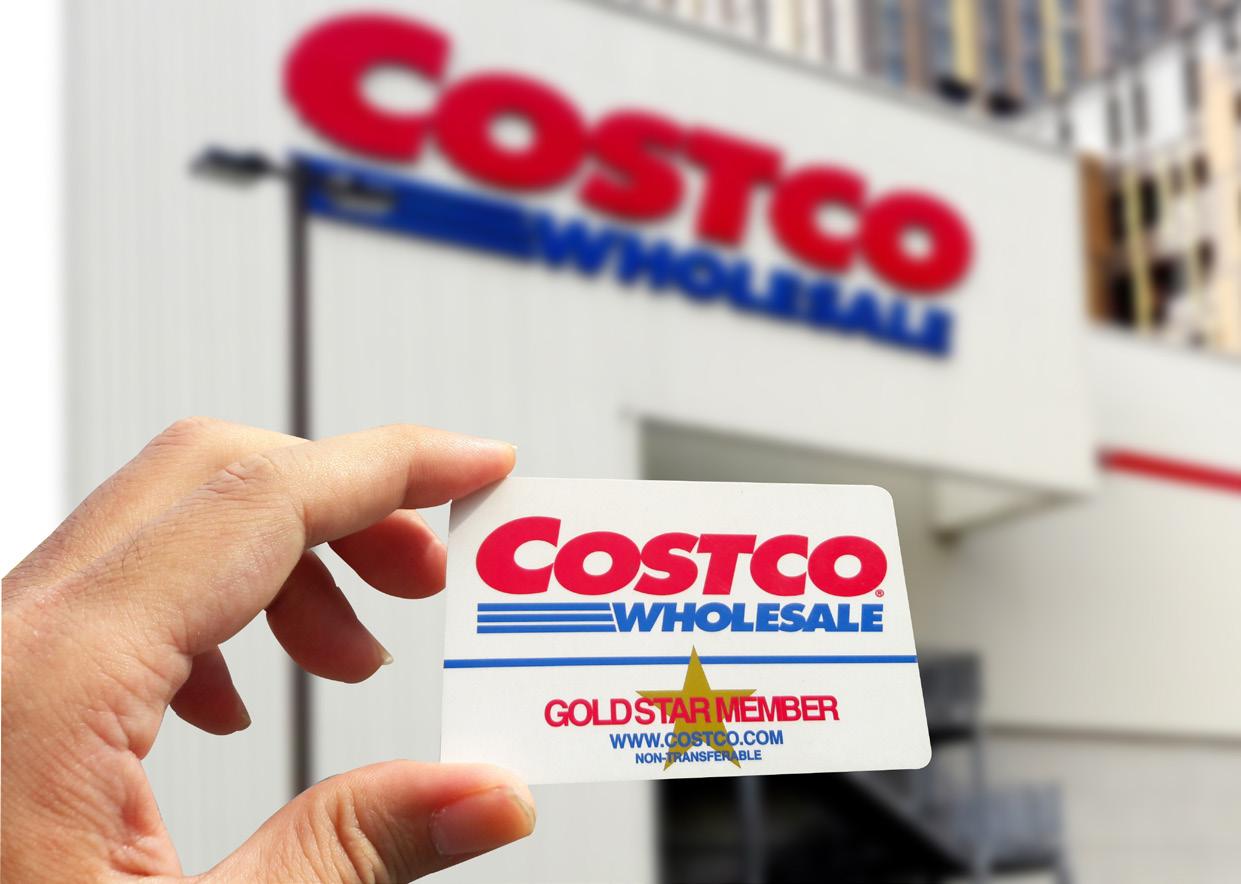
THE AUTOMOTIVE INDUSTRY isn’t the only sector going electric. A new environmentally friendly trend is sweeping the US in the form of battery-powered leaf blowers, grass mowers, and string trimmers. These electric-powered outdoor tools have started to dominate neighborhoods and golf courses around the country, as part of the transition away from gas power.
Home Depot recently estimated that the market for electric tools and related battery sales is $32 billion and counting. However, there are still obstacles to adoption as batterypowered leaf blowers and mowers can be much more expensive than their predecessors.
DELTA HAS BEEN crowned the best US airline at the ‘Oscars of Aviation’, the Skytrax World Airline Awards.

The ceremony was hosted at the Paris Air Show and ranks 325 airlines across a variety of comprehensive categories, using data from survey responses.
The 23rd iteration of the annual
awards ceremony at the Air and Space Museum in Paris featured numerous senior figures in the aviation industry and airline CEOs in attendance.
Delta Air Lines took home the award for number one carrier in North America for the second year in a row, climbing the overall global rankings from 24th to 20th.
So far 2023 has welcomed several prestigious accolades for Delta, with the Wall Street Journal declaring it the top US airline of 2022 back in January.


AUTOMOTIVE FOLLOWING DRAMATIC PRICE slashes, Tesla has delivered a record number of vehicle sales in its second quarter, topping all market estimates, as its strategy to lower prices has paid off and US consumers have taken full advantage.
The American carmaker has comprehensively beaten market expectations and delivered 466,140 cars in three months, an increase of 10.4 percent in the first three months of the year.
Affordability was previously identified by CEO, Elon Musk as a key factor that was limiting sales. As
AEROSPACE
AMERICAN SPACEFLIGHT
COMPANY, Virgin Galactic’s rocket ship has taken passengers more than 50 miles above the Earth’s surface to the edge of space. Furthermore, British billionaire Sir Richard Branson’s private company has finally completed its maiden commercial flight.
a result, the cost of Tesla’s vehicles was reduced to keep the company competitive with rivals, as traditional carmakers continue to boost their electric vehicle production.
to the experience of around five minutes of weightlessness, allowing them to float freely around the cabin.
Branson wants to give people the opportunity to explore the universe through his spaceflight brand after completing a similar trip himself back in July 2021, and becoming the first owner of a private space company to jet into space.
Flights will soon initiate for the 800 people who’ve bought tickets for the rocket so far, with each seat costing

ACCORDING TO THE latest environmental analysis, four of the five cities with the worst air quality in the world are in North America, including New York City, Toronto, Montréal, and Washington D.C.
This shocking discovery has not been helped by the devastating forest fires across Canada that have sent smoky air swarming across the continent, engulfing many cities.
New York City now possesses the second-worst air quality in the world with a recorded air quality index of 162, behind only Jakarta in the rankings. At present, anything exceeding an AQI of 150 is considered unhealthy and potentially harmful air.
FOOD & BEVERAGE
FOR PIZZA LOVERS craving a taste of their favorite takeaway while sunbathing on a beach or relaxing in a public park, Domino’s Pizza is aiming to transform its delivery service to be as easy and accessible as it is when at home.
With the unveiling of its new pinpoint delivery service, customers can now order Domino’s nationwide across the US to locations without a standard address. Pizza lovers can fol low their orders in real-time using the company’s tracking service, access a driver’s GPS location and receive text alerts about the delivery’s progress.
delivery technology in Australia in 2017, but the pinpoint delivery rollout will make the feature available for the first time in US markets.

As the US confronts the urgent need to tackle climate change and transition to a low-carbon future, the development of gigafactories – industrial plants which produce advanced lithium-ion batteries – has emerged as a pioneering solution. Gigafactories are state of the art facilities that have the potential to decarbonize crucial sectors of the economy where lithium-ion batteries can provide power. These sectors include transport, data centers, and renewable energy infrastructure.
Heading up the American transition to a low-carbon future, Lars Carlstrom, Founder and CEO of Statevolt and Italvolt, discusses one of the most impactful developments underway today –gigafactories
 Written by: Lars Carlstrom, Founder and CEO of Statevolt and Italvolt
Written by: Lars Carlstrom, Founder and CEO of Statevolt and Italvolt
The future success of decarbonization in the US will rest upon the ability of the country to dramatically cut the emissions from highly polluting sectors. A prime example is transport; the sector accounted for 29 percent of greenhouse gas (GHG) emissions in the US in 2021, significantly exceeding emissions from industry, which accounted for 23 percent. Producing lithium-ion batteries at scale will be crucial to support the decarbonization of the US economy. Furthermore,
ensuring the US can meet its energy transition goals independently is essential to guarantee the security of supply and remain competitive on a global scale. Establishing a strong US footing in the battery production field will help counter China’s dominance in the electric vehicle (EV) supply chain and manufacturing process.
Gigafactories can lay the foundation for modern, future-proof industry in the US. As large-scale and technologically advanced battery plants, gigafactories have the potential to redefine the industrial landscape for states that build them. The highly complex and technological process for battery development requires specialist skills which can help attract talented workers to the facility’s location and help create opportunities for existing workers in the region – each factory can create thousands of highly-skilled jobs. This is especially true for gigafactories planned for development in the industrial heartlands of the Southern and Midwestern US, where workers possess deep existing knowledge in automotive or heavy industries, allowing them to upskill or develop entirely new capabilities.
In addition to upskilling workers, gigafactory development can provide wider economic benefits in the communities where they are built. Statevolt, the company I founded and currently run as CEO, is building its gigafactory in Imperial Valley, California, and will serve to illustrate how gigafactories have the potential to revitalize underdeveloped communities. Due to their scale and highly advanced manufacturing processes, gigafactories can be economic engines that empower local communities and create highquality jobs. Statevolt is focused on supporting growth and regeneration in the area, with an ambition to provide direct employment for up to 2,500 people in the Imperial Valley community.
To further reduce carbon emissions from gigafactory and lithium-ion battery development, Statevolt is pioneering a ‘hyperlocal business model’, which aims to rely on local sourcing, processing, and production to produce lithium-ion battery cells that are made in the US from start to finish. The result will be a local and reliable supply chain that eliminates dependence on foreign sources while reducing the net carbon footprint. Given the level of capital required to start a gigafactory, each project represents a huge investment in the region. GlobalData research estimates that between $106 billion and $177.6 billion is set to be invested in gigafactories worldwide between 2020 and 2030. Gigafactories can provide significant direct and indirect economic opportunities for local communities, as well as adjacent industries which supply gigafactories and the needs of their employees. The gigafactory Statevolt is currently developing aims to create 2,500 full time jobs for people in the Imperial Valley region.
The plan to build gigafactories across the US will not be without its challenges, notwithstanding the large capital expenditure required to kickstart production. However, as the demand for EVs and energy storage rises over the coming decades, there is a strong imperative to accelerate gigafactory development. States such as California have implemented bans on the sale of new petrol and diesel cars from 2035, as a means of accelerating the switch towards battery powered EVs by 2035. As such, lithium-ion powered EVs are the only realistic alternative.
According to the International Energy Agency’s (IEA) Sustainable Development Scenario, for the world to meet climate and sustainable energy goals, close to 10,000 gigawatt hours (GWh) of batteries and other forms of energy storage will be required worldwide by 2040, which is around
50 times the size of the current market. For us to meet net zero targets while securing a just transition, we must look towards gigafactories as the solution.
The development of gigafactories across the US will make the shift to net zero a sustainable and efficient reality while strengthening the US’ automotive industry.
A hyper-local business model which narrows the distance between producers and consumers can further advance these aims, creating a positive, long-term economic future for people and economies throughout the continent.
Lars has over 30 years’ experience in the automotive and batteries sector, including as the Former Chairman of Britishvolt. He is currently the Founder and CEO of Statevolt and Italvolt

Statevolt
Founded in 2021, Statevolt’s vision is to be a leading player in the energy transition for a more sustainable future. Statevolt’s mission is to ensure that American communities and workers reap the benefits of the clean energy economy by building battery gigafactories in strategic US locations and pioneering a hyperlocal model that prioritizes sustainability and a domestic supply chain.
We speak to Richard Matonich, Regional Division Manager for Large Motors and Generators at ABB, about the latest decarbonization technologies for industries across North America

 Writer: Marcus Kääpä
Writer: Marcus Kääpä
Electric motors are essential to a multitude of industries, but they are also major consumers of the world’s energy. Fortunately, high-efficiency motor technology is now available that is both good for sustainability and profitability.
It comes as no surprise that global industries are a major contributor to carbon emissions. Four in every 10 tons of coal are burned to power industry, and 42 percent of all electricity generated worldwide is used by industrial facilities. Decarbonization to reach net zero carbon emissions by 2050 therefore requires industry activity around the world to adapt.
Yet there is no single solution that will transform industries. Instead, it will be a combination of many technologies and approaches. Some, like the large-scale implementation of hydrogen, are not yet mature. Others, such as energy efficiency, are available for businesses to act on today, bringing us significantly closer to net zero. The International Energy Agency (IEA) calls energy efficiency “the first fuel –the fuel you do not have to use”.
“Fortunately, according to March 2023 Energy Insights report, 97 percent of the 2,300 leaders of industrial businesses surveyed plan on improving energy efficiency,” begins Richard Matonich, Regional Division Manager for Large Motors and Generators at ABB. “There exist steps that businesses can take today to bring us closer to net zero.”
When looking for opportunities to improve efficiency, the electric motor is a logical place to start. Electric motors are common across industries – they power fans, compressors, pumps, conveyors, and all sorts of other machinery – and are highly energy-intensive.
“Collectively, the world has more
ABB is a technology leader in electrification and automation, enabling a more sustainable and resource-efficient future. The company’s solutions connect engineering know-how and software to optimize how things are manufactured, moved, powered and operated. Building on more than 130 years of excellence, ABB’s 105,000 employees are committed to driving innovations that accelerate industrial transformation.
ABB not only advocates for a decarbonized future but also develops innovative solutions to reduce carbon footprint and minimize environmental impact. For example, the company recently launched the new generation AMI 5800 NEMA modular induction motor, which offers energy efficiency and reliability in demanding applications across various industries. Additionally, ABB has introduced the Top Industrial Efficiency (TIE) initiative, ensuring the availability of optimal large motor and generator solutions that offer the highest efficiency without compromising reliability or utilizing unproven technology.
the machines they power consume approximately 45 percent of all electricity generated. Further, the number of motors is expected to double by 2040,” Matonich tells us.
“Large industrial motors, in particular, must be a focus of efficiency efforts. Although these motors account for less than one percent of all electric motors, they use 23 percent of the electricity. In many cases, the larger the motor, the greater the potential for energy efficiency measures.”
Fortunately, motor technology has advanced rapidly. Today’s motors are even significantly more energy efficient than models from just five to 10 years ago, enabling facilities to greatly reduce the amount of power they use. This also has significant benefits in terms of energy security and operating expenditure (OpEx), especially during periods when electricity prices are high.
The global drive for more efficient motor technology is, in part, advanced
by authorities implementing minimum efficiency standards. These create market pressure for more efficient solutions, and many manufacturers work to develop solutions that exceed the minimum. This futureproofs end users against potential additional legislation and enables even greater energy savings.
For example, the latest generation AMI 5800 True NEMA motor is designed specifically for the North American market and achieves outstanding energy efficiency. All AMI 5800 configurations meet North American energy efficiency standards, and most configurations exceed them. Some even achieve efficiency greater than the IE4 equivalent “super-premium” level while still meeting NEMA standards.
However, unlike small and mediumsized motors, large motors in the tens of megawatts are not subject to minimum energy performance standards (MEPS). This is unfortunate, as efficiency is especially important in large motors – their power ratings are so high that tens of kilowatts can be saved with even relatively small efficiency improvements. Small decreases in the amount of power used also add up over time, which is significant as many large motors run for over 8,000 hours each year.
To address the lack of MEPS, ABB has launched the Top Industrial Efficiency (TIE) initiative to provide motors that meet the highest efficiency standard. TIE motors are no-compromise solutions that rely on proven technologies.

A common misconception is that energy efficiency is expensive –according to the Energy Insights Report, 33 percent of businesses list cost as a major obstacle to efficiency. Yet, in reality, greater energy efficiency results in direct savings.
“This design also offers a range of other benefits, including rugged reliability. It has a welded steel frame, which lowers stress on the motor and reduces vibrations. As a result, it is suitable for highly demanding applications, such as within the oil and gas, mining, cement, and metal industries,” Matonich explains.
“The AMI 5800 NEMA is compatible with common mechanical mounting standards and entirely modular in terms of cooling methods, bearing, shaft extensions and terminal boxes. This makes it ideal for new installations and retrofits of existing ones.”

“For example, 97 percent of the total cost of ownership (TCO) of a motor goes to the electricity required to power it. Considering motors typically last for 15 to 20 years, the potential savings are significant. Therefore, while more efficient motors may be slightly more expensive up front, they are far cheaper in the long term,” Matonich concludes.
“In this way, businesses can play their part in our global journey to net zero and reduce the operating costs associated with energy consumption – a genuine win-win. All we need now is for forward-thinking operators to take the initiative and begin making energy efficiency a top priority on the road to decarbonization.”



 Writer: Jack Salter
Writer: Jack Salter
North America Outlook (NA): Why is pressure growing on the US healthcare industry to lower its carbon footprint?

Reeve Benaron, co-Founder and co-CEO (RB): Being honest, the US healthcare industry (and the global one for that matter) has historically been overlooked in terms of its environmental impact. Medicine packaging, COVID-19 test kits, and the medical instruments used in hospital settings are typically seen as exempt for their negative green impact (plastics, nonbiodegradable chemicals in products). Saving lives takes priority and precedent.
But things have been intensifying and changing for a while in terms of environmental scrutiny on private medical product suppliers and the practices of US hospitals, which is a good thing. The US healthcare industry is reportedly responsible for 8.5 percent of total carbon emissions in the country, with pollution rates from the sector increasing.
A large bulk of this is from the initial supplier side of products and services. Immense carbon emissions generated from energy-intensive facilities in drug production is commonplace (medicine manufacturing plants also often run 24/7). Then, you have the constant production of new medical devices, i.e., pacemakers, cardiovascular monitoring equipment, hemodialysis machines, and CT scanners, and manufacturers are always trying to outdo one another and lead the way in competitor innovation. Medical devices are always quite quickly upgraded if the budget is available from the healthcare setting and older versions of MedTech are disposed of quite quickly, leading to mass volumes of healthcare e-waste across the US industry.
Also, with the obvious focus being on saving people’s lives, healthcare settings are typically quite wasteful and discardable with their medical implements. This is usually for sanitation reasons, but it has strong recycling
hospital kitchens.
With this in mind, and the touted 8.5 percent of US carbon emissions generated by the country’s healthcare industry, it’s clear we have problems to address. That’s why we’ve seen the National Academy of Medicine (NAM) launch the Action Collaborative on Decarbonizing the US Health Sector initiative, and huge US MedTech providers such as Cardinal Health and pharmaceutical firms like Eli Lilly and Company really ramping up their carbon emission sustainability programs, mainly to negate carbon footprints causing issues in RFP/tender processes.
NA: How is climate change affecting the ability of the US health system to deliver safe, effective, and efficient care?

RB: Naturally, it is making provision of medical products and healthcare supply more complicated, as it’s another factor for healthcare boardrooms to tackle for external stakeholders. Pharmaceutical companies will have the biggest challenges from regulators, given the scale of pollution created in mass market drug production. But like I say, we can’t stop delivering life-saving

 DIAGNOSTICS
DIAGNOSTICS

person-centered healthcare for the service user. The pressure from regulatory bodies and ‘green consumer movements’ should push healthcare providers (mainly hospitals) to further invest in MedTech such as e-appointment bookings, e-prescription services, telehealth products, and health information technology portals. This will help healthcare providers overserving and over-medicating service users, or more ideally, help to give US consumers information on healthy lifestyles and self-management of their ailments and personal health, avoiding having to treat them in the first place. Preventive health services are key for efficient US healthcare and for healthcare sustainability initiatives.
NA: What benefits are there to reducing the carbon footprint of the healthcare ecosystem, and what are hospitals in the US doing to lower
Carbon curbing initiatives, such as e-waste audits on medical utensils and medical devices, naturally help achieve cost savings in healthcare settings, so that’s pretty obvious. Social benefits in my eyes will mainly be a company’s marketing strength – where MedTech/pharmaceutical companies are able to prove green credentials to secure tenders or contracts and achieve more revenue. healthcare industry will look like better preventive, personalized,

“TRUE SUSTAINABILITY IN THE HEALTHCARE INDUSTRY WILL LOOK LIKE BETTER PREVENTIVE, PERSONALIZED, PERSON-CENTERED HEALTHCARE FOR THE SERVICE USER”
– REEVE BENARON, CO-FOUNDER AND CO-CEO, INTRIVO
Tighter recycling processes and policies in US hospitals are steadily coming along. Reusable personal protective equipment (PPE) is pretty significant nowadays, and tendering processes for suppliers to supply drugs and medical devices are tightening up too. Some US hospital kitchens are trying ‘Meatless Mondays’, but I’m not sure what the carbon efficacy of that will be!

NA: How much more needs to be done to decarbonize the industry?
RB: Quite a lot is required I believe, and regulatory bodies need to interject with tighter policy enforcement if possible. The

Driving forward the nation’s sustainable commitments, the U.S. National Blueprint for Transportation Decarbonization strives to cut all greenhouse gas emissions by 2050, an ambitious but achievable objective
Writer: Lucy PilgrimThe US government has begun to take bold steps in transforming the environmental footprint of the transportation sector, as set out by the recent implementation of the U.S. National Blueprint for Transportation Decarbonization (Blueprint). The influential policy proposed by the Biden administration sets an international precedent for a governmental commitment to decarbonizing the transport sector by 2050.
Implemented in September 2022, the historic memorandum of understanding (MoU) champions a
synergy between the Environmental Protection Agency (EPA), the Department of Energy (DOE), Department of Transportation (DOT), and the Department of Housing and Urban Development (HUD). Following a targeted approach, the Blueprint seeks to address the transportation sector as the greatest contributor to carbon emissions. It covers all forms of transportation – including land, air or sea – and accounts for a third of the country’s green house gas (GHG) emissions. Evidently, the holistic approach of the Blueprint signifies how the
environmental responsibilities of the nation have become a primary focus in recent years, emphasizing that the commitment is not an aspiration, but an eventuality.
The Blueprint tackles three strategic areas to reach a state of decarbonization by 2050, which span all passenger and freight transportation elements. For each branch of the Blueprint, a short, medium and long-term goal is established, divided into 10-year segments.
Furthermore, it is projected to be a valuable resource for the multitude of stakeholders involved in the US transportation industry, as companies have begun to work in tandem with federal agencies. This is encouraged through necessary research, publicprivate partnerships, and training schemes, amongst other initiatives. Consequently, the Blueprint ensures that the revitalized transport sector will yield benefits such as reducing air pollutant emissions, enhancing sustainable urban planning and

advancing environmental justice objectives.
The short-term initiatives outline greater funding and authority implemented by the Blueprint, to spur a sector-wide transition to zeroemission vehicles and the increased use of sustainable fuels. Subsequently, the medium and long-term objectives herald the increased use of sustainable transportation solutions, brought to the helm by new policies, targeted investment, partnerships, and programs.

Convenience: The Blueprint supports community design, at both a regional and local level, through diligent land-use planning. Subsequently, common amenities and infrastructure such as shops, schools, offices, entertainment and more are purposefully located close to densely populated areas.
Efficiency: Alongside this, public transport and rail, would be restructured to improve efficiency, accessibility and affordability.
Clean: The Blueprint drives the
The first instruction of the Blueprint stands as a widespread transitioning to clean vehicles, conducive to the fact that the large majority of generated emissions stem from light, medium and heavy-duty vehicles, as well as buses and aircraft.
As such, the adoption of batterypowered vehicles is one of the most dynamic and effective strategies to decarbonize the transportation sector. This also aligns with President Biden’s environmental objective stated in 2021, in which 50 percent of vehicle sales will be zero-emission by 2030.
As the primary solution of meeting net zero by 2050, the use of batterypowered and electric vehicles (EVs) is supported by the by the long-term option of using hydrogen and biofuels, particularly for heavyduty vehicles and in more rural communities.
In regard to aviation, a similar ethos of using biofuels, hydrogen and methanol is encouraged as fossil fuel alternatives. The Blueprint absorbs many targets proposed by the Biden administration’s Sustainable Aviation Fuel Grand Challenge Roadmap, which dictates targets of reducing aviation emissions by 20 percent by 2030.
A significant Blueprint component
document calls on local governing bodies to incorporate sustainability into community decision making. This means consolidating different modes of transport and navigating the balance in the movement of people, goods and services. As a result, commuting burdens will be reduced, with improved walkability and cycling services.
The Blueprint further proposes federal agency intervention in local decision making around transportation and planning. In fact, it bolsters ideas around ‘smart planning’ - outlined as the relocation of renewable infrastructure including public vehicle charging stations and renewable energy facilities.
The final subsector to the Blueprint is the advancement of vehicle and system initiatives that increase the frequency of environmentally friendly passenger transportation, ranging from trains to personal vehicles.
The document suggests an expansion in funding and incentives for the use of sustainably efficient vehicles, compounded with greater investment in the advantages of rail and mass passenger transit.
Due to the fact that individual modes of transport are typically decided through personal choice, the Blueprint advocates for employers and schools to adopt policies and programs which incentivize
NORTH AMERICA OUTLOOK is a digital product aimed at boardroom and hands-on decision-makers across a wide range of industries on the continent.





With content compiled by our experienced editorial team complemented by an in-house design team, the resultant Outlook Creative Services department ensures delivery to the highest standards in promoting the latest in engaging news, industry trends and success stories across the length and breadth of the US & Canada.
As a bi-monthly publication, North America Outlook constantly has its finger on the pulse of the latest trends, biggest developments and business successes from each corner of the region, epitomized by the diversity displayed across each magazine. It incorporates an annual calendar-tailored front-of-book section, a showcasing segment dedicated to the most fascinating success stories in North America, and an event focus assortment sure to fill executives’ diaries throughout the year. The aligning North America Outlook website is also honed and ready to serve as a host for these facets and much more.
To get involved, please contact Outlook Publishing’s Managing Director, James Mitchell, who can provide further details on how to feature your company, for FREE, in one of our upcoming editions.



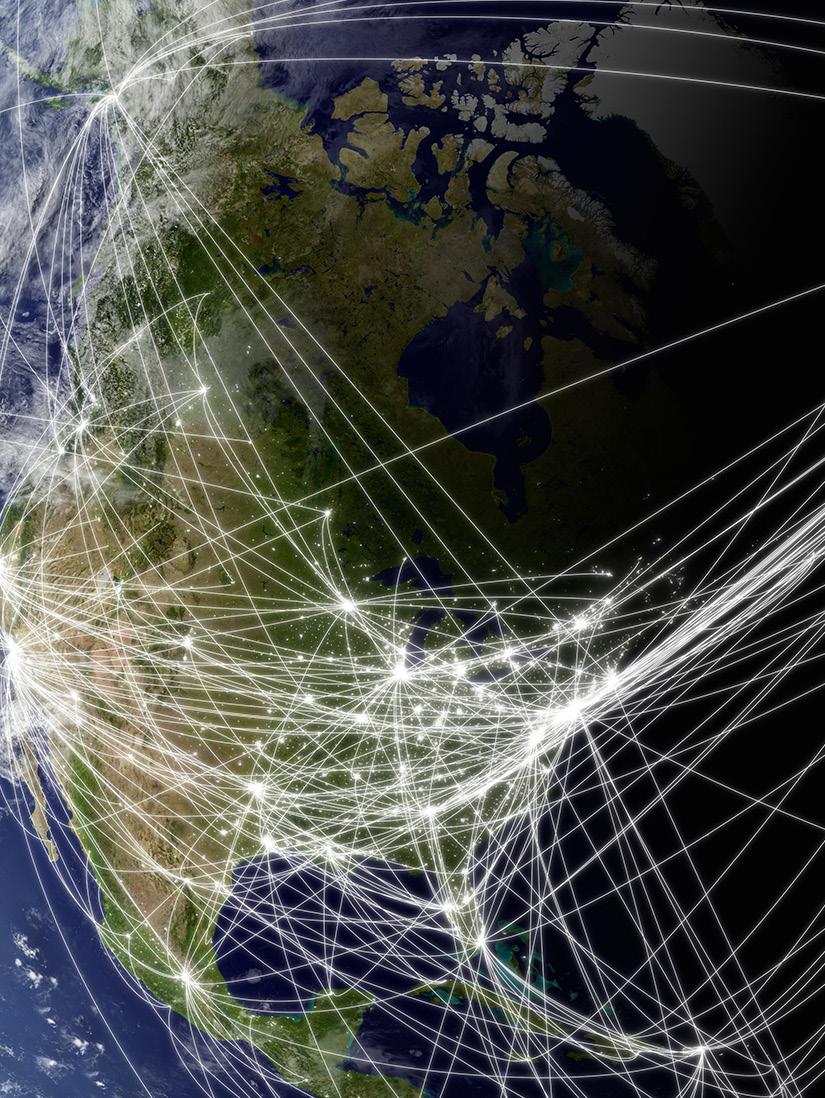
Diving into the Caribbean region, we take a look at Curaçao as a tranquil and strategic gem for investment, connecting Europe to the Americas
 Writer: Marcus Kääpä | Project Manager: Krisha Canlas
Writer: Marcus Kääpä | Project Manager: Krisha Canlas
Blessed with the enthralling beauty of azure Caribbean waters, white sand beaches, and a divine climate, Curaçao is marked out as a unique country within the paradisal region by a blend of European influences.

In centuries past, Portuguese sailors injured or stricken with illness were left to recover in the care of the island. Diseases such as scurvy were remedied by a change in diet, likely one that included vitamin C, with the country taking its name from the Portuguese curação, meaning “cure”.
From its status as a place of rest and recovery and its nickname as the “Island of Healing”, Curaçao’s historically strategic location off the northern coast of Venezuela marks it as a hub between the Americas and Europe. Indeed, the island has long drawn European attention, with a lasting Dutch colonial past apparent throughout the nation’s architectural footprint.
Today, Curaçao presents itself as an excellent destination for visitors wishing to experience the island’s natural tranquility and Dutch-Caribbean culture, yet the country also attracts attention from businesses seeking investment opportunities in the region. Based outside of the hurricane belt, Curaçao benefits from many ports, a natural and well-developed deep-water harbor, and frequent flights connecting the island to multiple continents. Curaçao’s economic stability and multilingual culture are bolstered by the island’s significant digital infrastructure, boasting 86.7 percent internet penetration, multiple data centers including the only Tier 4 data center in the Pan-Caribbean region, and a highly skilled talent pool.
With attractive offers available to tourists and businesses alike, Curaçao continues to position itself as an investment opportunity for international enterprises and an active hub within the Caribbean.

North America Outlook (NA): Could you briefly introduce us to CINEX?
Jeanette Bonet, Interim CEO (JB): As the authorized investment and export promotion agency for the government of Curaçao, CINEX focuses on attracting foreign investments and promoting the export of local products and services. Since its establishment in 2014, CINEX has been dedicated to fostering economic growth and development on the island. Its approach integrates investment and export promotion under one umbrella, allowing for a coordinated strategy to drive economic progress.

Investment promotion involves providing comprehensive information and assistance to investors throughout the entire investment process while promoting the country's investment opportunities, incentives, and positive image. CINEX aims to attract investment by facilitating and guiding investors in establishing their businesses in the country. We promote the country as an appealing investment destination, target investors based on identified needs, and advocate for policy reforms to facilitate investment on a broader scale.
Export promotion, on the other hand, supports
We speak with Jeanette Bonet, Interim CEO of CINEX, about bringing business and international investment interest to Curaçao
and promotes exports from local companies. CINEX assists domestic businesses in expanding globally by helping them identify new markets, providing market intelligence and research, and offering support with export documentation and logistics. They also encourage participation in international trade fairs and exhibitions to showcase products and services to a global audience.
CINEX works closely with the Ministry of Economic Development, the Curaçao Chamber of Commerce and Industry, Curinde, and other governmental entities to implement government policies on international trade and investment. CINEX also participates in regional investment promotion through its membership in the Caribbean Association of Investment Promotion Agency (CAIPA). This collaboration ensures streamlined efforts and the fulfillment of our mandate.
Finally, CINEX emphasizes the importance of promoting sustainable development. We are committed to encouraging socially responsible and environmentally sustainable investments, ensuring that economic benefits derived from foreign investment align with these principles.
CINEX’s mandate has remained unchanged over the years; rather, it has grown stronger and more firmly established as the organization has evolved.
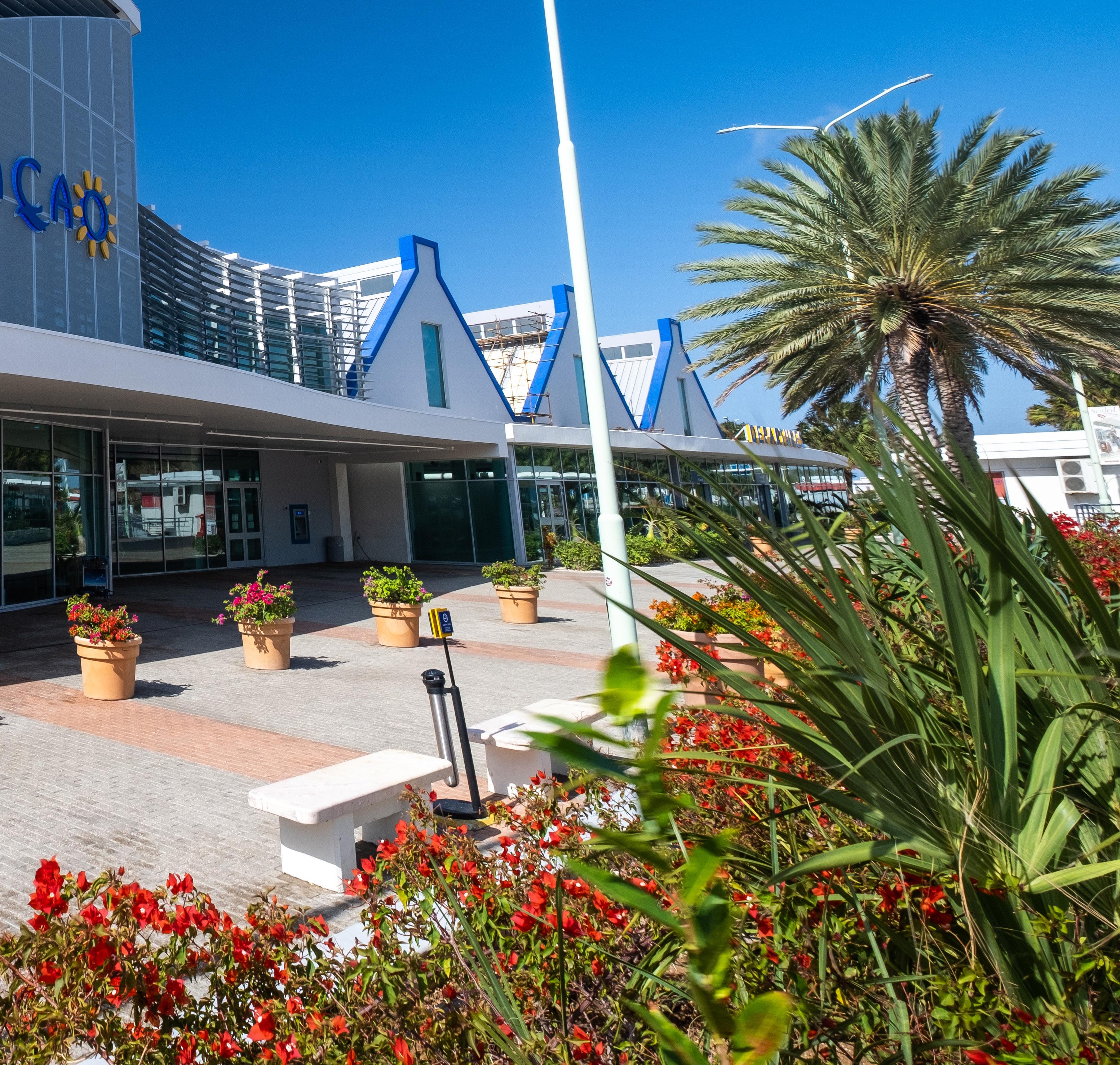
NA: Why should entities invest in Curaçao, and how does CINEX attract investment to the island?
JB: Curaçao offers various investment incentives including favorable corporate tax rates, tax holidays for investment in most businesses, e-zone regimes, preferential access to the EU (OCT) and US (CBI), and zero percent profit tax for intangible assets. Considering these combined benefits, including its vibrant culture and natural beauty, Curaçao is becoming increasingly popular as an investment destination for entities looking for long-term success, and there are many sectors that hold significant investment opportunities on the island.
The tourism and hospitality sector plays a crucial role in the island's economy, with a focus on luxury resorts, cruise tourism, and eco-tourism. Elsewhere, investment opportunities exist in hotel development, resort expansion, recreational facilities, and eco-friendly tourism initiatives. In the finance sector, Curaçao is also a well-established international financial center, providing a range of services, including offshore banking, insurance, trust management, and international trading. Investors can explore opportunities in banking institutions, insurance companies, financial technology (FinTech) start-ups, and support services.
Curaçao's own research showcases the growing information and communication technology (ICT) sector on the island, supported by modern telecommunications (telecoms) infrastructure and a highly skilled workforce. According to this research, various governments around the world, including Anguilla, Dominica, Peru, Ghana, Greenland, Marshall Islands, Samoa, and Vanuatu, are already utilizing software systems developed and supplied by companies in Curaçao. This serves as a testament to the abundant talent available in Curaçao. Investment opportunities are particularly promising in areas such as software development, data centers, information technology (IT) consulting, cybersecurity, e-commerce platforms, and telecoms services.
The island’s advantageous geographic position in the Southern Caribbean makes it a prime hub for logistics and international trade. With its expansive deep-water port, Curaçao offers abundant prospects in shipping, transshipment, warehousing, distribution, and logistics services, catering to the needs of businesses operating in the region. Curaçao boasts two free economic zones and one industrial park, with plans underway to establish an additional industrial park any time soon. Our e-zone regime presents an attractive opportunity for companies seeking to utilize Curaçao as a strategic hub for operations spanning the Americas, Europe, or other global destinations.

Despite its arid climate, Curaçao is also actively promoting agricultural diversification and sustainable farming practices. Investment opportunities exist in hydroponics, aquaponics, organic farming, agroprocessing facilities, and the production of specialty crops for local consumption and export.
NA: Can you tell us about the advantages of Curaçao's location for sustainable business and creative industries?
JB: The country is making significant strides in reducing its reliance on fossil fuels and embracing sustainable energy sources. Currently, 40 percent of Curaçao's energy production is derived from renewable sources, specifically wind and solar power. This achievement marks a substantial milestone in Curaçao's transition towards cleaner energy. Moreover, the nation has set its sights on reaching the 50 percent mark in the near future.
Curaçao's commitment to renewable energy is further exemplified by its recent signing of a Memorandum of Understanding (MoU) with the government of the Netherlands. This collaboration aims to promote the development of renewable energy and facilitate the establishment of offshore wind turbines. By undertaking such initiatives, Curaçao is poised to become a trailblazer in the Caribbean region, leading the way in sustainable energy practices.

“CINEX EMPHASIZES THE IMPORTANCE OF PROMOTING SUSTAINABLE DEVELOPMENT”
-JEANETTE BONET, INTERIM CEO, CINEX
Over the past 38 years, Curoil has evolved from a local fuel distributor to a regional supplier of fuel products and services, with a strong foothold in the Southern Caribbean region. Curoil has fuel operations on the islands of Aruba, Bonaire and Curaçao (The ABC Islands). As the company continues to expand its wings throughout the region, Curoil is committed to maintaining the same high standards that have earned it the reputation of being a reliable fuel supplier in the Caribbean.
At present, the commercialization of fossil fuels remains Curoil’s dayto-day focus, however it acknowledges that the world is transitioning from fossil-based systems to renewable energy sources. Hence, the company continues to invest in research on alternative energy, stimulate the dialogue on environmental laws and contribute to policy change on a local level. Curoil’s aim is to be the preferred choice among the top-rated Caribbean suppliers of energy products and services while creating sustainable value for its stakeholders and the communities in which it operates.
As we navigate the challenges of the 21st century, Curoil is committed to being part of the transformation of the energy sector for a better and more sustainable future. By investing in renewable energy solutions and exploring alternative fuel options, Curoil is setting the stage for a greener and more sustainable future for Curaçao.
STRATEGIC VISION:
After conducting a comprehensive strategic analysis, Curoil has identified three key areas of focus that will shape its path towards a sustainable future:

1. Production of green hydrogen and other energy carriers by offshore floating wind for export
Curoil recognizes the immense potential of green hydrogen and other energy carriers generated through offshore floating wind technology and shares the vision of the government, for Curaçao to become the regional leader in the production and export of green energy.

Looking ahead, Curoil’s participation in this government-led project, which focuses on offshore floating wind technology, highlights the company’s dedication to innovation and research. By actively engaging in this initiative, Curoil aims to advance offshore wind technology and the large-scale production of green hydrogen and
energy carriers, driving progress and accelerating the transition to a sustainable energy landscape in the Caribbean region and connecting to increasing global demand for renewable energy sources.

2. Feedstock import for biodiesel production and export
As part of its commitment to diversifying its energy portfolio, Curoil will prioritize the import of feedstock for biodiesel production. This initiative aligns with Curoil’s dedication to environmental responsibility while simultaneously positioning the company as a leading player in the global biodiesel market.

3. Expansion of wind and solar energy
Recognizing the growing significance of wind and solar energy in the global energy transition, Curoil aims to expand its investments in these renewable sources. Through financing for instance solar solutions, the company seeks to accelerate the adoption of solar energy systems, paving the way for more availability and affordable renewable energy resources. This strategic direction underscores the company’s determination to promote renewable energy and reduce reliance on conventional fossil fuel-based power generation. In addition to these three areas, Curoil is actively exploring other renewable products, such as waste oil processing plants. Also, the company is conducting additional market research to meet the growing demand for E-Methanol in the maritime sector and Sustainable Aviation Fuel (SAF) in the aviation sector.
In conclusion, Curoil’s strategic analysis has laid the foundation for a forward-thinking and sustainable future. Through its focus on green hydrogen, biodiesel production, wind and solar energy expansion, and collaboration with waste oil processing plants, Curoil is poised to significantly impact the energy sector while ensuring environmental responsibility. With these strategic pillars in place, Curoil is leading the way towards a cleaner, greener, and more prosperous tomorrow.
Ideally located at the crossroads of trade routes between South America, the US and Europe, Curinde believes that Curaçao is the prime logistical hub for successful business in the Caribbean
What makes Curaçao one of the most prosperous islands in the Caribbean?
As an autonomous country in the Kingdom of the Netherlands, Curaçao offers a balanced business and leisure environment. Curaçao is considered a politically stable and safe country that offers ISO certified business parks, a good financial sector, state of the art telecommunication infrastructure and a multilingual population, making it a safe place for conducting business.
developer of four business parks in Curaçao, Curinde guides and assists those interested in establishing a company with fast and accurate advice regarding the procedures for incorporating and starting a business in one of its business parks. Its philosophy is to provide the highest quality facilities to businesses on the most competitive terms.

By reaching their objectives, how do trading and production companies contribute to the sustainable economic and social growth of Curaçao?
Free Economic Zone, or the Industrial Zones?
How does Curinde attract, assist and stimulate trading and production companies to reach their objectives?
Curinde is committed to providing professional guidance to investors interested in establishing a company in one of its business parks.
As the managing company and

First, they contribute by creating jobs. People with jobs have spending money, which has a spin-off effect, resulting in more jobs. These employees pay income taxes and social security fees, which means more income for the government and a greater contribution to the social insurance bank. Furthermore, these companies contribute to the country’s foreign exchange reserves. All in all, an increase in export and trading activities will contribute to a sustainable growth of the economy.
What professional seamless support and qualitative facilities does Curinde provide to parties interested in operating in the Curaçao Airport Free Economic Zone, the Curaçao Harbor
Curinde’s team is formed of highly trained specialists who give quick and precise advice about the operations and procedures of the Free Economic Zones and Industrial Zones in terms of compliance with its activities. According to its CEO, Jacqueline Jansen, Curinde’s services reach out as far as referrals to legal, customs and financial advisors, as well as to engineers, specialists and technicians. The guidance that Curinde offers is complimentary. In addition, Curinde has access to an extensive network of international organizations of which it is a member, including the Free Trade Zones Association of the Americas (AZFA), the World Free Zones Organization (WFZO), and the World Association of Investment Promotion Agencies (WAIPA).
Why does Curinde believe that Curaçao is the prime logistical hub for successful business in the Caribbean?
There are some key factors that play a role:
1. The strategic location of Curaçao; it is ideally located at the crossroads of trade routes between South America, the US and Europe.
2. Curaçao is an autonomous country within the Kingdom of the Netherlands.

3. Curaçao is a politically stable country.
4. Daily connections to the Caribbean, North and South America, and Europe.
5. ISO-certified business parks with 24/7 security, offering a secure and safe environment where business can be conducted at ease.
6. Attractive incentives are offered by the government to businesses established in the Free Economic Zone: zero percent import duties and zero percent sales tax.
7. Good financial sector with a reliable banking sector, and the fact that the Guilder is pegged to the US Dollar.
8. Multilingual population that is able to communicate in four languages.
9. State of the art telecommunications infrastructure with a Tier IV Data Center.
10. Curaçao lies conveniently outside the hurricane belt.
How will Curinde achieve its vision of being an internationally recognized facilitator of international production and trade of highvalue goods by 2030?
By creating more alliances with other entities and Free Zones around the world that can be a significant partner for Curinde and Curaçao, which in turn will benefit the companies established in Curinde’s business parks.

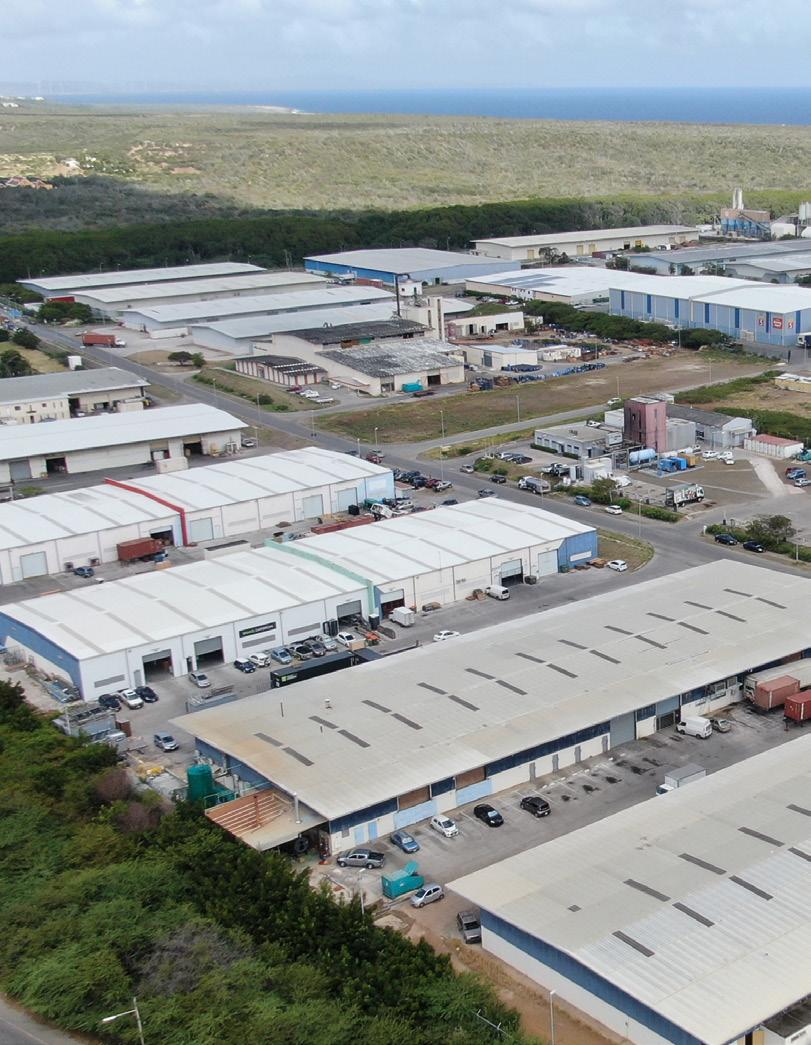
Curinde’s focus will also be on client satisfaction, which will result in attracting more investors to establish in one of its business parks.
Curinde believes that it is of utmost importance to develop business parks that offer:
• Excellent service by
stakeholders involved in the logistic chain
• Diversification of activities
• Continue doing promotional activities, especially in the region in combination with the use of Curinde’s international contacts.
• E-commerce activities which are the new trend of doing business.
For more information:
E: info@curinde.com
W: www.curinde.com
Through these efforts, Curaçao is not only reducing its carbon footprint but also fostering a more environmentally conscious and resilient energy infrastructure. This transition towards sustainable energy sources reflects the island's dedication to mitigating the adverse effects of climate change and creating a greener future for its residents and the wider Caribbean community.
Investment opportunities exist in renewable energy projects such as solar, wind, and wave energy, as well as energy-efficient technologies, green infrastructure development, and waste management.
Additionally, the island possesses a vibrant artistic and cultural scene, making the creative industries sector a potential area for investment. This includes film production, music, design, fashion, advertising, and the development of creative spaces and events.


Curaçao is home to several reputable educational institutions, attracting students from around the world. Investing in the expansion of educational facilities, vocational training programs, and specialized courses can cater to the growing demand for quality education and skill development.

The Curaçao Ports Authority manages all ports in Curaçao ensuring development, quality nauucal services, safety and security in the ports in an environmentally responsible manner. With modern infrastructure and the experienced port cluster, the ports of Curaçao offer mariume and logisucal service excellence.
Investing in a foreign country can be a daunting task and comes with its own set of risks.
But what if we told you that there is a way to ensure that your investment remains safe and secure? Look no further than Curaçao!
By investing through Curaçao, you will have access to industry-leading help to properly structure your investment and protect it from political risk. This means that you won’t have to worry about the unjust revocation of your license, harmful unexpected changes in the law, or even disguised or outright expropriation of your assets. This will guarantee that you receive fair and equitable treatment in a court of law.
Curaçao is known for having strong regulations and laws regarding traditional trusts and private foundations. This, paired with an impressive list of bilateral investment protection treaties, makes it the perfect destination for your investment. Trust us, Sadekya always takes these factors into consideration when structuring the financial affairs of our valued clients.

So if you want advice you can trust and an investment that is truly protected, choose Curaçao. Don’t let political risks come between you and your investment.
www.sadekya.com

Invest through Curaçao and let us help you secure your investment.

NA: Can you tell us about any recent milestones CINEX has celebrated?
JB: Recently, the government signed an MoU with Proteus Ocean Group. This collaboration aims to develop the world's first underwater research habitat of its kind, with Mr. Fabian Cousteau, the grandchild of the late famous Jacques Cousteau, leading the project. This will put Curaçao at the forefront of the blue bioeconomy and technology spheres.
The renowned and exclusive luxury hotel, Sandals, opened in Curaçao in 2022. This project has been in the works for a long time and has successfully attracted a niche group of tourists to the island that we wanted and will continue to target in the future, promoting Curaçao as a luxury destination.
Thanks to its aforementioned benefits and incentives, Curaçao has caught the attention of many business process outsourcing (BPO) companies over the years. This year, Concentrix, a prominent company in the field, established its presence in Curaçao, creating numerous job opportunities.
Furthermore, there are several upcoming investments in the hospitality, IT, and sustainable energy sectors scheduled for the next year. These investments will put Curaçao on the map for potential investors.
NA: How has the promotion of Curaçao been impacted by increasing digitalization?
JB: We found that the shift towards an increasingly digital environment has presented both challenges

“WE ASPIRE TO BE THE LEADING AND RELIABLE DIGITAL HUB FOR THE AMERICAS”
-JEANETTE BONET, INTERIM CEO, CINEX
and opportunities for the promotion of our island as a destination for foreign investors.
On one hand, challenges arise from the abundance of information available online, making it more difficult for specific destinations to stand out and capture the attention of potential investors. At CINEX, this difficulty has necessitated a change in our approach to promoting and selling Curaçao. We are currently in the process of gradually implementing this new approach with the support of our marketing department and external experts.
On the other hand, the digital environment also presents significant opportunities. With the use of data-driven strategies, we are able to reach a larger portion of our target audience simultaneously. By leveraging data and analytics, we can identify the right audience segments
and tailor our promotional efforts to their specific needs and interests. This allows us to maximize the impact of our marketing campaigns and increase our chances of attracting foreign investors to Curaçao.

Furthermore, the digital landscape provides us with various online tools that enable us to effectively engage with potential investors. Through social media platforms like Instagram, Facebook, Twitter, and LinkedIn, we can showcase Curaçao's business-friendly environment and investment opportunities through engaging and highquality content. These platforms not only provide us with a wider reach but also facilitate direct communication and interaction with potential investors, allowing us to share valuable information and build relationships more easily.
This year, Curaçao will be introducing the Digital Hub Americas (DHA) platform during the CANTO 2023 conference, aiming to officially establish Curaçao as the go-to solution for all ICT endeavors.

We aspire to be the leading and reliable digital hub for the Americas. To achieve this, DHA aims to empower businesses in co-creating solutions at a local level while facilitating global delivery. Situated in the Caribbean as part of the Dutch Kingdom, and with our advantageous legislation, central location that minimizes the risk of natural disasters, and a multilingual population that
 URBAN DESIGN Sustainability
We design neighborhoods, not bricks and pavement. We design new ways of living. Literally green, local, and adapted to the weather conditions of the island, we create that place to connect, with each other, with your inner soul and with nature.
ARCHITECTURE Creative ideas We consider architecture as the built concept that is an answer to different problems. Architecture is more than a shelter, it is the experience, what you can touch, visualize, imagine and how it makes you feel.
INTERIOR DESIGN Creating ethos
The environment we reside in, has to make us feel safe, inspire us to get the most out of our brains, inspire us to create, to relax, to share the moments, to enrich our experience. The space we create will create us.
CONSULTANCY Creating a resilient environment for everyone Having worked as a policy maker at the Ministry of Traffic, Transport and Urban Development, we understand the tension between public interest, developers and economic factors and know how to come to resilient and sustainable win-win solutions.
ZARJA@ZARJA.NET | 599-9-519-2173 | ZARJA.NET | |
URBAN DESIGN Sustainability
We design neighborhoods, not bricks and pavement. We design new ways of living. Literally green, local, and adapted to the weather conditions of the island, we create that place to connect, with each other, with your inner soul and with nature.
ARCHITECTURE Creative ideas We consider architecture as the built concept that is an answer to different problems. Architecture is more than a shelter, it is the experience, what you can touch, visualize, imagine and how it makes you feel.
INTERIOR DESIGN Creating ethos
The environment we reside in, has to make us feel safe, inspire us to get the most out of our brains, inspire us to create, to relax, to share the moments, to enrich our experience. The space we create will create us.
CONSULTANCY Creating a resilient environment for everyone Having worked as a policy maker at the Ministry of Traffic, Transport and Urban Development, we understand the tension between public interest, developers and economic factors and know how to come to resilient and sustainable win-win solutions.
ZARJA@ZARJA.NET | 599-9-519-2173 | ZARJA.NET | |
facilitates communication, we truly serve as a gateway to the Americas and Europe.
The sector and its active participants acknowledge the immense potential present on the island and recognize the significance of highlighting Curaçao's importance in this regard. Through this platform, we aim to promote Curaçao as a hub for innovation, technology, and cutting-edge ICT services.
NA: Are there any key internal investments or developments you would like to highlight?
JB: In 2019, Curaçao embarked on a project to develop a national export strategy (NES), with a primary focus on seven distinct sectors revolving around technology and electronic government. The NES vision reflects the country’s ambition to transform its economy into
one that is driven by entrepreneurship, efficiency, costeffectiveness, quality, and innovation. The strategy focuses on transforming the economic makeup of the country by upgrading and creating new value chains, particularly in service exports. As a result, the forthcoming five years will prioritize attracting investments for these sectors and recognizing that investment is a prerequisite for successful exports. These sectors include the blue bioeconomy, creative industries, IT services, financial services, and port and maritime services. Presently two additional strategies are in the making, one for the health tourism sector and renewable energy.
Curaçao offers a distinct work-life balance. In 2020, another project called @HomeinCuraçao was launched. The government of Curaçao provides an opportunity for remote workers who hold Dutch or US citizenship to live and work on the island for an extended period. To take

advantage of this opportunity, all you need to do is request a judicial declaration through the provided link. Nowadays if you are not a Dutch or US citizen, but still desire to reside and work in Curaçao, you can find the conditions and registration details by visiting the website. So, while staying connected to your colleagues and workplace during the day, the lively island provides ample opportunities for relaxation and rejuvenation whenever you need a break from your desk. Curaçao is renowned for its multicultural community, ensuring there is always a place for you. With a wide range of workspaces you can relate to other remote workers and immerse yourself in the culture by engaging with the community, Curaçao has it all. Moreover, regardless of whether you speak Dutch, Spanish, English, or Papiamentu, you will always feel at home. For additional information, please visit www. athomeincuracao.com

JB: Since we’ve been in the industry for almost a decade, we have seen tremendous growth. In this sense, we aim to keep growing and creating more investment opportunities in Curaçao. This is also done by expanding our services to provide potential clients with the best possible solutions. As the investment landscape continues to evolve, CINEX wants to stay ahead of the curve by keeping up to date with the latest trends in investment promotion, which includes exploring innovative technologies and developing new strategies for marketing and customer acquisition. Moreover, CINEX is committed to providing quality customer service that ensures clients receive the highest level of satisfaction when working with them.

The future of investment promotion is looking bright for CINEX as we continue to strive toward our goals. With our focus on providing top-notch services and support for foreign investors, we aspire to become a leader in the field of investment promotion in Curaçao. Thus, going forward, we can expect CINEX to continue expanding its services and offerings to meet the ever-evolving needs of investors around the world.
Let us help you fulfill your investment and export dreams!


Canada’s Wonderland has been creating memorable thrills for over 40 years. We speak to Phil Liggett, Vice President and General Manager, about dedication to family fun and the park’s latest investments

Writer: Marcus Kääpä | Project Manager: Callam Waller
Canada is a source of natural and cultural wonder, boasting landscapes that are equally dramatic and beautiful, and large enough to find true adventure amid forests, lakes and mountainous rises. But the marvels don’t cease there. Canada is a hub of monumental celebration, with festivals being held throughout the year and amusement parks for all the family available across the country.
The largest of these is Canada’s Wonderland; located in Vaughan, Ontario, the country’s premier amusement park features more than 200 attractions, including two children’s areas and 18 roller coasters, one of which is the world recordbreaking dive coaster, Yukon Striker.
New for 2023, is the one-of-akind thrill ride Tundra Twister and the family launch coaster Snoopy’s Racing Railway. The park also features a 20-acre water park with Canada’s largest outdoor wave pool, 17 water slides, exhilarating cliff jumping, water playgrounds and more.
The four-season amusement park also hosts world-class entertainment, live shows and special events including Camp Spooky, Halloween Haunt and the immersive holiday event WinterFest. The park is situated on approximately 300 acres and is one of 11 amusement parks owned and operated by Cedar Fair Entertainment Company.
Its key products include daily
admission tickets and three-tiers of Season Pass - Platinum, Gold and Regular – plus add-on products such as dining plans, drink plans and fast lane passes.
“Since 1981, Canada’s Wonderland has been the premier destination in Ontario for thrills, family fun, and world-class entertainment,” begins
 Phil Liggett, Vice President and General Manager of the park.
Phil Liggett, Vice President and General Manager of the park.
“The smooth running of the amusement park comes down to our 150 dedicated full-time staff and the substantial number of seasonal staff, approximately 4,000, through the operating season which runs from late April to the end of December





Marvin Candy & Displays was incorporated in 1990 and has been developing and servicing high volume confectionery programs since that time. Today we are the largest marketer of confectionery products within the Fun and Leisure sector in Canada. We are the exclusive Canadian distributor for Pucker Powder products and authorized distributor for many industry leading brands. Our knowledge of equipment, products and positioning is gained by having a hands-on approach. This allows us to maximize sales and profits for our customers. We develop confectionery programs that have a proven success record. Add custom equipment and graphics, the result is a perfect marketing solution. Marvin Candy & Displays conducts business across Canada and in several US states. Our broad customer base covers all areas of the Fun and Leisure sector including: candy stores, water parks, zoos, museums, science centers, amusement facilities, ski resorts and theme parks. Our nationwide programs and fixtures are exposed to millions of visitors annually.









each year. These are the people at the heart of the process who ensure the happiness of everyone who visits!”
People are the focus of Canada’s Wonderland. For Liggett, customer experience, operational excellence and employee well-being stand above all else. In light of this, Canada’s Wonderland is continuously evolving its people-centric offerings, the latest of which is the highly popular Lazy Bear Lodge.
“Lazy Bear Lodge is the largest dining facility in the park and represents the most significant investment we’ve made in food and beverage since Canada’s Wonderland opened in 1981,” Liggett tells us. “It’s one of the latest additions to our growing Canadian-themed collection of venues and attractions, with two levels, a sprawling stone patio with an amazing view of our fireworks show, and seating for 500 guests.
“Its gourmet menu of smoked brisket, barbecue chicken and

healthy vegetarian options supports our ongoing efforts to elevate our amusement park dining experience. We’re not just about hot dogs and pizza. We’ve developed a diverse offering of locally sourced, quality food and drink items that cater to the increasingly sophisticated preferences of our park guests.”
Thus far, the response to the Lazy Bear Lodge, its architecture, the menu and the speed of service has been very positive as it helps Canada’s Wonderland deliver a memorable dining experience.


Canada’s Wonderland is a place dedicated to creating fun and great memories in a safe environment. For the park’s management and teams, it is the unique experiences the park offers, and the fostering of fun for friends and families, that drive passion to deliver.
“The smile on a child’s face as they experience their first ride; the terrified screams of friends as they encounter the first drop on a roller coaster; taking family photos with Snoopy or Charlie Brown after ice skating under
“SINCE 1981, CANADA’S WONDERLAND HAS BEEN THE PREMIER DESTINATION IN ONTARIO FOR THRILLS, FAMILY FUN, AND WORLD-CLASS ENTERTAINMENT”
– PHIL LIGGETT, VICE PRESIDENT AND GENERAL MANAGER, CANADA’S WONDERLAND


NORTH AMERICA OUTLOOK: CAN YOU TELL US ABOUT YOUR CAREER TO DATE AND YOUR INTRODUCTION INTO THE AMUSEMENT PARK SPACE?
PHIL LIGGETT, VICE PRESIDENT AND GENERAL MANAGER:
“I started my career in the amusement park industry 40 years ago when I joined Canada’s Wonderland as a seasonal supervisor in food and beverage. Prior to that, I had been working in a few different restaurants and eventually became aware of opportunities for students in supervisory and leadership roles at the park.
“The size of the park operation, the team and the fun atmosphere were all compelling factors in applying at the park and reasons I have never wanted to do anything else. I worked at the park from 1984 through 2006 in a variety of roles and disciplines including food and beverage, park operations and human resources. After that, I was fortunate enough to hold General Manager roles at several other amusement parks in the US and Canada before returning to my true home park –Canada’s Wonderland, in January of this year. This is truly a great business and re-joining the team here as General Manager has been a highlight of my career.”
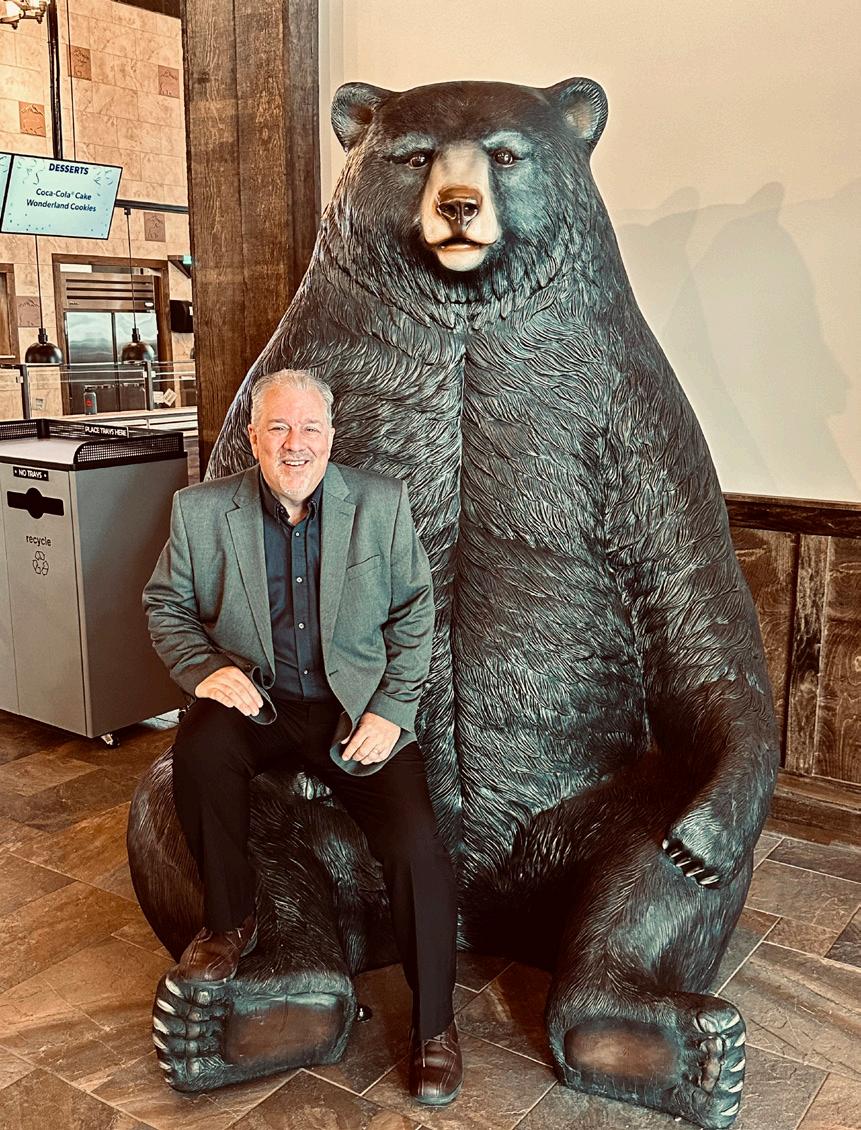
enjoying our classic strawberry funnel cake at the end of the day – these are only some of the unique experiences the park offers,” Liggett tells us fondly. “Helping to create that fun and those memories is the best part of what we do at the park every day.”
Each year, it is the management teams at Canada’s Wonderland that implement developments designed to attract customers, create thrills and produce that “wow” factor.
offer both a new thrill ride and a new family ride in the same season to cater to the interests of different guest demographics,” Liggett continues. “We’ve had the chance to do this a few times in the last decade and guests always respond well.”
One such development is the park’s all-new Tundra Twister, a thrill ride in the Frontier Canada section of the park. This consists of a giant swinging pendulum that takes
BIG THRILLS – Canada’s Wonderland is home to the most exhilarating collection of rides and coasters in North America! Scream your face off on Leviathan, Behemoth and the world recordbreaking dive coaster, Yukon Striker.


KID’S AREA – Featuring two familyfriendly areas, KidZville and Planet Snoopy, kids will enjoy more than 25 rides and attractions, plus meet and greets with Snoopy, Charlie Brown and the rest of the Peanuts gang!
FOUR SEASONS – There is plenty to see and do for guests of all ages through the spring, summer, fall and winter at Canada’s premier amusement park.
LIVE ENTERTAINMENT – Enjoy world-class live shows like Ultimate Thrill Circus, Fall Out Stunt Dive Show, dance parties with the Peanuts gang, and more!
SPLASH WORKS – 20 acres of refreshing summer fun including slides, water playgrounds, a lazy river, wave pool and exhilarating cliff jumping at Mountain Bay Cliffs!
guests 360 degrees, upside down to heights of 47 meters and speeds of up to 75 kilometers per hour (kph). The gondola seats fit 40 people and rotates spontaneously, which delivers a unique ride experience every time. It is a prototype designed by Mondial, a rides manufacturer in the Netherlands, which makes it the only one of its kind in the world.
Another key attraction is the highly popular Snoopy’s Racing Railway, the park’s 18th roller coaster and the
newest addition to Planet Snoopy, one of the children’s areas. This ride is a family launch roller coaster built by ART Engineering, accelerating from zero to 50kph in a matter of seconds before taking guests through the dips and turns of a wild railway adventure.
“Snoopy’s Racing Railway is a great addition for kids and families. It can accommodate guests as small as 36 inches tall (three feet), so we’re excited for our youngest thrill seekers who may find Snoopy’s Racing Railway to be their very first roller coaster experience,” Liggett shares.
Snoopy’s Racing Railway is a perfect example of Canada’s Wonderland diversifying its offers to cater to a wider customer base. This diversification of the guest experience is critical to ensuring that there is something for everybody when they visit the park.


“We have great thrill rides and exciting roller coasters, but we also provide great experiences for families with our children’s areas and 20 acre water park,” Liggett explains. “In addition to this, we have a full line-up of world-class events and live entertainment throughout the year, including cirque-style shows, international food festivals and special events like the week-long Celebration Canada and KidZfest with popular TV characters and Marvel superhero meet and greets. This keeps our entertainment offerings fresh and gives guests – particularly our Season Passholders – a reason to visit often.”

In the fall, Canada’s Wonderland features a daytime Halloween program for children on weekends called Camp Spooky, and at night Halloween Haunt thrills the park’s older guests with monsters, haunted mazes and sinister shows. The fun continues in November and December with the park’s immersive holiday event WinterFest, featuring millions of lights, ice skating, festive

food, holiday shows and interactive family experiences.

While open through all four seasons, Canada’s Wonderland sees its busiest time during the summer months when schools in Ontario gain leave during July and August. Annually, the park hires for thousands of seasonal positions across all departments, with recruitment efforts beginning as early as January. These seasonal associates play a vital role in the park’s mission delivering amazing experiences to all guests, and Canada’s Wonderland offers highly competitive wages, amazing perks and an opportunity to make lifelong friends and develop essential leadership skills to help build future

careers for all those who join.
This people-centric skills development and experience is just one of the park’s continuous aims, with future goals also enveloping multi-faceted business objectives.
“We have revenue and attendance targets but our success in meeting them depends heavily on our attention to certain key areas. These include guest satisfaction, the expansion of entertainment and attraction offerings, and ensuring awareness to emerging demographics,” Liggett concludes.
“Our Season Passholder base is an important part of our business, so we make sure to add substantive value to those passes each year, through
expanded perks programs, exciting new rides and events to give those guests plenty of things to do.
“We’re a four-season park and want to give customers great reasons to visit all year long!”

Tires distributed by Canada Tire Inc have been providing value to customers for almost a century. CEO, Gabriel Granatstein, details the company’s dedication to distribution, its team and its values
Writer: Jack Salter | Project Manager: Callam Waller

The consolidation of Canada’s tire industry has seen many local and regional distributors rolled up into larger national players.
However, one regional distributor that has proudly stood the test of time – 95 years to be exact – and played a major role in shaping the industry, is Canada Tire Inc (Canada Tire).
Gabriel Granatstein, CEO, along with his brother-in-law, Director of Sales, Chris Moody, represents the fourth generation of the family business, which was founded in 1928 by his great grandfather, Louis Wiseman.
“The average life-span of a family business is 24 years and only three percent make it to the fourth generation, so it’s amazing that we’ve made it this far, and it’s only because of the work done by the generations before us,” opens Granatstein, who has now been with the company for more than seven years following a varied career in retail, the military and law.
By the 1980s, Canada Tire had pivoted from a retail chain of tire shops to B2B distribution, developing a reputation for value-priced tires in Central and Eastern Canada.
Each generation of the family has brought a new vision and a shift in focus, the latest of which now sees the company distribute tires to customers multiple times a day in major metropolitan areas, focusing heavily on cutting-edge marketing and technology to amplify its personalized approach to service.

“Whereas customers for the most part used to order tires in bulk, there’s now many more stock keeping units (SKUs) as customers are less willing to take a lot of inventory, so we have to be a lot more
refined to make sure we have stock in the right place, at the right time, at the right price,” Granatstein outlines.
“We like to work with local carriers that we know will go above and beyond, and take pride in their work. This creates a situation where each of our distribution centers has a slightly different makeup for delivery, but always with the end goal of providing the best service possible.”
Canada Tire today has a total of seven distribution centers – three in Québec (Salaberry-de-Valleyfield, Sherbrooke, Levis), three in Atlantic Canada (Moncton, Dartmouth, Mount Pearl), and one in Ontario (Mississauga).
The company recently relocated to its brand-new distribution center in Salaberry-de-Valleyfield, which was opened in July 2021 and is now its largest facility.

Spanning more than 110,000 feet, it is almost twice the size of the company’s previous main distribution center in Montréal.
“We were running out of room and needed more space, so we took the risk of opening a new main distribution center during the COVID19 pandemic,” shares Granatstein.
“It has worked out really well, and we’ve been fortunate for a number of reasons. You had to bring in a lot of products early and have the space to store it during the pandemic, so we were lucky enough to have that space and it really helped to sustain us when the supply chain was difficult to manage.”
Through its distribution centers, the company serves key clients in the vast majority of urban locations in Eastern
Canada, namely independent garages, car dealers, fleets, rental car companies, and online vendors.
This expansive footprint is complemented by a retail store in Montréal that serves as a showcase of Canada Tire’s products.
A wide selection of passenger, performance, SUV, and light truck tires are stocked by Canada Tire, whose core mission is to distribute unique brands that maximize
profitability.
The company therefore differentiates itself by concentrating entirely on Tier 2 and Tier 3 products, and choosing underrepresented tire brands that the competition doesn’t focus on.
“We find that when we do this, there’s a place for all of us in the market because we provide value that our competitors don’t, which has translated into where we are today,” Granatstein tells us.
“For example, Groupe Touchette is Canada’s largest tire distributor and they do an amazing job, but they focus on a specific tier of products which has allowed us to really establish Canada Tire in our segments.”
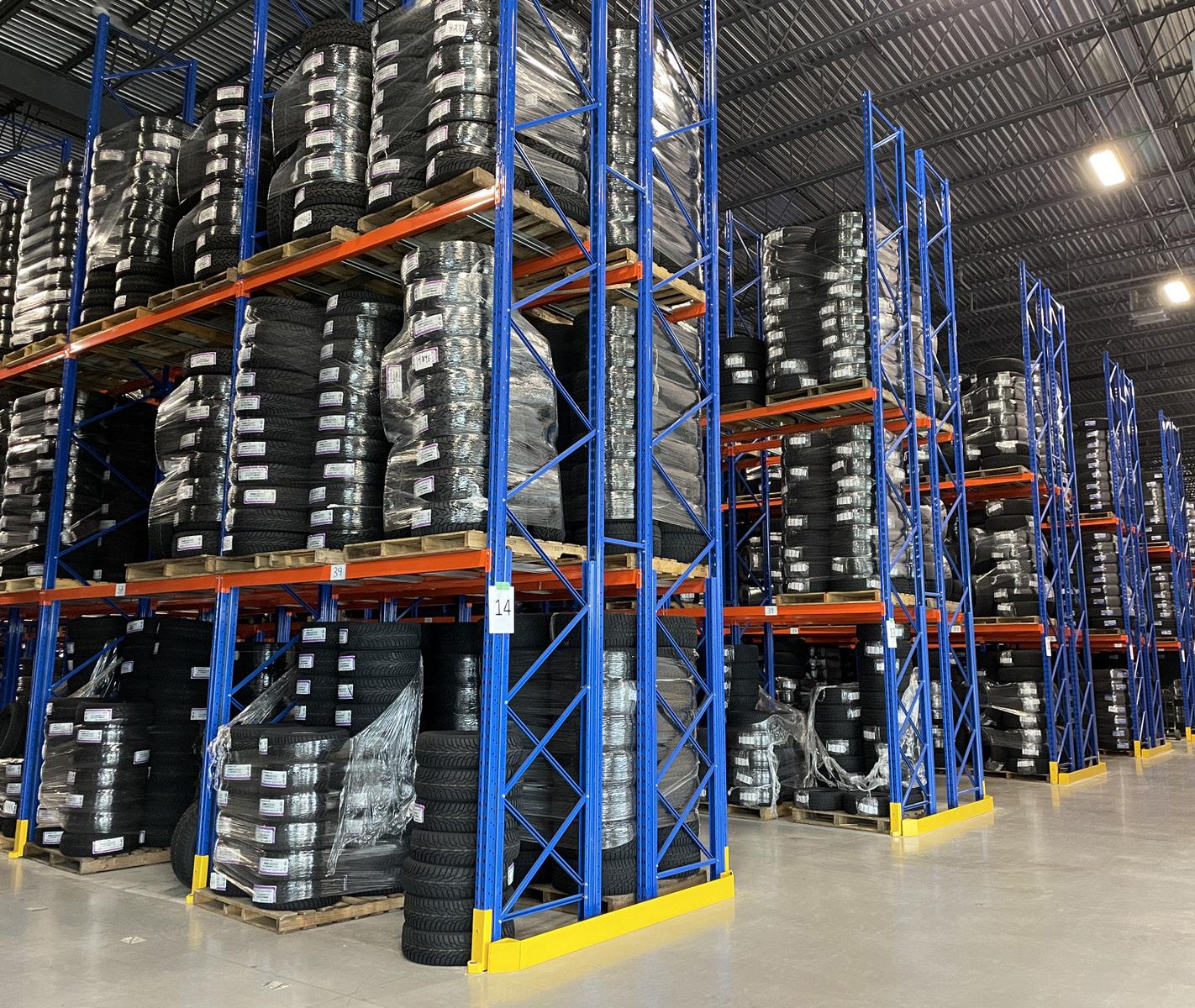
Under Gabriel’s father, Billy Granatstein, grandfather, Jack Granatstein, and uncles Sam and Philip Wiseman, Canada Tire was the first to bring in high-quality, value
tire brands from China and South Korea, where the company continues to import the vast majority of its products by container.
That brings with it benefits but also challenges, which reared their heads during the pandemic when global supply chains were heavily impacted.
“We went from using one freight forwarder to 15, so handling the cash flow implications of that in terms of fuel and ocean freight rates was a very interesting challenge that thankfully we overcame and were able to use to our benefit, but it’s constantly changing,” observes Granatstein.
“I think our size allows us to react quicker than the competition, and the fact we are in charge of importing most of our own products for the most part gives us that additional flexibility that others don’t have.”
One of the freight forwarders who stepped up for Canada Tire during the pandemic was Cargolution, who helped to manage the company’s supply chain issues. According to Granatstein, Cargolution “stepped into the breach” and has been a valued partner since.
As well as providing value with its wide range of tires, Canada Tire’s flexibility means that it is very responsive to customer needs.
“When you’re a regional player like us, you have the ability to remain close to your customers, directly
“THERE’S A PLACE FOR ALL OF US IN THE MARKET BECAUSE WE PROVIDE VALUE THAT OUR COMPETITORS DON’T, WHICH HAS TRANSLATED INTO WHERE WE ARE TODAY”
– GABRIEL GRANATSTEIN, CEO, CANADA TIRE INC
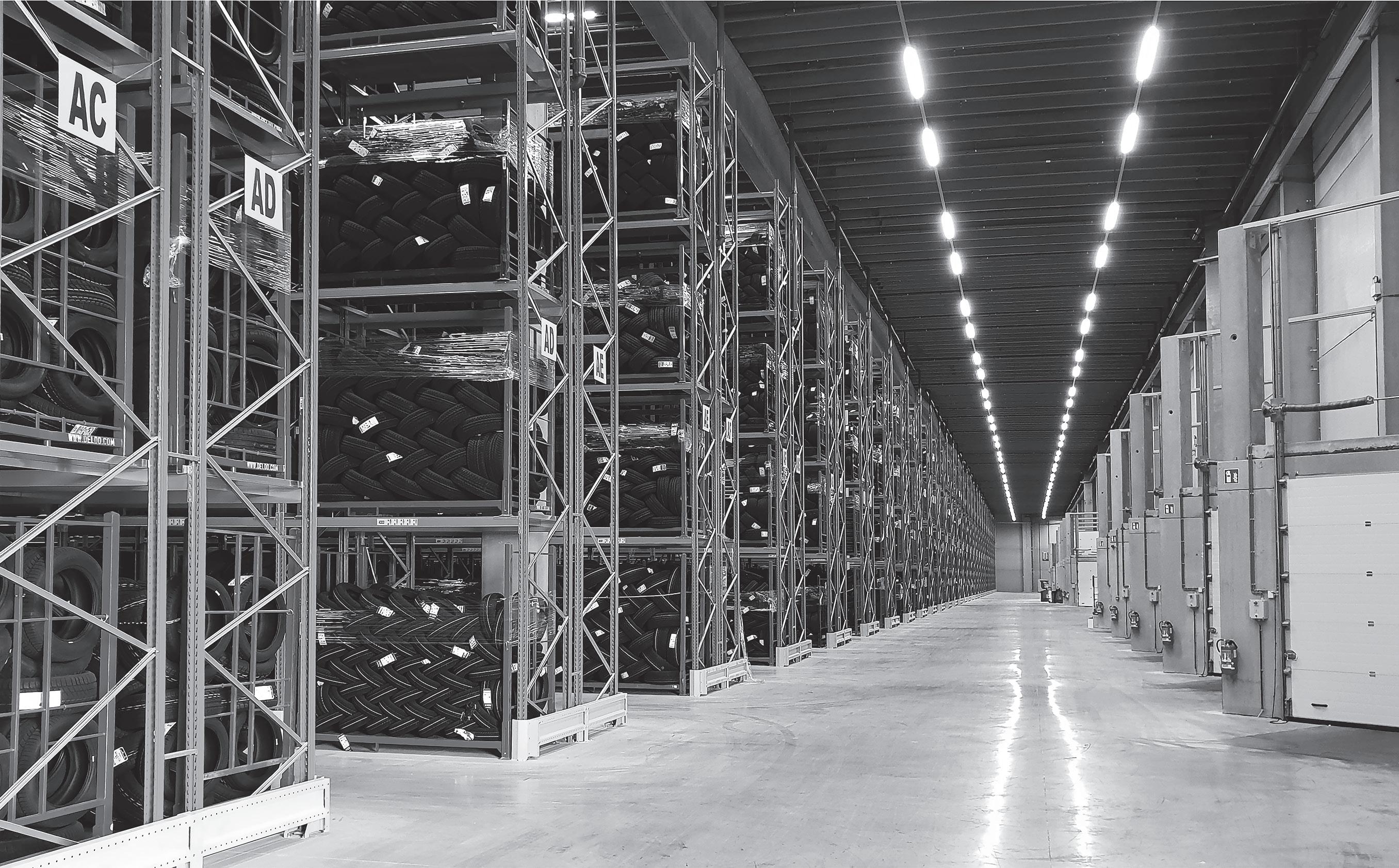





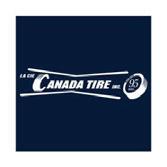









communicate with them, respond to their needs, and create solutions to the problems they have,” says Granatstein.
“Ultimately, it’s not always about the tires, but problem solving – it may be that the customer needs a particular brand or service we provide that the competition doesn’t. People do business with us because we’re easy to do business with, and we help them become more profitable.”
With the company adding Maxtrek to its portfolio of brands this year, Canada Tire’s range of tires will offer


“IT’S AMAZING THAT WE’VE MADE IT THIS FAR, AND IT’S ONLY BECAUSE OF THE WORK DONE BY THE GENERATIONS BEFORE US”
– GABRIEL GRANATSTEIN, CEO, CANADA TIRE INC
more choice for customers than ever.
“We don’t launch new brands often as we’re committed to our suppliers, so that’s a big deal for us and we’re excited about that. It’s a line of tires that will provide great value for our customers,” Granatstein informs us.

“We’ve partnered with many of our suppliers for decades, including Deldo, who provides us with the Minerva brand of tires. I would also include Macpek in the same bracket, as we have a deep partnership with them and are proud to sell their products.
“This is another new partnership for us and one we feel is based on shared values – something of key importance to us in selected new partners,” he adds.

Canada Tire is proud of its history, and the fact that many team members have been working at the company for several decades.

“It’s quite rare now to have the type
of employees that we have at Canada Tire, and it’s something that I’m really proud of,” smiles Granatstein.
“We have employees who have been with us for more than 30, 40, and even 50 years, and that comes with a lot of strengths. Having people who know the business inside out is incredibly helpful, and their ability to adapt to new ways of working has been wonderful and constantly impressed me.
“We are only as good as the team that we have, and our team is extraordinarily committed to the company.”
Canada Tire is equally committed to corporate social responsibility (CSR) and supports charities that are close to its employees and customers.
Likewise, employees have the support of Canada Tire if and when they need it, whether that’s in the form of time off, financial support or education.
“I think it’s the sense of commitment that we have to each other that helps
to keep people at the company.”
This reflects the purpose that Canada Tire lives and operates by, which is to sell tires and wheels profitably – to provide a better life for its team members and partners.
“Making profit is fundamentally important, but profit is not the end goal itself – it’s a means of measuring our success and investing in our business and ourselves,” concludes Granatstein.
In that vein, Canada Tire launched a company-wide profit sharing program in 2023 that ensures when the company does well, all employees share in that success.


proudly serves Alaska, Hawaii, the US West Coast, and the burgeoning offshore wind industry on the Eastern seaboard.
the world, giving the company an international presence.
Consisting of five operating companies, and a recently opened terminal in New Bedford, Massachusetts, Saltchuk Marine
Additionally, the project services team works with customers all over the globe, and a fleet of over 100 Saltchuk Marine vessels operate in oceans, rivers, and ports around
The services provided by Saltchuk Marine would not be possible without its family of companies, and one of the oldest and most iconic of those is the tug company, Foss Maritime. In turn, Saltchuk Resources, the parent company of Saltchuk Marine, acquired
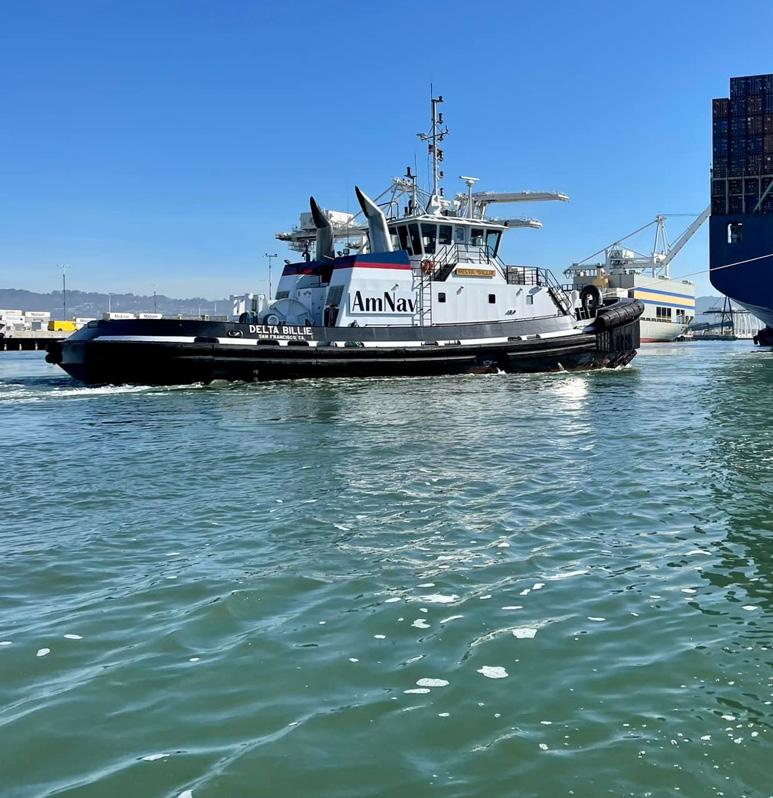
Here at Saltchuk Marine, we have the right resources, the exemplary people and the experience to be the best operator in our chosen markets.”
AmNav, Young Brothers, Cook Inlet Tug and Barge (CITB), and Starlight Marine, all between 1997 and 2020.
“Saltchuk Resources is an acquisitive holding company with many diverse brands including TOTE, Tropical Shipping, Carlile, Aloha Air Cargo, Hawaiian Petroleum, and many others,” outlines Jason Childs, President and CEO of Saltchuk Marine and orator of the opening statement.
Prior to his current position, Childs worked for an aerospace and technology company, where the organizational structure was similar to Saltchuk Marine.
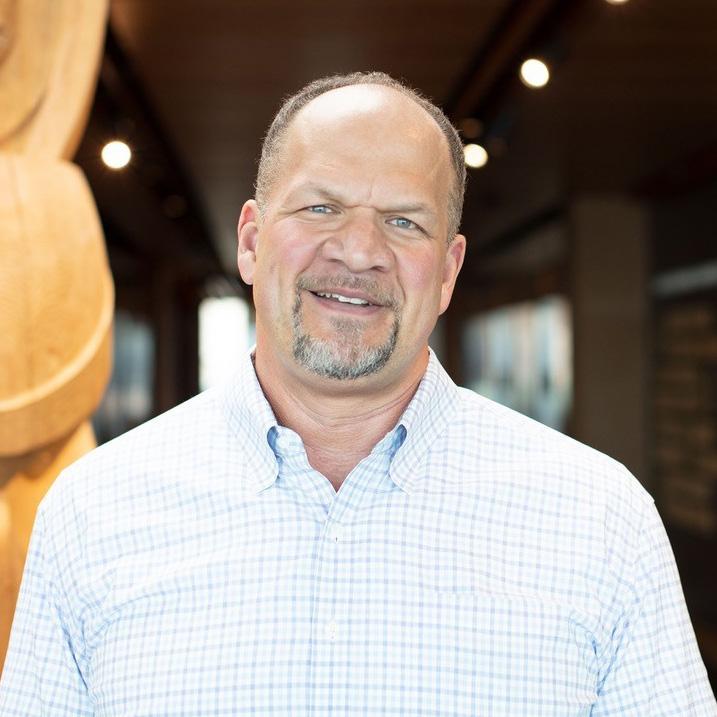
“Saltchuk Marine presented me with an opportunity to work with a great team of experienced maritime professionals while bringing innovations from the aerospace industry,” he reveals. “It is a complex blend of businesses and I love the challenge.”
Childs currently oversees Foss Maritime, AmNav, CITB, Young Brothers and Foss Offshore Wind, which includes the New Bedford Foss Marine Terminal.
Although the maritime environment is challenging, and safety is always the number one objective, Saltchuk Marine strives to create a culture where people are valued, respected and safe.

Proudly serving the US with a reliable fleet of seafaring vessels, we speak to Jason Childs, President and CEO of Saltchuk Marine about its versatile and responsive maritime services
JT Marine Inc (JTM) is a full-service shipyard in the Portland/Vancouver region. Proud to be family owned and operated since 2007, JTM has been consistently providing quality new construction, steel fabrication, vessel retrofits and ship repair services to the marine community ever since. The company now offers a vast range of shipyard options and marine services for its clients’ vessel repair, construction and design needs, existing as a highly flexible and efficient solutions provider. Now steeped in more than 80 years of combined shipbuilding, marine shipyard services, and repair experience, whilst being conveniently located on the Columbia River in Vancouver, WA, JTM offers an ideal, complete service location for major retrofits and vessel repair.
Possessing its own covered fabrications bays outfitted with overhead cranes, and its assembly locations alongside a 1200-ton dry dock, JTM is thoroughly equipped to handle whatever job its clients need, big or small, and the company now performs work all over the Northwest.
Boasting decades of experience in shipbuilding and marine work throughout the entirety of the West Coast, from a client’s first
call to the final sign-off on our work, JTM offers an excellent customer service experience. When asking the question, what makes JTM the company to choose, the answer remains that the company has the specialists its clients require when looking to deliver a project safely and with the highest quality, on time, every time.
Customer-centric and detail-orientated, JTM combines generations of unrivalled experience with modern and innovative production methods to deliver high quality products with unparalleled service.

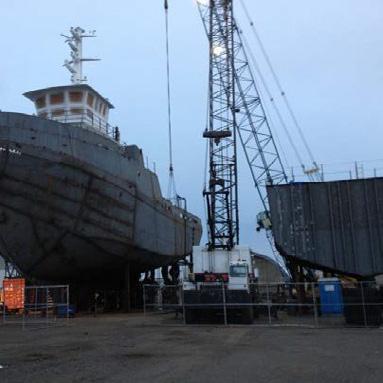

At JTM, the company strives to bring quality vessel repair at fair and balanced pricing to its many customers. With its 1,200-ton lifting capacity dry dock, expansive pier and shoreside buildways, the company now offers the capability and qualified personnel to achieve all its clients’ marine vessel needs. Whether they are in need of USCG Subchapter M compliance dry docking, or a complex tugboat conversion, JTM is always the answer.
JTM’s vastly knowledgeable shipyard craftsmen provide solutions for all its customers’ vessel repair needs, including steel fabrication, machining, hydraulic, electric, joiner, propellers and mechanical. Additionally, JTM offers full-service capabilities for any further marine vessel painting and coating needs as well. When the company declares itself as a full-service shipyard, it really means it!
At JTM, quality is a way of doing business – it is, therefore, an essential component of the company’s culture that it has carefully curated.
To JTM, quality means first understanding its customers’ problems and expectations, and then developing an approach to solve those problems and exceed those expectations. In this way, the company consistently looks for ways to improve its processes, tools, and its approach to doing business.
JTM understands that when it does better, its customers simultaneously do better.
Repairs and Retrofits
JTM has two dry docks with a max capacity of 200’X50’ and 1200-tons. The company’s in-house team of machinists, marine painters, welders, carpenters and valve technicians can handle anything from a routine repair to major retrofits.


Services Provided
• Shipbuilding
• Dry docking
• Ship repair and overhauls
• Pile driving
• Clamshell and hydraulic dredging
• Heavy civil construction support
• Tug support
• Barge/crane barge support
• Top side ship repair
• Heavy lift services
• Salvage operation support
• Vessel deconstruction
• Bridge inspection support
Equipment Operated
• 1200-ton, 200’ x 50’ drydock
• 350-ton, 120’ x 33’ drydock

• 100’ 1800HP tug, Cristy T
• 48’ 220HP tug, Kayla T
• Floating cranes up to 240 ton
• Land cranes up to 300 ton
• Flat deck, spud and ramp barges
New Construction Projects
Hyak Maritime
• Tug Hawaii
• Tug Washington
• Tug Montana
Vessel Chartering
• Tug Caden Foss
HME Construction
• Dump Scow Barge Robert L
USCG Cutters in Bahrain
• Floating pier solutions
Barges in Vancouver and Portland
Home to a comprehensive portfolio of services, JTM offers a wide variety of barges in an array of sizes for marine projects in the Portland, Oregon, Vancouver, and Washington areas. As a premier barge company located on the Columbia River, for new customers looking to rent or lease a barge, JTM asks them to reach out and contact the company, so that it can work together to meet project needs and collaborate effectively.
JTM offers spud barges, as well as barges with custom anchor configurations depending on the location’s needs. These barges are frequently used for heavy civil construction projects taking place on the Willamette River and Columbia River, as well as wherever the company’s services are needed.
Jason Childs, President and CEO: “We foster a winning culture, however, in order to do that, we look for people who bring energy to their work because it’s infectious when one is working on a winning team. In return, we provide professional development opportunities for all employees, and we have several initiatives and resources to encourage healthy lifestyles.
“Safety is our priority and that applies to the office as well. We balance the total package of compensation, career opportunities, community, selfdevelopment and then a sprinkle of fun.”
Community is integral. Saltchuk Marine is heavily involved as a social citizen and supports a variety of causes focused on maritime, education, and the environment. Employees frequently participate in local charitable events with corporate support.
“There is an immeasurable amount of pride that each and every teammate throughout Saltchuk Marine brings to their job each day. From the tugboats, terminals and barges to the shoreside offices and dispatch centers, all of us are doing what we can to be the best in class and operate with excellence on a daily basis.
“I learned the value of teamwork and how to refine your skills and strategy to stay competitive through my NFL experience. It also solidified that challenges can be overcome through preparation, hard work, and a disciplined approach; the very qualities I see in Saltchuk Marine teammates,” Childs adds.

Saltchuk Marine is driven by a rich and storied history of innovation and service, and at the center of its offering is the tugboat.
As an important cog in the Saltchuk Marine machine, Foss Maritime was founded in 1889 by Thea Foss, the original “Tugboat Annie” and the subject of the 1933 film of the same name.
Foss Maritime joined the Saltchuk Marine family of companies in 1987. Today, it owns and operates one of the nation’s largest coastal tug and barge fleets, offering a broad range of green and blue water marine services in the Pacific Northwest, Hawaii, Alaska, and beyond.
The green water area extends from the outer edge of the brown water layer, which starts at the shoreline and ends at the continental shelf.

Green water encompasses continental shelves, archipelagos, and islands, whilst blue water refers to the environment past the outer edge of the former’s zone to the deep ocean.
Other companies which comprise Saltchuk Marine’s services include Young Brothers, founded in 1900 as Hawaii’s foremost inter-island freight handling and transportation company serving individuals and businesses
• Above $419 million annual revenue
• 1,000 employees
• 110+ vessels
• The only regularly scheduled common carrier authorized by the State of Hawaii to transport goods over the water from one island to another
alike, moving goods by barge among the Hawaiian islands.
Moreover, CITB is an Alaska-based marine transportation company acquired in 2011. It specializes in harbor services, fuel distribution, construction and oil and gas industry support. CITB operates along Alaska’s entire coastline including the Port of Anchorage and Cook Inlet, Seward, Southeast Alaska, the Aleutian Islands and Arctic Alaska.
Finally, AmNav has been the leading provider of marine and harbor services in the San Francisco Bay area since 1976, along which it has expanded its operations to Los Angeles and Long Beach.
Saltchuk Marine has experienced continued growth throughout the decades and is constantly expanding, with the most recent additions being Foss Offshore Wind and the New Bedford Foss Marine Terminal. The investment reflects a significant commitment to the offshore wind industry.
With a keen use of technology,
Saltchuk Marine companies continue to lead the industry in innovative solutions, and environmental stewardship. In addition to marine services, Foss Maritime also provides full technical and engineering services.
The tugboat is positioned at the center of Saltchuk Marine’s services. Although tugboats weren’t invented until the 1810s, maritime history dates to around 5,000 years ago when the first major trade routes were formed between modern-day India and Pakistan along the Arabian Sea. The US, on the other hand, was not a self-sufficient nation, so trade by sea became essential.
The very first tugboat hit the water in Scotland in the early 1800s, and it was only five short years later when, in 1807, tugboats were introduced to US waters by engineer Robert Fulton.
With new boats came new jobs, as crews were needed to man the vessels, and a boost to the economy

Supporting





due to the necessary manufacturing work. Prominent new jobs including captains and engineers appeared as a result.
Just as the sea has shaped the US coastline, the tugboat is integral to the nation’s maritime history. Known as the “tow trucks of the waters” and the “great little helper”, they are used to move stalled ships, help vessels pass through frozen and challenging waters, and occasionally assist in putting out fires.
Initially, before it came to US waters, the tugboat was used as a passenger ship, although it did not last long in that capacity as it was feared that the boat would erode the banks if it got too close to the shoreline. However, they quickly evolved from steam powered to diesel powered, and today they are even used to direct cruise ships in the marina.
Without the use of tugboats, the US waterways would not be as safe, and vessels would not be as efficient. The great little helpers assist other ships and protect the passages as much as
possible for seafarers and the public alike.
Several different types of tugboats have appeared on the scene to assist seafaring vessels, but it is harbor tugs which are generally required to assist tankers through the waterways. However, that is not their only job, as dredging, bunkering, liquid transfers, and assisting with cargo operations are also performed.
Tugboats are even utilized by the US Navy (USN), with Fleet Ocean Tugs providing towing, diving, and standby submarine rescue services to the USN’s numbered fleet commanders.
With their plethora of uses, and reliability, it is easy to see why Saltchuk Marine has tugboats at the center of its operations.
Saltchuk Marine’s business is centered around the tugboat, from towing Young Brothers barges between the Hawaiian islands to assisting ships in and out of the harbors from
Anchorage, Alaska to Long Beach, California.
“We provide rescue tows around the world and emergency response when called upon. As proven by the COVID-19 pandemic, we are an essential service that keeps the wheels of commerce turning,” Childs says proudly.
This year, Foss Offshore Wind will deliver Jones Act compliant barges with offshore wind equipment to help build the first large-scale offshore wind farm in the US – Vineyard Wind I.

Foss Maritime, meanwhile, provides harbor ship assistance and escorts in Alaska, Washington, Oregon, Hawaii, and California. Additionally, Foss Maritime’s Project Services division operates throughout the world.
“Recently, Foss Maritime towed the former USS Kitty Hawk 16, 350 nautical miles from Bremerton, Washington to Brownsville, Texas around the southern tip of South America through heavy seas and gale force winds,” Childs tells us.
The likes of Foss Offshore Wind
“AS PROVEN BY THE COVID-19 PANDEMIC, WE ARE AN ESSENTIAL SERVICE THAT KEEPS THE WHEELS OF COMMERCE TURNING”
– JASON CHILDS, PRESIDENT AND CEO, SALTCHUK MARINE


and Foss Maritime are not the only Saltchuk Marine companies making positive contributions.
Young Brothers has a hub and spoke operation based in Honolulu, where goods come into the terminal located in the port and are then distributed to the outer Hawaiian islands via barge and tug transport. Hawaiians are reliant on Young Brothers’ services for their provisions, vehicles, and livestock transport.
Whereas AmNav operates out of Oakland and Long Beach, both in California, providing harbor ship assistance to customers in the San Francisco Bay and the LA/Long Beach harbors, it also provides rescue tows off the California coast when called upon.

In a decidedly colder climate, CITB, based in Anchorage, is the state’s tug and barge company. It provides marine services throughout Southcentral Alaska, Cook Inlet, and the Port of Anchorage. CITB takes pride in providing excellent services in a unique and challenging environment in the waters of Alaska.
Subsequently, Foss Offshore Wind was created to be a leading provider of installation, laydown, supply, and transportation services to the burgeoning US offshore wind industry. Foss Offshore Wind is uniquely positioned to provide customers with the full range of onshore and offshore support services.
“Initially, we established proof of concept with the New Bedford Foss Marine Terminal. We will provide office space, laydown space, terminal warehousing logistics and workshop, a marine coordination center, and berthing and fueling facilities that can be replicated in Rhode Island and possibly other locations,” Childs enlightens us.
Saltchuk Resources provides the operating companies with capital investment, legal, finance and administrative expertise needed
“HERE AT SALTCHUK MARINE, WE HAVE THE RIGHT RESOURCES, THE EXEMPLARY PEOPLE AND THE EXPERIENCE TO BE THE BEST OPERATOR IN OUR CHOSEN MARKETS”
– JASON CHILDS, PRESIDENT AND CEO, SALTCHUK MARINE
Watanabe Ing is a premier law firm that offers a comprehensive range of legal and consulting services. The diverse experience of our team of attorneys and advisors enables us to be involved in nearly every aspect of Hawaii’s legal, political, and economic landscape.



We’ve successfully defended against high-stakes lawsuits, facilitated aspects of the largest planned urban development in Honolulu (trust us, it was huge), and advised clients on the latest changes in campaign finance laws.
Our Public Utilities group possesses significant expertise derived through decades of experience representing major Hawaii public utility companies and serving in key industry roles, such as commission counsel for the Public Utilities Commission of the State of Hawaii (“PUC”) and as a former Consumer Advocate of the State of Hawaii. In addition, our attorneys’ litigation experience provides a unique skillset in the field of public utilities regulation. As trusted leaders in the industry, our expertise, experience, and longstanding relationships with the PUC and the Department of Commerce and Consumer Affairs have assisted our clients to achieve their regulatory objectives.
• Banking and Real Estate
• Business Law and Governance
• Construction Law and Litigation
• Creditor’s Rights
• Environmental
• Government Contracts and Procurement
• Government and Regulatory Affairs
• Intellectual Property, Technology and Internet Law
• Labor, Employment and Employee Benefits
• Litigation and Trial
• Public Affairs
• Public Utilities
999 Bishop Street, Suite 1250, Honolulu, HI 96813 | www.wik.com
to operate and compete in today’s maritime environment.
“Safety is our first priority and remains in the DNA of all operating companies. Saltchuk Marine wants all its companies to be the kind of place where we wouldl be proud for our children to work,” Childs says.
Saltchuk Marine employees are honest and ethical in their performance for the company, and are encouraged to Speak Up and Take Action when they have a concern.
“As a family business, we are not driven by Wall Street, but by a desire to be the best in our industry. Not the biggest, but the best. We provide critical services to our communities, both metropolitan and remote, so we are motivated to care for people and the places they call home,” he adds.
The shipping industry has changed dramatically in the last few years, as it has had to adapt to major headwinds such as the COVID-19 pandemic, economic uncertainty, and global instability alongside an increasing environmental agenda.
“The movement of agricultural products and petroleum has shifted significantly due to supply disruptions paired with strong demand. The pressure to transport goods quickly and economically across the ocean has amplified,” observes Childs.
As a large operator, Saltchuk Marine needs to maintain flexibility and shift as the market evolves. This includes using technology and predictive analytics to be more agile and proactive, however the transportation of goods in line with the economy is
not the only pressure the company is facing.
“We are also striving to reduce our environmental impact through alternative fuel use, more efficient dispatching, and development of the offshore wind industry,” Childs continues. “Our industry must continually evolve to meet the increasing demands of the market.”
In 2009, Foss Maritime designed and built the world’s first dieselelectric tug – the Carolyn Dorothy, which is still in operation. By 2022, Saltchuk Marine had repowered all tugboats working in California to Tier 4, significantly reducing emissions.
“We also trialed biofuel in Northern California in Foss Maritime’s Alta June tugboat, and we continue to be the market leader in environmental safety,” Childs states.

“WE ARE ALSO STRIVING TO REDUCE OUR ENVIRONMENTAL IMPACT THROUGH ALTERNATIVE FUEL USE, MORE EFFICIENT DISPATCHING, AND DEVELOPMENT OF THE OFFSHORE WIND INDUSTRY”
– JASON CHILDS, PRESIDENT AND CEO, SALTCHUK MARINE
WE DELIVER IT ALL Partnering with you up front to improve your profit while supporting you with industrial supplies, process solutions and specialty expertise.

YOUR SINGLE SOURCE FOR SUPPLIES AND MATERIAL MANAGEMENT SOLUTIONS
$169M saved since inception in 2010
$17.96M APPROVED DCS 2022
2022 Documented Cost Savings Through: Process Improvement
OVER 75% 19%
Expenditure Reduction
Revenue Enhancement
Asset Improvement
1%
$65,072 approved dcs average across 276 customers 2022 www.stellarindustrial.com

Saltchuk Marine has implemented a fuel reduction initiative and is exploring alternative fuels to minimize greenhouse gas (GHG) emissions and decrease the negative impact on marine environments.
“The maritime market, particularly offshore, needs more Jones Act vessels to support the line-up of offshore wind, liquefied natural gas (LNG), and petroleum projects currently in the pipeline.
“Economic uncertainty, along with the lack of a clear choice on fuel types, stalled the investment in new ships for too long. As a country we need to invest in building Jones Act-compliant vessels and preparing existing and future mariners to service this bedrock industry,” highlights Childs.
The safety of Saltchuk Marine employees, customers, partners, and vendors is paramount, and it is the company’s first priority. As such, the goal is to achieve zero incidents across all marine companies.
Saltchuk Marine therefore supports every employee in exercising their responsibility to their team, their families, and themselves to comply with safety rules and regulations, and Speak Up and Take Action when there are unsafe working conditions.
Proper procedures are maintained alongside requirements to help prevent incidents and review best practices with the hope that people will not only be safe at work, but at home too. A culture of safety within the organization helps to educate people, as Saltchuk Marine encourages employees to put these practices into action.
The whole Saltchuk Marine organization is committed to operating in a way which minimizes the negative impact on the environment. Its goal is to be an industry leader and innovator regarding its stewardship of the environment, as investments in clean technology and alternative fuels have set new standards in reducing carbon emissions and improving air quality in the transportation industry.

In fact, senators have recently introduced two bills: the Maritime Pollution Accountability Act and the Clean Shipping Act of 2023. The former aims to clean up the air around port communities and will impose a pollution fee on large vessels offloading cargo in the US, whereas the latter will establish a baseline next year for GHG emission intensity with the requirement that it is cut by 45 percent by 2030.
Charitable acts are a cornerstone of Saltchuk Resources. Last year, the organization pledged $500,000 to support the launch and sustenance of Maritime High School, in which Foss Maritime, TOTE, and NorthStar Energy were also involved.
The donation is an investment in the future of maritime careers as this year the second freshman class gathered to launch four hand-built
canoes. The school, based in Des Moines, Washington, uses projectbased learning and STEM education to encourage and inspire students to consider maritime careers.
By graduation, students will have the skills to pursue a maritime vocation. Next year’s freshmen will build a different type of boat, but each canoe so far has been built for the Duwamish River – a major shipping route for containerized and bulk cargo.
Furthermore, Saltchuk’s Hawaiian companies and employees proudly support their communities by giving time, money, and services to organizations and causes that matter to them. Indeed, financial and in-kind support to local charities and organizations in 2022 exceeded $300,000.
One of Saltchuk’s Hawaiian companies’ proudest achievements is sponsoring dozens of island students in the distance learning EMBA program at the University of Hawaii’s Shidler College of Business.
In fact, during the COVID-19 pandemic in 2020, the Saltchuk Giving Initiative donated $60,000 to local food banks in the Hawaii region. Four food banks benefited from the charitable act – two on the island of Oahu, one on the island of Kauai, and one on the island of Maui, each receiving $15,000.

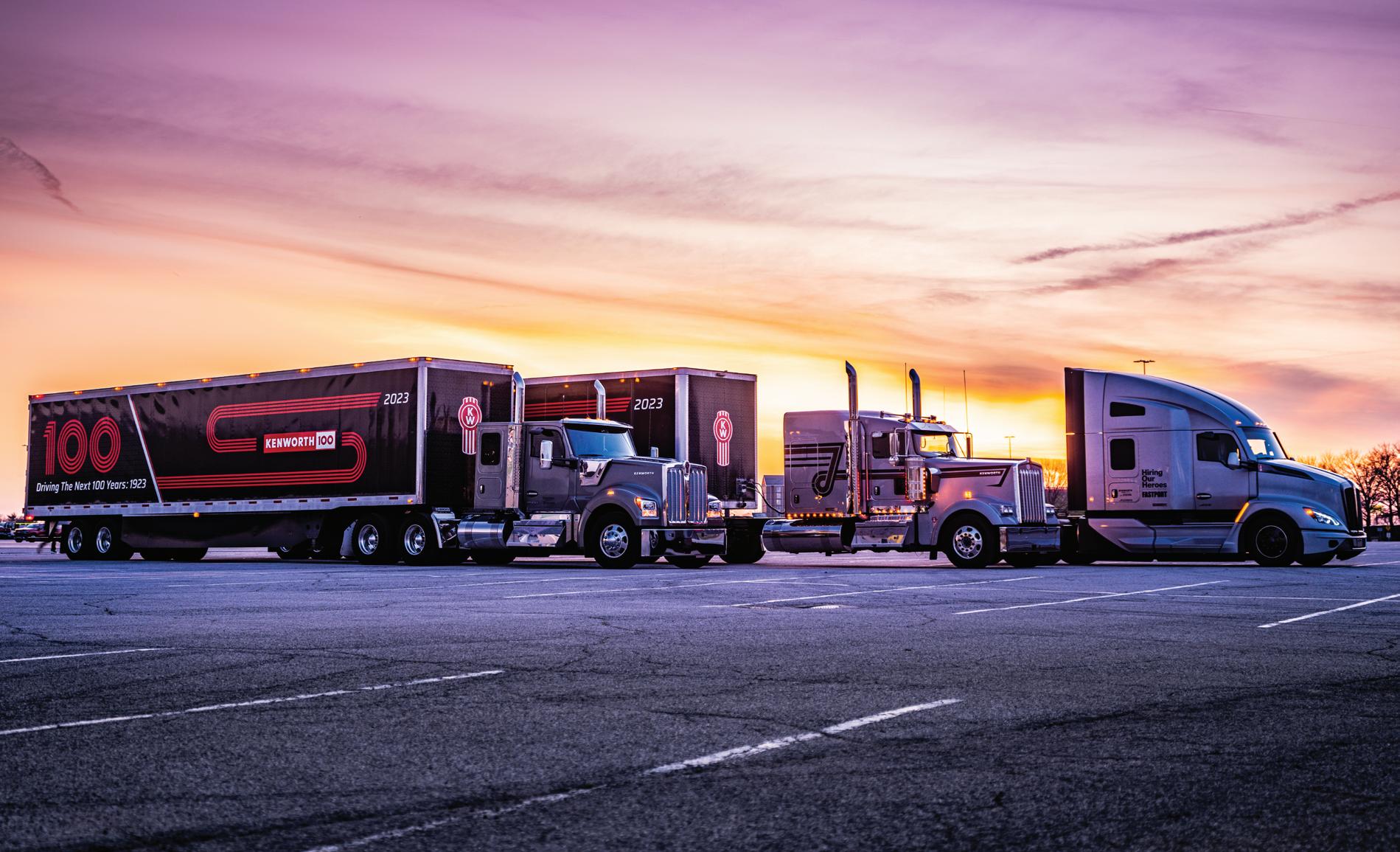
Investing in community is at the heart of what it means to be a Saltchuk company. Over the last five years, Saltchuk companies have given an average of $4 million each year, totaling more than $21 million in cash and in-kind support to the communities in which it operates. Most recently in 2022, Saltchuk companies contributed $5.7 million in cash grants and in-kind services to the communities where employees live and work.
As an organization, Saltchuk Resources has many divisions, including air cargo, domestic shipping, energy distribution, international shipping, and logistics, alongside Saltchuk Marine. The regions connected by Saltchuk are the Caribbean, Florida, Alaska, and Hawaii. Its vision is to build a family of the best transportation and distribution companies in North America that are
AmNav – Marine and harbor services along the West Coast
CITB – Ship assistance and harbor services in the Port of Anchorage, Cook Inlet, North Slope Prudhoe Bay, Seward, Southeast Alaska, Aleutian Islands, and Western Alaska
Foss Maritime – Marine transportation services, renewable energy, harbor services, and terminal services
Young Brothers – Hawaii interisland freight services and charter vessels
Foss Offshore Wind – providing laydown, supply, transportation and installation services to the US offshore wind industry
focused on serving customers within harbors, coastlines, and offshore markets.
Saltchuk companies often join forces, with Young Brothers, one of Saltchuk Marine’s companies, and Aloha Air Cargo connecting the islands of Hawaii, providing reliable shipments of everything from groceries to construction supplies.
Young Brothers is Hawaii’s leading freight and transportation company with the Port of Honolulu as its statewide hub. Whereas Foss Maritime, also in the Saltchuk Marine division offers ship assists, regional towing, barge charters and related marine services throughout the Hawaiian islands and into the Pacific.
Saltchuk Aviation also serves Hawaii, alongside Alaska and the Caribbean. It comprises operating brands Aloha Air Cargo, Northern Air Cargo, StratAir and Ryanair with the latter as its most recent addition.
However, Saltchuk’s first company was in domestic shipping and is now its largest line of business. TOTE Maritime, the oldest company in the Saltchuk portfolio, provides essential cargo services to Alaska and Puerto Rico. TOTE Services provides

ship management solutions to government, commercial and private ship owners.
The rich history, exciting growth, and innovation of these two companies make domestic shipping a constant source of pride for Saltchuk, with TOTE Maritime’s two domestic liner businesses announcing they would be the first in the history of the US to convert its fleet to operate on LNG.
Saltchuk’s energy distribution mainly consists of NorthStar Energy providing critical fuel and lubricants to residential, mining, fishery, and construction customers in Alaska, Montana, California and Hawaii. Furthermore, it brings a strong culture of safety and responsibility to the Saltchuk family of companies as well as being dedicated to the protection of the pristine environments in which they operate.
While international shipping is a newer addition to the Saltchuk family of companies, Tropical Shipping has already been established in the Caribbean and beyond for 60 years, providing the fastest and most reliable transportation and logistics services to the Bahamas, Puerto Rico and the Caribbean.
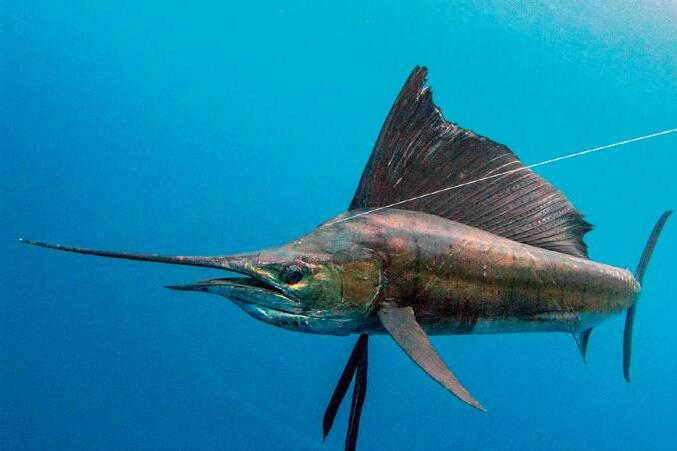



BSY serves all types of vessels from 100-400 feet in length with two drydocks and a ship elevator with level land modular workspace. BSY is equipped with all support services along with cranes and shops for specialized systems, fabrication, machining, and high-end carpentry. BSY’s best attribute is its highly skilled and dedicated workforce. BSY has a strong practice of training and promotion which allows the company to retain its top performers and provide the stage for them to grow.
It is Bay Ship and Yacht Co.’s stated to goal to “absolutely satisfy” its customers. This is accomplished by providing a great experience in a clean and efficient yard where the point is to ensure that new customers become repeat customers and returning customers receive the same high-quality service at every visit to the yard.



Concluding the family of companies is Saltchuk Logistics, which has independently operated Carlile, Shoreside Logistics, and Naniq Global Logistics with a commitment to solving global supply chain challenges.
In 2022, Saltchuk Marine purchased a plot of land and began the construction of the New Bedford Foss Marine Terminal, after sharing a vision with a local investment group that the site could be repurposed to something beneficial to all while still being tied to the electrical generation sector.
Saltchuk Marine has built, and is operating, the new terminal at the Port of New Bedford to support offshore wind developments.
The company worked with a local group to purchase a fueling depot site and transition it to a renewable energy terminal. Demolition crews worked
Air Cargo – StratAir, StratAir Puerto Rico, Ryan Air, NAMS, NAC, Aloha Tech Ops, and Aloha Air Cargo
Domestic Shipping – TOTE Services, TOTE Maritime Alaska, TOTE Maritime Puerto Rico, First Coast Terminals, and Puerto Rico Terminals
Energy Distribution – Alaska Petroleum Distributing, CityServiceValcon, Delta Western Petroleum, The Jankovich Company, Inlet Energy, Hawaii Petroleum, and Minit Stop
International Shipping – Tropical Shipping and TOTE Maritime Puerto Rico
Logistics – Carlile, Naniq Global Logistics, and Shoreside Logistics
hard to demolish the site and it is now under construction to eventually serve the US offshore wind industry.
“We are going to safely and efficiently grow our marine business while looking for market opportunities that leverage our current strengths. We also continue to incorporate technology to benefit mariners and shoreside staff by improving the information they receive and reduce the time and effort required to receive it,” outlines Childs.
As a leader in harbor towage, Saltchuk Marine will champion the cause within the industry and work with the entire supply chain to increase cooperation and drive alignment on regulatory and market changes.

“We are also leading the way on whale avoidance training and other marine wildlife initiatives,” he assures.
Further along in the year, the New Bedford Foss Marine Terminal will begin service as a central hub for offshore wind developers requiring office space, a marine coordination center, crew transfer vessels (CTVs) and service operation vessels (SOVs), service and support, storage and marshalling, warehousing and a workshop.
The terminal will also serve as an induction center to process and certify offshore wind workers prior to departing for wind farms, and house new office space for project teams, crew marshalling facilities, workspaces and a marine coordination center for technicians
supporting the Massachusetts offshore wind industry.
“Our new terminal is a longterm investment that fits well with our culture and strategy. We are proud to be creating great jobs in an underserved community and contributing to the development of safe and reliable alternative energy,” Childs concludes.
“We will continue to pursue opportunities that fit our profile and are a very acquisitive corporation.”
The terminal is set to revitalize the Port of New Bedford by providing critical support to the offshore wind industry.
The site was selected for its proximity to offshore wind blocks located approximately 15 miles south of Martha’s Vineyard and Nantucket Island. It will provide storage and laydown yards for equipment and materials, berth facilities for tug and barge operations, and host CTV and SOV support services.
With its reputation, innovation, and the long and storied history of its operating companies, Saltchuk Marine is the future of the US waterways and beyond.
Tel: 206.652.1111 www.saltchukmarine.com
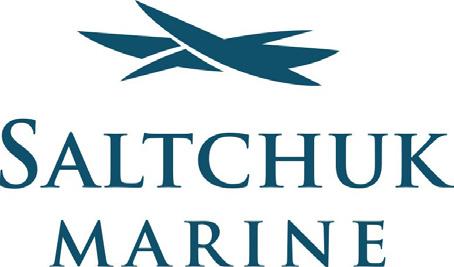
Schuyler Rubber has been the proud supplier of rubber fendering for Foss Maritime since 1964.

Our laminated rubber utilizes post-consumer tire treads to make the most durable and eco-friendly fenders available in the market today. We are grateful to Foss and Saltchuk for their support of green maritime products and a rich history of local partnership.



schuylerco.com
ben@schuylerrubber.com


800-426-3917
For further information on how to advertise in this space (at very competitive rates) in support of this feature company, click the button below.

 Made from 100 % recycled truck tire treads
Made from 100 % recycled truck tire treads
Leader Auto Resources (LAR) takes pride in being the largest procurement enterprise for automotive dealerships in North America, whether ranked by sales, profits, number of dealers, geographical footprint or range of products and services.
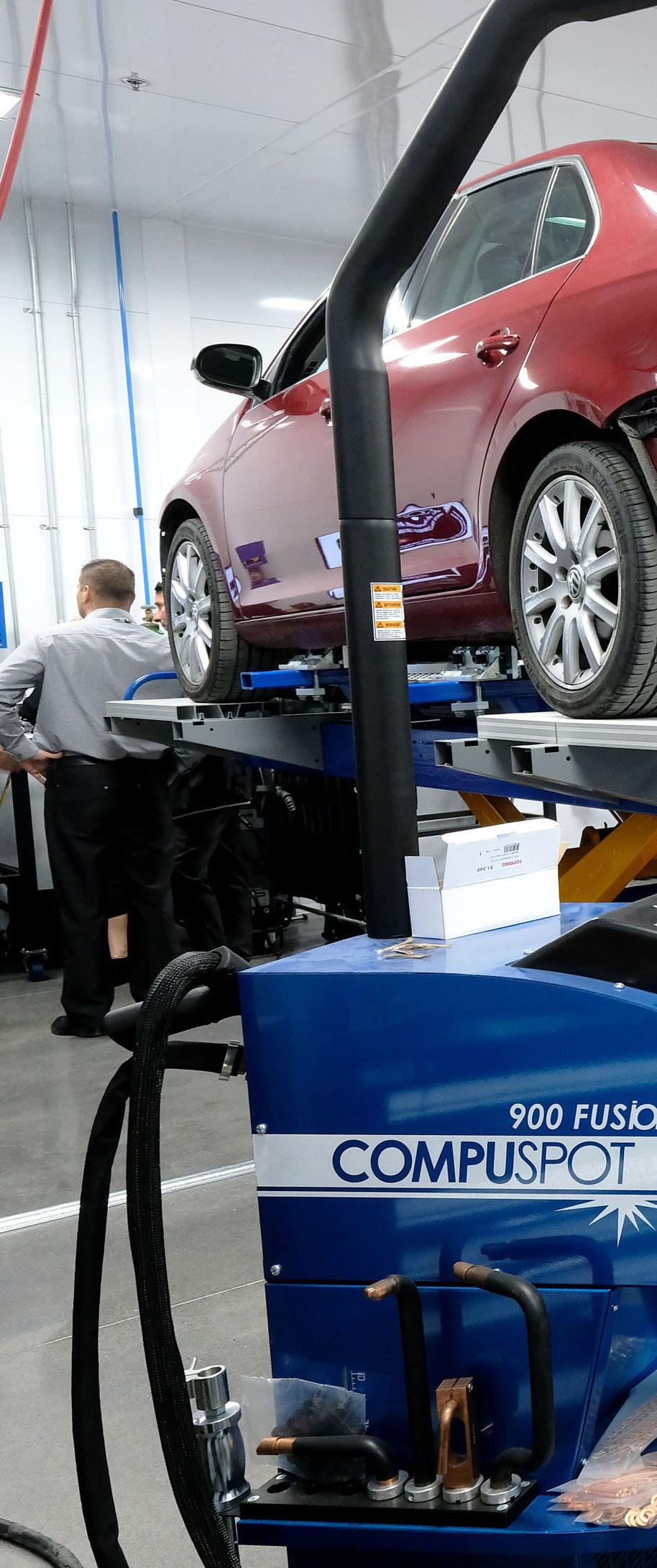
The company provides an excellent service to over 3,200 dealership members, catering to distribution centers in Montréal, St John’s, Calgary, and Malta (with the US affiliate shareholder, DealerShop), regardless of their size, brand, or location.
“Our vision is to be the leading player in all our markets, following clear, focused strategies that provide high-quality products, value-added services and additional discount dollar growth,” introduces Robert Issenman, President and CEO of LAR.
As the automotive industry has grown and evolved, LAR has kept pace with a steady expansion of goods, services and facilities. The company has a vast portfolio of products and services on hand across
every profit center in its dealerships, spanning its service department, collision and aesthetics center, sales department and administration.
LAR procures thousands of products, including paint and allied products for body shops, tooling and equipment, cleaning products and chemicals for garage maintenance, and new nanotechnology products for windshield and body treatment.
For Issenman, a career in the automotive industry was not always in the pipeline.
His unconventional path to LAR began in 1994, when he was a senior partner in a venerable national Canadian law firm and a member of its Executive Management Committee and Board of Directors. As a client of the firm, Issenman had previous connections to LAR, following involvement in various legal matters for the company.
“The Chairman of the Board of LAR at the time, the late Henry Mews, an
icon in the automotive industry, had a vision for the growth of LAR and thought that I could be instrumental in making it a reality by taking on the leadership of the company.
“It represented a major change of career direction, and as such, a difficult decision. After considerable thought and discussion, I took over the reins at LAR but remained as counsel to another leading Canadian law firm with offices around the globe. I have never looked back and, almost 30 years later, I can say it has been a very broadening and enriching experience,” Issenman details.
As a veteran of the automotive
We speak to President and CEO of Leader Auto Resources, Robert Issenman, about the firm’s vital role in fulfilling supply and demand in the North American automotive industry
Lucy Pilgrim | Project Manager: Callam Waller
industry, LAR’s Chairman of the Board, Allen F. MacPhee, emphasizes how over time, retailers have needed to gain more control of their purchases, which makes the role of LAR even more significant.

“There are many things that dealers cannot control, such as their relations with manufacturers, government regulations and economic conditions. It is very valuable to be part of a supply chain such as LAR, whose sole purpose is to acquire whatever a dealership needs at the most favorable prices, using expert purchasing skills developed over the last 40 years.”
The strength of the relationship with its dealers is at the heart of LAR’s success, alongside the cohesive connections it maintains with all the different internal departments. Consistent with LAR’s values, a dealer principal centric approach has been a key focus of the company since its inception. It’s singular focus on its dealership members guarantees that the company responds with what is best for those clients.
“We have regularly communicated how our value delivers not only top line savings from preferential pricing supported by additional discounts,




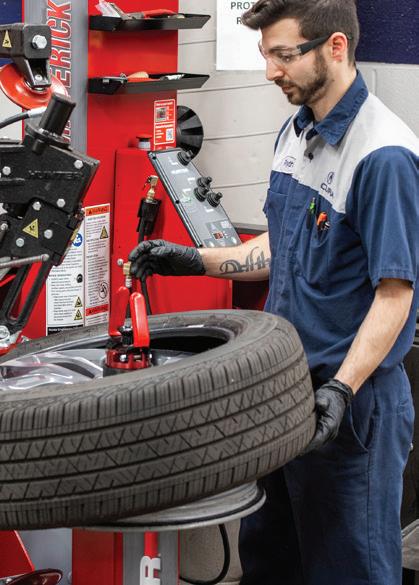


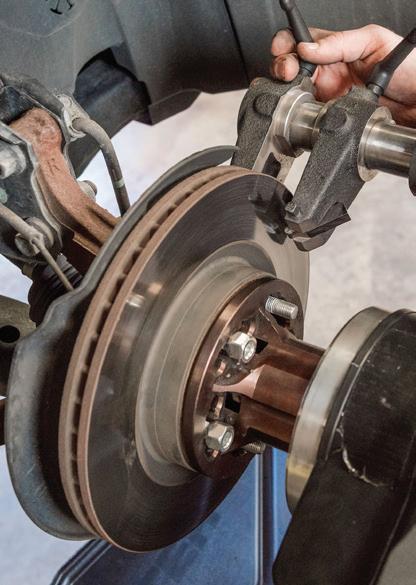





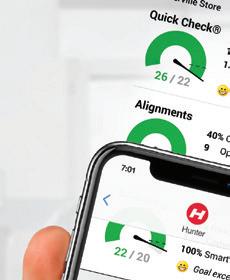






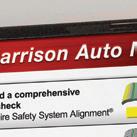























Hunter Engineering Company is the world leader in alignment, wheel and tire service, inspection and ADAS calibration equipment. We find out more with Regional Manager, Andrew Valle.

We have the largest full-time engineering team in the wheel service industry, and we now own more than 300 patents. Feedback from our customers and the field helps drive future innovations.
Briefly introduce us to Hunter Engineering. e.g., a brief overview of your main products and services, locations, client base, and number of employees.
Hunter Engineering (Hunter) is a familyowned and operated business that has designed and built automotive wheel service equipment since 1946. Hunter’s awardwinning research and development team of mechanical, electrical and software engineers is responsible for hundreds of patented and exclusive features that make Hunter products the most productive undercar service equipment available. Hunter now fields the largest dedicated support force in the undercar service industry. Business consultants and service representatives have an extensive network available to provide account assistance, product information and technical support. Customer satisfaction is key to Hunter’s success.
Our products are proudly designed and made in the US at our facilities in St Louis, Durant and Raymond. Our corporate offices are located in St Louis, Aurora, Canada and Puchheim, Germany.
Our core client base is car dealers, independent repair facilities, body shops, heavy-duty and commercial operations as well as government facilities.
We partner with customers to provide high-performance products that deliver the best possible results. Accordingly, Hunter is recognized for its high-quality products that set new standards in the industry. Our customers benefit from the largest field team in the industry, with more than 400 business consultants and more than 450 service technicians providing continued after-sales support and training. This field support is unmatched in the market today. We have also made considerable investments in training for our customers, with centers throughout North America, online and in person for technicians and advisors.
Our customers tell us that their decision to invest with Hunter is primarily based on exceptional service, top-quality products and the genuine interest that Hunter has in seeing their business succeed.
Could you tell us about some of the major challenges faced within the industry and the business itself and then detail how these have been overcome?
One major challenge we face is technician shortages and skills in servicing more complicated vehicles.
has always been a priority. The evolution of electric vehicles (EVs) in the market has placed further demands on the importance of fixed operations. EV sales in the US tripled in 2022 compared to 2020 (COX Automotive). There is a belief that EVs require less service than internal combustion engines, so capturing service opportunities will be more important than ever for dealers, as EVs put pressure on hours per repair order and the number of customer visits per year. The fact is, EVs are not maintenance-free. EVs that have only been on the road since 2020 are likely to need new tires today, unlike their gas counterparts. Tires are one of the fastest wearable items on these cars, so checking them not only allows for selling tires and rotations but once we remove wheels, we see everything else happening surrounding the wheel. Also, tires are the only safety system of a car that touches the road. EVs are very heavy, so suspension parts must be closely followed and serviced, including new wheel alignments, one of the most profitable services in the shop.
What are your major future ambitions going forward and how will these goals be achieved?
What are some of the ongoing or recent projects that you are most interested in showcasing?
• Quick Check® Drive – the autonomous service drive vehicle inspection systems.

• Third-party integrations with dealer management systems (DMS) allows Hunter technology to seamlessly send data to DMS, significantly improving processes for service advisors and thus increasing revenues and productivity.
What, for you, differentiates your business from the competition?
For more than 75 years, Hunter has been a family-owned business driven by innovation.
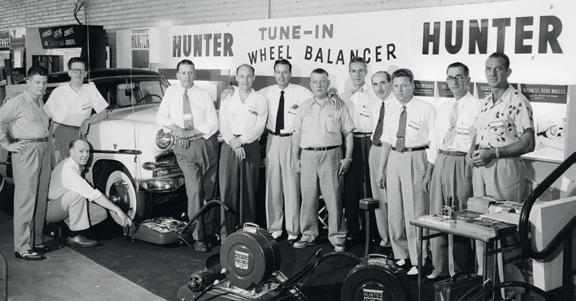
Elsewhere, one of the biggest challenges today for dealers is attracting and retaining automotive technicians as there is a large-scale industry shortage of this skilled workforce. Hunter products help dealers attract and retain technicians by allowing the dealer to demonstrate that they are not only committed to the consumer but also to the technician by giving them tools that help them complete services faster, safer, more profitably and with higher-quality results. Increasingly equipped with complex onboard Advanced Driver Assistance Systems (ADAS), such as adaptive cruise control, lane departure warning, collision avoidance and self-driving capabilities. These systems often need service after wheel alignments, collisions or windshield repairs, for example. It can be difficult to keep up with repair processes for these complex systems as they evolve. Hunter ADAS equipment helps guide technicians through the repair process specific to the unique VIN of each car, ensuring a successful outcome for the tech, customer and dealer. Service absorption within the dealership
At Hunter, we want to be customers’ first thought and first call when they’re considering investments in their stores. However, we respect that this must come from the trust we need to build with customers by working in partnership with them.
Our growth at Hunter is directly linked to our ability to innovate, offer the best service in the undercar industry, and exceed our customers’ expectations. Therefore, we will remain focused on growing our field team both in service and regarding business consultants, provide more training opportunities for customers and for the technicians of today and tomorrow, and continue to raise the bar on product innovation that customers have come to expect from Hunter.
What are you most proud of in relation to the company overall?
In one word, passion. The people at Hunter are genuinely passionate about what they do, and you see it and feel it when you visit the offices and manufacturing plants and when working with the field team visiting customers. People are smiling and having fun, they’re inquisitive and take a greater personal interest in others. I believe our customers also feel this passion that we have at Hunter, and this is why they trust the brand we have built.
Robert Issenman, President and CEO: “The Dealers’ Collision Technology Institute serves as a tangible reminder of the kind of investment in innovation that LAR has proactively developed, as our mission at the institute is to educate and inform in collaboration with our manufacturing supply partners. Each year, we launch informative workshops on the latest developments in Advanced Driver Assistance Systems (ADAS).
“Consistent with our vision to lead the way, LAR offers both in-person and online training to address the various facets of this rapidly evolving technology, including scanning, calibration, and specialized equipment utilization. The focus is on apprenticeships at all levels in mechanics, body work, and the rapidly burgeoning requirement to be abreast of knowledge related to EVs.”
but also how LAR drives operational efficiencies delivered from centralized purchasing and invoicing. It is this longstanding core advantage that gives LAR the leg up and serves to deliver the greatest benefits to our original equipment manufacturer (OEM) dealers,” states Issenman.
Projects aside, LAR has a respectable and knowledgeable workforce that underpins the dealership’s trust and acts as the conduit to drive new product penetration. Furthermore, LAR believes that sales growth derives from effective program deployment at the field level.


“While LAR is of course a preeminent procurement enterprise, it is also a sales engine, and it is the combination of these two spectrums which makes LAR the perfect partner to support all our dealerships,” he highlights.
LAR’s supply chain operations are at the core of the organization. The
structure of the company means that dealership members understand the benefit of a “one-stop shop” that provides access to LAR’s unmatched portfolio of strategic supply partners. Thus, members benefit from a vast range of products and services including, tools and equipment, consumable products, paint and body and direct dealership services, which are all available with additional discounts behind the invoice.
“LAR offers much more than the widest catalog of products and services. It is uniquely qualified to support dealers who wish to build new facilities, expand upon existing service areas or execute renovations. With the most sophisticated strategic supply partners and in-house expertise to offer initial consultative services, LAR delivers unparalleled value-added offerings.”
On a wider plain, LAR’s global supply chain is integral to the company. “Our strategic shareholding in TECAR (tecar-international.com),
“LAR HAS MADE SOME OF THE MOST DRAMATIC ADVANCES IN OUR HISTORY TO EXPLOIT GROWTH OPPORTUNITIES ACROSS NORTH AMERICA, AND THE ORGANIZATION IS NOW PRIMED FOR EVER GREATER SUCCESSES IN 2023 AND BEYOND”
– ROBERT ISSENMAN, PRESIDENT AND CEO, LEADER AUTO RESOURCESTECAR shareholders



a European-based partnership, reflecting the purchasing power of over 15,000 car dealerships in 13 countries, enables us to identify costeffective and efficient procurement opportunities,” Issenman elaborates.
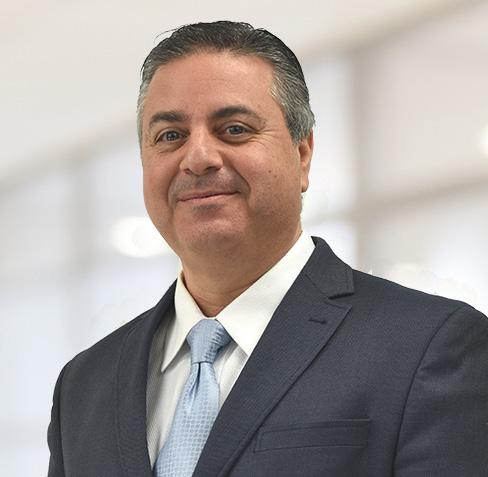
LAR’s highly comprehensive procurement department is proactive in navigating recent worldwide supply chain issues by understanding all aspects of supply chain management and having the ability to predict obstacles and find solutions.
Significantly, a strong bond with each individual supplier makes this possible, allowing the company to keep its finger on the pulse for every product category.
A deep understanding of every single supplier is essential, as each one is an expert in their particular
product. “Our philosophy is to typically have secondary and ‘back up’ supply chain options, so that we are in a position to virtually always get any needed merchandise to our members on time,” affirms Allan Ezri, National Director of Purchasing and Inventory.
Due to the complexity of the automotive ecosystem, the industry not only involves retail car dealers but OEMs, which have national programs to supply its dealers with specialized tooling. Many of these programs are facilitated and invoiced through LAR. As such, the company’s relationship with OEMs is critical to the overall success of the automotive sector.

LAR’s most recent projects showcase
the company’s prior progression. For example, it facilitates the equipment program for approximately nine OEMs in Canada, as well as the development and maintenance of several OEMspecific websites, all of which are noteworthy projects.
Moreover, with the introduction of EVs, franchises have new requirements including charging stations, specialty tools, new batteries (and their disposal), protective equipment from electric shocks and much more. Again, the supplier relationships are integral in this process, as they enable the company to request and receive reports on its technical progress, as well as a planned market introduction of upcoming products so they can immediately, effectively and
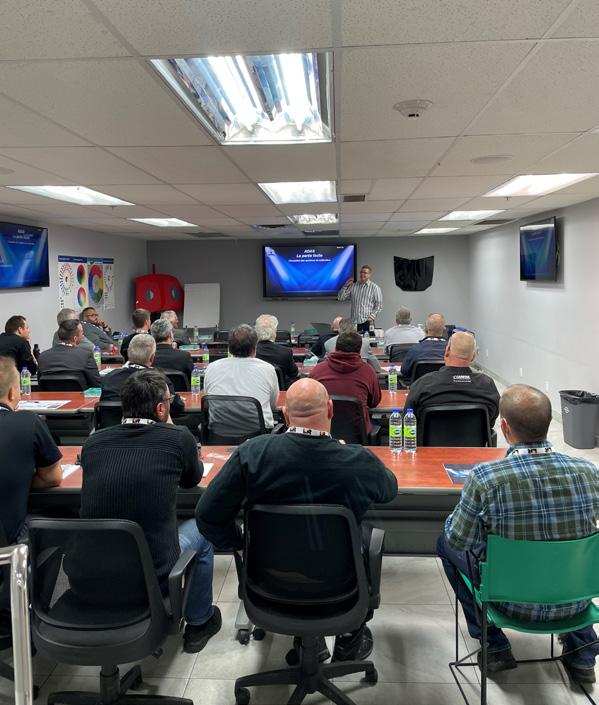
“OUR PRIMARY RESPONSIBILITY IS TO OUR DEALERSHIP MEMBERS. THEREFORE, OUR ACTIONS ARE GUIDED BY THE BELIEF THAT INTEGRITY, COMMITMENT AND QUALITY ARE ESSENTIAL VALUES TO ANSWER OUR CLIENTS’ NEEDS”
– ALLAN EZRI, NATIONAL DIRECTOR OF PURCHASING AND INVENTORY, LEADER AUTO RESOURCES
efficiently support the OEM franchises with the new supplies of inventory they require.









The relationship between LAR and various OEMs represents a critical interest in the ongoing transition to the electrification of vehicles and a deeper understanding of the market drivers and how it affects the automotive ecosystem.
“LAR is always ready and prepared for future innovation in lockstep with our supply chain. Together we serve





Introducing Gilco/Junise, a trusted supplier of comprehensive maintenance cleaning, packaging and security product solutions tailored specifically for the car dealership industry. With an extensive range of over 2,500 high-quality products, we are dedicated to enhancing the customer experience while preserving the pristine condition of vehicles.





Serving car dealerships from coast to coast in Canada, Gilco/Junise is committed to delivering exceptional products that meet the unique needs of this dynamic industry, ensuring efficiency, professionalism, and customer satisfaction.


the automotive industry, and our mission is to always be at the forefront of change to ensure the relevant supply of products and services,” comments Andrew Wells, General Manager of Sales for Ontario, Atlantic and Western Canada.

In line with its innovative history, the next major initiative needed to buttress LAR’s technological infrastructure involves the implementation of an Enterprise Resource Management (ERP) system. This system is vital in supporting the massive increase in the customer base, arising from the OEM programs and the resulting need for segmentation and individual reporting.
Newly accessible shared information facilitated by the ERP system will allow for collaborative and actionable decision making and management reporting. The new platform will also facilitate detailed business analysis that will

provide important opportunities for improvement in every department.



“For over 40 years, we have been nurturing and building trusted partnerships with our dealers. These special relationships, which have in many instances spanned decades, have generated millions of dollars of savings for our dealer community.
“Our reason for being is to deliver added value to our dealerships, who are true partners in every sense of the word. As the clear leader in a highly evolving market, our committed dealerships are driving our clear success. As such, LAR is confident in its ability to grow its business and increase its market share,” concludes Issenman.
With more than three decades at UPS® under my belt, I would say that I bleed brown!”
It was 1990 when Jeff McCorstin originally began his esteemed career at UPS®, one of the world’s largest package delivery companies, as a peak season package delivery driver.
Though UPS® is famous for delivering packages all over the planet with legendary precision, it turns out that the company also offers an unexpected wealth of services and expertise to help streamline global supply chains.

Indeed, McCorstin today has progressed to the role of President of Global Freight Forwarding at UPS Supply Chain Solutions®, the freight and logistics arm of UPS® that manages every aspect of global supply chains.
“My responsibilities continued to grow in line with our company’s direction, and it made sense to be involved with the supply chain solutions industry, where we assist customers with their global supply networks and their need for more than express small parcel delivery,” he tells us.
“It truly allows us to provide end-toend supply chain solutions on behalf of our important customers.”
The best supply chains stay in constant motion, and UPS Supply Chain Solutions® keeps them humming along by helping customers control three fundamentals: the doing, the seeing, and the optimizing.
Global Freight Forwarding, overseen by McCorstin, is one of four businesses that comprise UPS Supply Chain Solutions®, along with Global Logistics and Distribution, Mail Innovations, and Coyote Logistics,
each with several of their own services and capabilities to meet the everchanging needs of customers.
Global Freight Forwarding services provided by UPS Supply Chain Solutions® are easily accessible, highly reliable, and extremely flexible for balancing speed and cost-efficiency requirements.
“Under my area of responsibility, we offer several services that support our customers’ needs, such as international air freight, North
American air freight, ocean freight, and customs brokerage,” informs McCorstin.
“With our Global Freight Forwarding solutions, we accommodate the needs and challenges that our customers come to expect.”
Within international air freight, UPS Supply Chain Solutions® stands as a top 10 air forwarder whose large global fleet and extensive carrier
partnerships ensure access to flights around the world.
From urgent, next-flight-out service to door-to-door service within one to five business days, UPS Supply Chain Solutions® has a trusted network of airline flights, charters, and strategic partners to get cargo to where it’s needed, when it’s needed, and on budget.
Serving more than 14,000 origins and destinations worldwide, this global presence and scale assists UPS Supply Chain Solutions® in acquiring
international air freight capacity. Efficiently and economically moving goods within and between the US, Canada and Puerto Rico, meanwhile, is the company’s North American air freight service.
“We have a North American air freight product which is a heavyweight next-day, second-day and third-day defined service, as well as a Trade Direct® Cross Border service offering in the US, Mexico and Canada,” McCorstin states.





In his 33-year tenure, Jeff McCorstin has had an undeniable impact at UPS®, leading supply chain strategies to improve logistics outcomes for customers around the world. Today, in his role as president of the global freight
forwarding division of UPS®, Jeff is tackling his next big ambition – bridging the data gaps that universally stunt advancements in the supply chain industry.
Jeff and his team recently selected the cloudnative data experience company, Domo, to help modernize the data strategy at UPS® and champion a new future for supply chain logistics. Jeff and Domo’s Chief Analytics Officer and SVP of Customer Success, Mark Maughan, sat down together to talk about how they plan to uplevel the UPS® customer experience and sharpen its competitive edge in a famously commoditized industry.
Mark: You have an impressive tenure in the supply chain and logistics industry. What have you learned are the most important factors to success?
Jeff: Success in this industry requires the right people, tools, technology, and processes. I’ve always leaned into tools and technology to arm our people around the world to make informed decisions. I follow a "head, heart, and hands" leadership model: being strategic, innovative, future-focused, and a complex problem-solver (head); inspiring others and fostering collaboration (heart); and delivering results, being accountable, being agile, and building effective teams (hands).
Data is the common tie between these traits and leveraging it in the complex world of supply chains is crucial. We mine it for insights, use it to predict trends, and turn it into efficiencies that give us a competitive edge. As we look ahead, our data strategy becomes increasingly vital. Machine learning and emerging technologies will be instrumental, but only with a robust data strategy in place. This understanding led us to Domo, aligning with our vision of a future where data forms our operational backbone.
Mark: Why is direct access to data importantespecially in supply chain logistics?
Jeff: Direct access to data enables us to make informed and timely decisions, resulting in better overall operational performance. It allows us to proactively identify and address bottlenecks in our customers' supply chains, working collaboratively to find solutions. Using data, we can anticipate and minimize the impact of exceptions that may arise in global supply chains.
By leveraging Domo alerts, we can promptly identify potential delays or disruptions, allowing us to take immediate action and mitigate customer impact. This not only helps us maintain efficient operations but also enables us to provide our customers with accurate delivery information. With precise delivery dates, our customers can plan their staffing resources accordingly and effectively communicate with their own customers. This immediate access to data not only bolsters our operational agility and customer service but also enhances our overall value proposition and widens our competitive advantage in the industry.
Mark: What business challenges were you trying to solve at UPS® when you started pursuing a new approach to data?
Jeff: The scale at which logistics data is siloed in this industry is a significant barrier to bringing it into the future, and I see so much potential in breaking down those walls. The complexity and fragmentation of data across systems limits our view of the full end-to-end supply chain, and the manual processes, paper-based inefficient operations, and overreliance on Excel and static rearview mirror reporting tools create bottlenecks, limit data flow and hinder decision making.
Our collaboration with Domo allows us to pull disparate systems together in a single platform and provides us with real-time dynamic data. Domo not only addresses our immediate challenges but also allows us to manage data effectively to hit our Key Performance Indicators and influence growth and innovation. By providing the right tools and empowering our teams to quickly adapt to the changing landscape, we can set new standards
for operational excellence and better serve our customers in a fast-paced industry.
Mark: What makes Domo the right provider to help you champion these changes?
Jeff: What sets Domo apart is its ability to deliver rapid time-to-value. We had been working with other BI and analytics vendors in the past, but we were not achieving the level of speed and efficiency that we needed, particularly in reporting. With Domo, we found a solution that delivered value within two weeks, while still ensuring data integrity and protection.
Because the supply chain industry typically measures project timelines in months and years, Domo’s pace is a refreshing shift, and feels like a catalyst for our journey towards "grown-up analytics." Already, this collaboration has enabled us to make data-driven decisions in real time and drive meaningful change across our entire organization – from our front-line operators to the C-Suite. Domo's solution provides the agility and flexibility we need to meet our evolving business needs. We like to manage our business by the clock and not the calendar, and Domo allows that speed and agility.
At UPS®, we are constantly searching for ways to add value while decreasing costs, and this collaboration will give us value we can pass on to our customers.
Mark: What outcomes do you expect from reinventing data strategy for Global Freight Forwarding at UPS®?

Jeff: Our ultimate goal is to create more efficiency and value for our customers, and we’re already beginning to move the needle.
For example, we’ve freed up hours of our operators’ time each day by automating processes that were historically manual. We’ve also improved our real-time decision-making capabilities through a custom-designed dashboard that drills into important data with ease. In both cases, we were enjoying the outcomes within days, compared to weeks and even months we’ve experienced with other vendors.
We’re looking forward to extending these benefits to more of our employees, and to our customers by integrating Domo into their UPS® experience. What truly sets Domo apart from our past collaborators is how easy it is for everyone to build and access business insights. Our citizen developers do not need a technology background to learn and use Domo.
Mark: How will your customers benefit from the real-time data access they’ll get through your collaboration with Domo?
Jeff: We want to provide customers with a level of unprecedented visibility and understanding of the commercial and transactional components of their relationship with UPS®. To do this, we plan to embed Domo's analytic capabilities into our existing customer-facing applications, so customers can
“We plan to embed Domo's analytic capabilities into our existing customer-facing applications, so customers can have access to real-time data and insights alongside us.”
Jeff McCorstin, UPS® President Global Freight Forarding
have access to real-time data and insights alongside us. We want to collaborate with customers to highlight inefficiencies and ways they can drive down their transportation costs. We also want to proactively address problems in collaboration with our customers, so we can manage disruptions and provide the best customer experience.
Mark: Now that you have a new data strategy and fresh perspective on what’s possible, what excites you about the future of the supply chain and logistics industry?
Jeff: What excites me the most is the potential to transform UPS Supply Chain Solutions® and Global Freight Forwarding’s role in the logistics industry by capitalizing on our data in ways that we never thought were possible.
With Domo as our collaborator, we’ve identified numerous use cases and innovative ways to leverage data to improve our internal operational processes and capabilities as well as the supply chain experience for our customers...and for theirs. Gaining access to previously unavailable data and understanding the interrelationships enhances our operational capabilities, and also empowers us to meet the evolving needs of the industry.
As we continue to embrace technology and leverage data-driven insights, we’re shaping the future of supply chain and logistics, driving continuous improvement, and delivering unparalleled value to our customers.

To learn more visit domo.com/ups
UPS® and Domo are collaborating to reinvent the supply chain with data. By breaking down data silos and providing real-time insights, UPS® is able to make better decisions, improve efficiency, and deliver a better customer experience.
Cross Border is one of three Trade Direct® services that allow UPS Supply Chain Solutions® to meet international supply chain needs, complemented by Trade Direct® Air and Trade Direct® Ocean.
Leveraging the breadth and reliability of the UPS® global network, Trade Direct® handles freight consolidation via air, ocean and ground transportation, customs clearance, and direct delivery to multiple addresses within the destination country, all through a single source.
By consolidating individual shipments to the same destination country into just one shipment, UPS Supply Chain Solutions® can cut customs clearance times.
“One of the values of being both an asset-based provider in our small parcels business, and a
freight forwarder in our supply chain solutions business, is to offer a oneto-many solution – we call it Trade Direct®.”
“A customer can make a single shipment that has multiple recipients for final delivery; we can clear customs as a single shipment then drop it off into our small parcel network for the final recipients to receive their goods,” McCorstin elaborates.
By sea, UPS Supply Chain Solutions® is one of the world’s top nonvessel operating common carriers (NVOCCs), with contracted space allocation with major global carriers to ensure access, competitive rates, and reliability.

Ocean freight is moved across more than 2,300 shipping lanes daily by
UPS Supply Chain Solutions®, who as an experienced NVOCC provides up-to-the-minute customs expertise, visibility and communication every step of the way for those considering expanding to new markets.
The company’s value-added ocean freight services can take shipping to the next level, bolstered by strong expertise and network infrastructure around the world, and best-in-class visibility tools to provide end-to-end control.
“We support our customers at the origin with a purchase order management service. In essence, we are the eyes and ears for customers that need to consolidate multiple vendors’ projects into an ocean container but do not have people in the country,” explains McCorstin.
Having been in transportation and logistics for more than a century, UPS
Supply Chain Solutions® is likewise used to being on the front lines of customs brokerage, helping to inform and lead compliance policy, support public affairs, and ensure the best interests of both customers and the trade community are well represented.
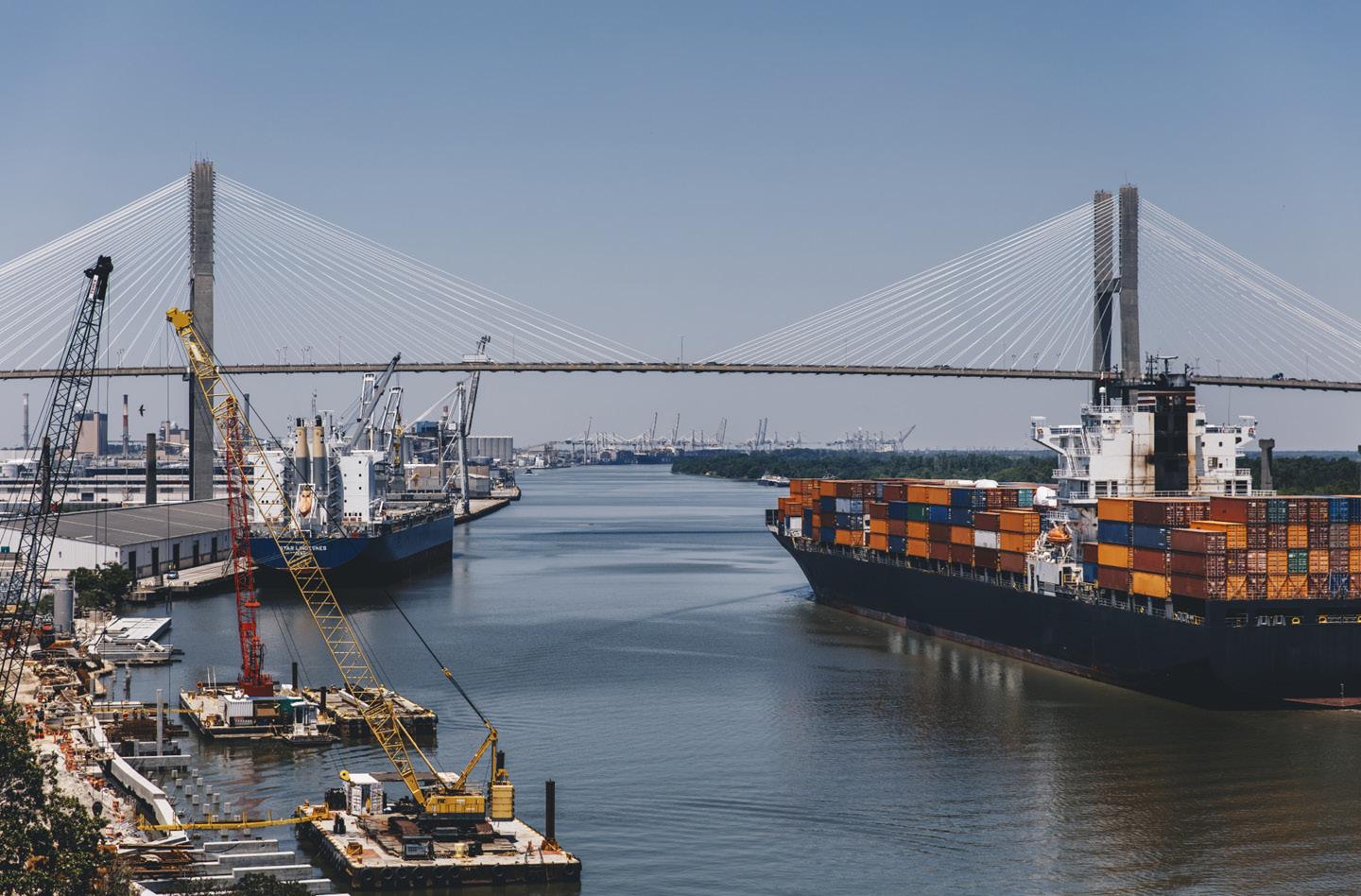
As one of the world’s largest customs brokers, UPS Supply Chain Solutions® has close relationships with customs agencies, superior timeliness, a wide breadth of in-depth solutions, and ensures its customers’ needs are heard by not just following the rules but helping to make them.
The company also has a range of innovative multimodal services, including sea-air, rail from Asia to Europe, ocean LCL (less than container load) and preferred LCL to name a few.
These multimodal services ensure the right balance of speed and economy, as they are often less expensive than air freight yet faster
than ocean freight, making them a perfect transportation alternative.
UPS Supply Chain Solutions® has more than 115 years of transportation and logistics experience, whose global footprint, breadth of perspective, competencies, and capabilities are proven to help businesses of all sizes to deliver the right balance of speed and cost-efficiency.
But what sets the company as a whole apart is the 550,000 UPSers around the world, including more than 12,000 Global Freight Forwarding employees, that make it happen every day and exceed customer
expectations.
“Empowering our staff with the autonomy to not only bring their unique selves to work but to make decisions that will support our customers’ needs is a must.”
People are the most important asset at UPS Supply Chain Solutions®, as demonstrated by the company’s leadership model, which is designed to build a culture that retains and grows its employees.
“We have a leadership model that is all about the head, heart, and hands. The head is about strategy – can you solve complex problems? Are you innovative? Do you think outside the box?” McCorstin comments.
“WE HAVE A LEADERSHIP MODEL THAT IS ALL ABOUT THE HEAD, HEART, AND HANDS”
JEFF MCCORSTIN, PRESIDENT OF GLOBAL FREIGHT FORWARDING, UPS SUPPLY CHAIN SOLUTIONS®
Welcome to a new era of logistics excellence, where efficiency, visibility, and quality are not just goals, but a reality. At the heart of this transformation is CargoWise, a world-class logistics operations platform. It provides end-to-end visibility, shifting your operations from reactive to proactive, enabling you to reach higher, faster.
Zinnovate, as your implementation partner, is uniquely positioned to unlock the full potential of CargoWise for your business. Our deep industry knowledge and technical expertise allow us to optimize your business processes, ensuring you reach as close to optimal
performance as possible, and faster than you ever thought possible.
Our mission is simple: to improve our customers’ operations. We achieve this by harnessing the power of CargoWise to drive efficiency, standardization, and digitalization. For freight forwarders, this means streamlined operations, real-time data for quick decisionmaking, and improved service quality.
But what truly sets Zinnovate apart is our commitment to your success. We don’t just implement a system; we transform your business. We work closely with you, understanding your unique challenges and goals, and tailor

our approach accordingly. We’re not just a service provider; we’re your partner in this journey towards excellence.
With Zinnovate and CargoWise, you’re not just adopting a new system; you’re embracing a new way of doing business. A way that’s efficient, proactive, and quality-driven. Let Zinnovate guide you to the skies of logistics excellence. Your journey to the top starts here. Zinnovate has firmly established itself as a leading global provider at the forefront of digital transformation projects in the logistics industry. The company’s unique industry insights have been garnered from years of best
practices based on actual cases from the majority of the top 20 global forwarders. With its extensive global expert network, Zinnovate harnesses superior change management and technical know-how to deliver actionable results, guiding and empowering global logistics as they adapt to the new technological revolution.
This specialist IT and
management consultancy originated from a powerful idea and fruitful collaborations, inclusive of their team of consultants spanning 25 countries across all continents, and their key partner since 2013, WiseTechGlobal, with its flagship product, CargoWise. Having one hand on emerging exponential technologies and the other guiding their partners, teams, and clients,
Zinnovate is poised to offer solutions unmatched by others.

In 2020, Zinnovate made industry history by assisting a key customer in becoming the first in the logistics world to implement their new IT system across 62 countries in a “Big Bang” worldwide go-live. By 2022, they had surpassed the 100 MSEK milestone, and their growth continues to accelerate.
Håkan Nilsson (HN), Founder & Group CEO, and Tamsin Emery (TE), Project Director, share the pride they have in the accomplished Zinnovate team, their journey to success, and the privilege of partnering with UPS®.®.
When asked about the secret to Zinnovate’s remarkable triumph, HN confesses, “The secret ingredient? It’s our absolute passion and unwavering dedication towards serving our customers.”
TE adds, “Our success hinges on the profound respect we hold for our team. While our customers are our primary focus, we prioritize the wellbeing of our people. We believe that without our team, we are nothing. Their
 Zinnovate team members from Americas, EMEA and APAC gathered in the nice surroundings outside of Atlanta, Georgia.
Zinnovate team members from Americas, EMEA and APAC gathered in the nice surroundings outside of Atlanta, Georgia.
contributions are invaluable not only to us but also to our customers.”
On Zinnovate’s strategy for maintaining its leadership position in the digital transformation space, TE reveals, “We invest substantial time in understanding emerging technologies and integrating them into our daily operations. We ensure our customers benefit optimally from the digital transformation landscape, aligning their needs with upcoming market trends. Our key aim while collaborating with a customer is to share our knowledge and enable them to function independently, thereby bolstering their expertise and delivering immense value.”
HN further elaborates, “In addition, we’re broadening our capabilities with cutting-edge technologies, scaling our industryleading software as a service (SaaS)

among other initiatives.”
Discussing the pillar values of the value-driven organization, TE says, “ At the heart of our ethos lies a profound appreciation for people. Our business is steered by a principle we hold dear, the Return on Competence. This mantra underscores our commitment to nurturing and valuing expertise. Honesty and integrity are not just words to us; they embody our operations, reinforcing our pledge that people truly matter to us.
One of our primary objectives when collaborating with clients is to facilitate knowledge transfer, empowering them to operate independently from us. This strategy not only fosters expertise but also builds substantial value for our clients, echoing our belief in the significance of people and competence.”

HN emphasizes, “We aspire to synergistically enhance the collective output, going beyond the sum of individual parts. This principle applies not only to human potential, where we transform high-performing individuals into synergistic teams but also to business systems, where we leverage exceptional methodologies to drive superior business performance. Our consultancy service stands unrivaled in the industry, firmly grounded in the understanding that mere aggregation of talent doesn’t guarantee a high-performing team.
“We emphasize the importance of nurturing Relationships and
preserving Reputation, the twin pillars of R&R. Our dedication to forging deep, meaningful connections and protecting our hard-earned reputation knows no bounds. Through our exceptional customer relationships and unparalleled industry expertise, we’ve built a high reputation of prestige and trust.”
When asked about Zinnovate’s approach to talent acquisition, development, and team building, HN explains, “Our focus on talent development epitomizes the Return on Competence principle. We strive to ensure our team members continually grow and find satisfaction in their growth. It’s an axiom that winners draw winners; attracting top talent to a successful team is relatively straightforward.
“Even though approximately 350 competitors are providing expert consultancy, Zinnovate leads in nine out of 10 of the largest global projects. This places us in a unique position to attract talent, offering the opportunity to work on the most challenging and exciting projects in this field. We take pride in having a substantial number of female senior expert consultants in the traditionally male-dominated intersection of Logistics, IT, and Management Consultancy. Our commitment to diversity is unwavering.”
TE elaborates, “With consultants in 25 countries, team building exercises are challenging, but we strive to unite our team whenever possible. Most of our initiatives are centered around digital connection. We distribute a regular newsletter that updates the team about ongoing projects, new developments, and customer activities, fostering a sense of unity despite geographical barriers.”
Discussing Zinnovate’s future plans, TE says, “We’re concentrating on two primary areas: team and resource expansion, and product development. While consulting is our primary area of expertise, we intend to broaden our product portfolio. We regularly observe customers struggling with tasks that lack software solutions, necessitating
Zinnovate team at customer premise in Dubaimanual effort. Our aim in digital transformation is to bridge these gaps through product development and new applications or software creation.”
HN adds, “Considering the fragmented state of the freight forwarding industry, I foresee a surge in mergers and acquisitions. I believe this will emerge as a crucial service area for Zinnovate to support our customers. Above all, we aim to further ignite our team’s passion and enhance their professional satisfaction.”
Addressing the partnership between UPS® and Zinnovate to maximize UPS®’s value, TE shares, “We collaborate with some partners to provide support services to UPS®, including applications and invoice processing software developed by one of our partners. We ensure comprehensive coverage, enabling UPS® to appreciate the full end-toend value.”
HN concludes, “Our collaboration with UPS® is both an honor and privilege. I’m confident that Zinnovate can deliver a competence factor to UPS®, surpassing what others can offer. However, achieving this requires strong cultural alignment between the organizations. This alignment hinges on personal chemistry, fostering productive collaborations. Zinnovate is designed to swiftly scale up to
accommodate the needs of large clients like UPS®. Despite UPS®’s immense size, we share a core value: people matter. This belief is not merely a marketing strategy, and it ensures a fitting personal chemistry between UPS® and Zinnovate.”
Zinnovate’s journey is a testament to its unwavering commitment to people, competence, and customer service, reflected in its industryleading position. With a deep-rooted ethos of Return on Competence, the company has consistently proven itself as a reliable partner in navigating the vast landscape of digital transformation, even in

the face of intense competition. Its dedication to understanding and integrating emerging technologies, fostering team growth, and ensuring customer satisfaction has set a high bar in the industry. As it looks to the future, Zinnovate continues to enhance its offerings and expand its team, with an emphasis on creating valuable solutions to bridge the gap in the market and supporting its customers in the increasingly complex world of logistics and IT. Its partnership with UPS® underscores its capacity to scale up and deliver a superior level of competence, thereby reinforcing its reputation and trust. If you want to be part of this transformative journey, contact Zinnovate, a company that is reshaping the digital landscape of the logistics industry, one project at a time.

“The heart is where I really believe my biggest strength is, and it’s all about inspirational leadership and being inclusive. Diversity, equity and inclusion (DEI) means more than just diversity of gender or race; it also means diversity of thoughts and experiences, making sure that we’re perceptive, reading the room, and making sure that we are collaborative.”
Jeff McCorstin, President of Global Freight Forwarding: “My first taste of the transportation industry came at UPS® as a peak season package driver.

“On my fourth day of the job, I received an offer from KPMG for a management consulting role. UPS® sat me down and spent 90 minutes selling me on the history, legacy, and culture of this great company. I declined the offer with KPMG and moved into management with UPS®.
“I’ve had roles in operations, industrial engineering, strategic cost, and finance
McCorstin has always believed in being a cross-functional collaborative leader, and that hearing multiple people’s opinions is the right approach.
The third and final trait that McCorstin leans into as a leader is the hands, which involves delivering results, being accountable, adapting to market conditions, and being a strong team builder.
“I like to try and keep things
and administration (F&A) across different locations within the US. I was the Air Finance Controller at our hub in Louisville, Kentucky (KY), responsible for the financial analysis of aircraft acquisitions and the Worldport facility, which led to becoming CFO for Europe, the Middle East, and Africa (EMEA).
“After this assignment, I was named President of EMEA Freight Forwarding, which began my foray into the supply chain/freight forwarding industry. Additional supply chain roles I held before my current position include Senior Vice President of Global Freight Forwarding Air and Ocean Product; President of Asia Pacific Freight Forwarding; and President of Global Customs Brokerage and Trade Advisory Services.”
straightforward with my team and how I communicate with our employees,” he affirms.
Citing his belief in the simple concepts of tools through technology, processes, and people, McCorstin informs us that UPS Supply Chain Solutions® has been investing in these three areas to make its operations more efficient through improved systems capabilities and make its operators’ jobs easier so they can focus on improving the customer experience.
“We’re building out our digital fluency and our tools through technology. It arms and empowers our frontline operations teams with good data to be able to make decisions on behalf of our customers on a real-time basis.
“It’s about providing better tools for better insights so that our employees around the world can be more proactive and make better decisions. We work with a number of providers, like The DDC Group and Domo, that are about tools through technology,” McCorstin notes.
By leveraging updated technologies, UPS Supply Chain Solutions® can better connect its systems to eliminate redundancies and streamline data transfers with customers and vendors.
Then, by taking that data to the next level through improved visualization and data democratization, the company makes decisions significantly closer to real-time than in the past.
“Empowering our operators with agile decision-making tools is one of our top focus areas,” reveals McCorstin.
“Our recent collaboration with Domo is taking us into the world of data democratization, where – with the right controls and securities – we can get data to those who need it in an almost seamless manner, with speeds that we’ve never seen before.


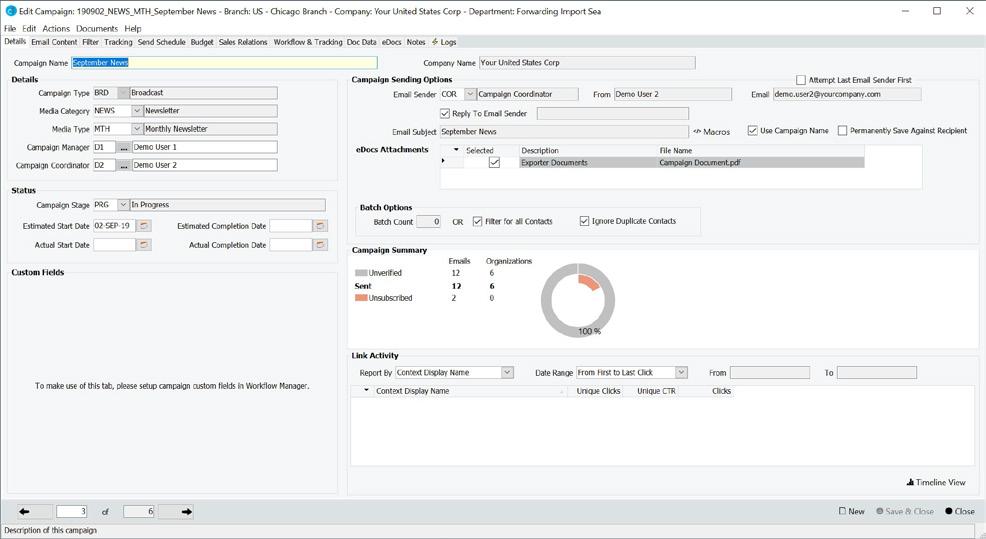
The importance of supply chain visibility and resilience is critical for logistics service providers. Our industry-leading flagship product, CargoWise, is centralizing logistics operations on a single global database, delivering business continuity, scalability, and security.
 - Richard White, Founder and CEO, WiseTech Global
- Richard White, Founder and CEO, WiseTech Global
The logistics industry is a performance-based sector. The ability to efficiently manage goods in transit is measured by crucial factors like speed, cost and accuracy.

However, in today’s increasingly complex global supply chain, meeting these metrics has become more challenging than ever before.
With shifting demands in both the business-to-business (B2B) and business-to-consumer (B2C) spaces, logistics providers must act swiftly to enhance the productivity and efficiency of their operations to meet capacity demands and overcome disruptions.
Recognizing the need for transformative solutions, many industry experts believe that the key lies in increasing digital capabilities and embracing digital practices.
Digital transformations have been ongoing in the logistics industry, but recent unpredictable pressures have accelerated the urgency for faster and more lasting implementations.
To delve deeper into this paradigm shift, we partnered with Reuters Events to conduct a comprehensive survey involving over 480 logistics and supply chain professionals worldwide.
Our objective was to gain insights into how companies perceive and drive productivity across their operations, with a particular focus
on the crucial role technology plays in achieving these goals.
Key findings from our research shed light on the challenges faced by the industry:
1. Lacking measurements of productivity makes building a case for business investment difficult. Surprisingly, more than a third (35 percent) of respondents do not measure productivity or have specific targets to benchmark success. This disconnect between recognizing the importance of productivity and setting measurable targets impedes progress.
2. The COVID-19 pandemic shifted focus from cost to value. Therefore, improved customer service and increased operational efficiency became top priorities for enhancing productivity, overshadowing more traditional financial metrics such as increased revenue and profit. This change in mindset reflects a transition towards “value over cost” sentiments in logistics and supply chain operations.
3. Technology boosts productivity. Investment in technology emerged as the primary driver of productivity, with 45 percent of respondents emphasizing its potential impact. Automation of manual tasks and real-time visibility were identified as key priorities, offering immediate and significant opportunities for efficiency gains.
4. Centralization of data for enhanced visibility is critical to long-term success. Over half of the respondents (58 percent) highlighted the challenge of relying on multiple disconnected systems across trading partners. Connectivity issues, data sharing concerns, and a lack of centralized systems hinder effective data management and productivity improvement. A single logistics platform that integrates multiple data streams can enhance visibility and facilitate the tracking and realization of productivity goals.

As demand continues to grow and evolve, so do constraints on time, money and resources. For logistics businesses to succeed in this increasingly uncertain and competitive landscape, maximizing every aspect of efficiency and productivity is crucial.

With all this in mind, there has never been a more prudent time to update digitally. And with the right investment in the right technology, you can unlock new productivity gains and meet your customers’ needs now and in the future.
Want to learn more about the link between technology and productivity? Download the report now
“It’s really exciting to see desk workers be able to see live dashboards which highlight where shipments need attention well in advance of actual problems, thus proactively enabling decision-making to avoid impacting transit times,” he adds.
The Global Freight Forwarding business at UPS Supply Chain Solutions® has evidently seen unprecedented investment in recent years, from operating systems to big data tools and even the company’s gateway network, with construction recently completed in Chicago and Frankfurt.
A continued focus on sustainability is at the forefront of the company’s investments, exemplified by the numerous electric forklifts and compressed natural gas (CNG) vehicles purchased by UPS Supply
• Ultra-cold freezer donations and in-kind vaccine deliveries to facilitate equitable distribution to remote and rural areas throughout Africa, South America, Asia, North America, and Europe, made possible by The UPS® Foundation
• Three regional 24/7 UPS® Healthcare Command Centers, dedicated to predicting and managing the global vaccine movement to ensure on-time delivery.
• Partnering with Gavi and other organizations to train and manage the ultracold movement of vaccines in COVID-19 Vaccines Global Access (COVAX) countries.
• Delivery of COVID-19 vaccines outside of the US, managing 4,500 movements through the UPS® network and commercial partners since the first vaccines were made available.
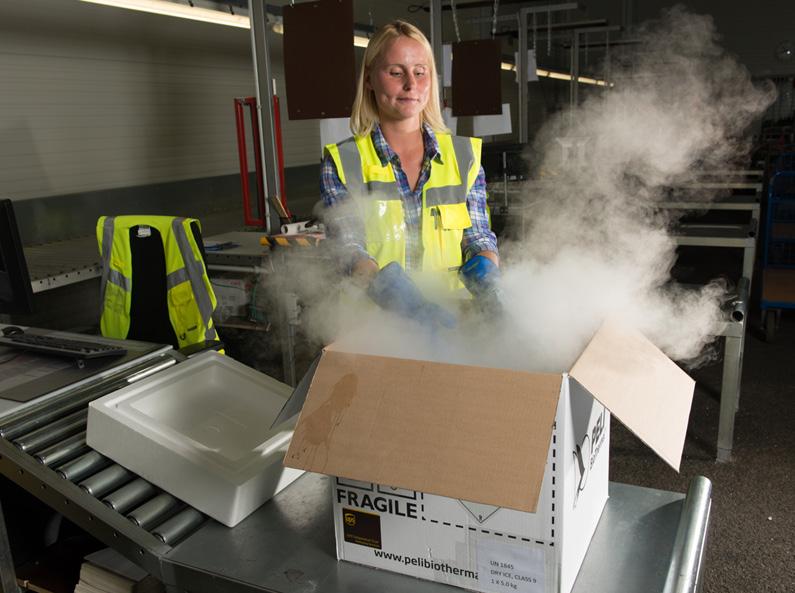
• Embedded UPS® logistic experts in countries including Indonesia and Malawi to fully and safely manage vaccine distribution logistics.
• Support of vaccine doses delivered via autonomous aircraft to clinics in Africa through the partnership between Zipline and Gavi
• Real-time visibility into the location of vaccines through UPS® Premier technology, which provides precise visibility into every single vaccine package.
• Supported over 130 vaccine clinical trials to date through the UPS® Healthcare subsidiary Marken, which is involved in nearly all vaccines and treatments in development today.
Goggin Warehousing is a third party logistics provider (3PL) offering storage, transportation, distribution, and logistics solutions. Simply put, we customize systems to solve complex logistical challenges.

Our priority is to make your job easier and to help your company run more effectively.
www.gogginwarehousing.com

Chain Solutions® to reduce its carbon footprint and minimize its impact on the environment.
For McCorstin, these investments are not only exciting but show customers and operators that the company is serious about moving into the future of freight forwarding.
UPS Supply Chain Solutions®, together with shareholders, customers, suppliers, communities and employees, cares deeply about sustainability.
The company’s culture centers around the values established by the founder of UPS®, Jim Casey, who believed in giving back to the community and being responsible social and environmental stewards.
“Today, we approach sustainability holistically and in alignment with our customer first, people led, innovation driven strategy,” states McCorstin. UPSers know that doing good in the world is also good for business. Thus, sustainability has always been a core value of the company, whose latest sustainability report highlights the progress it is making towards important goals that deliver good in the world, including its goal to achieve carbon neutrality across Scope 1, 2 and 3 emissions by 2050.
Another area of investment for UPS Supply Chain Solutions® is in its new, modern office spaces, which
• Year-over-year 6.9 percent decrease in Scope 1, 2, and 3 CO2e emissions.
• Added to a global fleet of alternative fuel and advanced technology vehicles.
• Purchased 162 million gallons of alternative fuels.

• Eight percent of total electricity is generated from renewable sources for its owned and leased facilities.
• Planted 28 million trees since 2012.
• Expanded the UPS® Sustainability Trailblazers employee engagement program.
“EMPOWERING OUR OPERATORS WITH AGILE DECISION-MAKING TOOLS IS ONE OF OUR TOP FOCUS AREAS”
– JEFF MCCORSTIN, PRESIDENT OF GLOBAL FREIGHT FORWARDING, UPS SUPPLY CHAIN SOLUTIONS®
Through every peak, valley, and plateau, DDC FPO’s data-based goal driven solutions help to achieve your goals.
DDC FPO is a strategic business process outsourcing (BPO) partner for today’s leading transportation and logistics providers that enables clients to focus on core competencies and achieve their goals. As the freightfocused member company of The DDC Group – a worldwide network of BPO companies – DDC FPO is able to serve clients in over 30 languages worldwide.
Solutions include but are not limited to:
• Freight Billing
• DDC Intelligence
• Customer Care (Customer Service & Inside Sales)

• DDC Sync (Intuitive Mobile Data Capture)




• Customs Brokerage Processing

US: +1 303 674 0681 UK: +44 800 011 2750 info@ddcfpo.com www.ddcfpo.com
30+ LANGUAGES
30+ YEARS OF BPO EXCELLENCE 16+ YEARS IN FREIGHT 50% SERVING OF TODAY’S TOP CARRIERS

33 PROCESSING SHIPMENTS BETWEEN COUNTRIES
7000 TEAM MEMBERS GLOBALLY
 – JEFF MCCORSTIN, PRESIDENT OF GLOBAL FREIGHT FORWARDING, UPS SUPPLY CHAIN SOLUTIONS®
– JEFF MCCORSTIN, PRESIDENT OF GLOBAL FREIGHT FORWARDING, UPS SUPPLY CHAIN SOLUTIONS®
accommodate the hybrid working environments popularised during the COVID-19 pandemic.
It was throughout the pandemic that UPS Supply Chain Solutions® also delivered equitable access to critical healthcare services, and worked tirelessly to accelerate vaccine distribution and help keep communities as safe as possible.
The staff and wide range of services played a crucial role in this, as UPS® delivered more than one billion vaccine doses by December 2021.
This impressive milestone was made possible through innovative
approaches, one-of-a-kind UPS® Premier tracking technologies, industry-leading cold chain solutions, and an expansive, sophisticated, global network providing UPS® Healthcare services to customers and communities around the world.
Not only did the global UPS® network support healthcare customers and global organizations, but it also joined in public-private partnerships to provide vaccines and cold chain expertise to hard-to-reach countries, ensuring delivery to as many people as possible.

To achieve this, UPS® Healthcare
mapped roughly 500 trade lanes to enable seamless worldwide vaccine shipments and used more than three million pounds (lbs) of dry ice to help safely move the vaccines.
“UPS® Healthcare set the global pace for COVID-19 vaccine delivery, supported by the unmatched dedication of UPSers and the company’s global logistics capabilities and expertise. Medicines derived from biologics and delivered via cutting-edge cold chain networks represent the future, and UPS® Healthcare is leading the way,” McCorstin acclaims.
Prior to the critical delivery of COVID-19 vaccines, UPS Supply Chain Solutions® was called upon to bring personal protective equipment (PPE) into the US during the pandemic.
This important role came as
“IT IS ABOUT MOVING THE WORLD FORWARD BY DELIVERING WHAT MATTERS. IF THE CUSTOMER IS HAPPY, WE ARE HAPPY!”
part of the US Government’s Project Airbridge, which was created to shorten the amount of time it takes for medical supply distributors to import PPE and other medical supplies into the country.
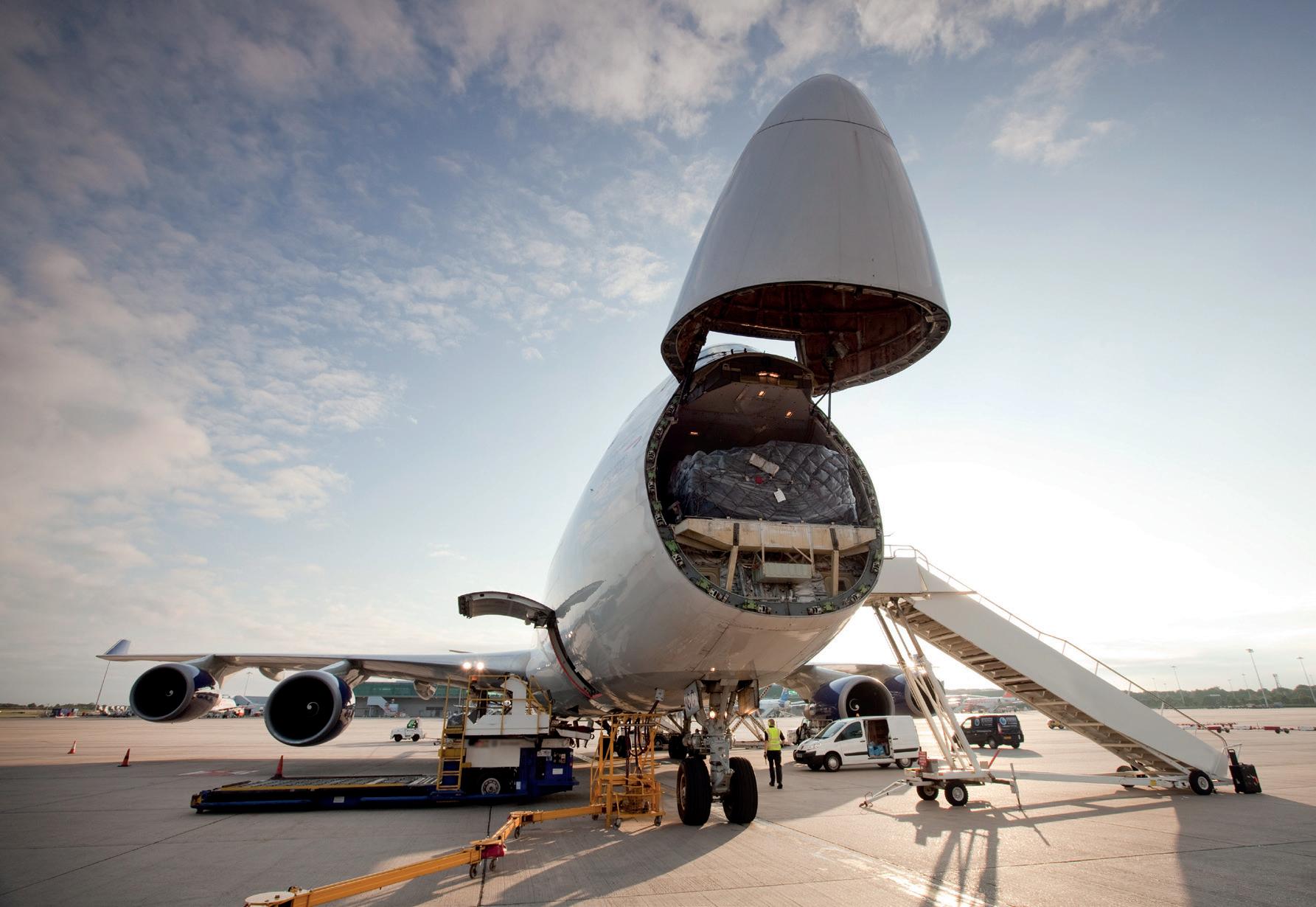




UPS Supply Chain Solutions® was sourced by the Federal Emergency Management Agency (FEMA) to bring PPE into the US, where supplies had depleted over recent years.

“We were a major facilitator of US bound PPE over a three-month period at the beginning of the pandemic. Our first dedicated charter flight was in the first week of April, and by the end of June, we did more than 350 dedicated charters, of which more than 200 were for Project Airbridge,” shares McCorstin.
As an order of magnitude, every one of these aircraft could handle 100 tons of PPE, which allowed the US to open up at a much faster rate than the rest of the world.
Then came the pivot to COVID-19
test kits, of which hundreds of millions were provided by UPS Supply Chain Solutions® throughout the US.
“The pandemic was the most impactful moment of my career because lives were truly at stake,” McCorstin says.
As the world has mercifully emerged from the pandemic, helping customers to navigate constant supply and demand changes in the air and ocean freight markets is paramount for UPS Supply Chain Solutions® in the coming year.
The company is focused on being the global freight forwarder of choice and will therefore also leverage UPS® Browntail air freighters to utilize


available capacity and provide better service to customers, as well as leaning into the growing healthcare industry and supporting both enterprise and small and mediumsized businesses (SMBs).
Additionally, UPS Supply Chain Solutions® will continue to help its customers to reassess their supply chains whilst building out a digitally enabled ecosystem, both operationally and from a customer input and visibility perspective.






“It is about moving the world forward by delivering what matters. If the customer is happy, we are happy!” concludes McCorstin.


with a simple mission: to help local refineries optimize and standardize their operations.
Nearly 60 years later, the business has grown exponentially, evolving to become an invaluable support partner to titans utilizing Factory Automation and Process Technology. This is reflected by its near nationwide reach, as AWC’s customers now span 11 US states across 32 regional support offices.

“Our team embodies a ‘Winning Together’ culture in which our employee-owners, customers, and technology partners collectively succeed because we strive to ‘out know, out care, and out serve’ others in our space,” introduces Kirk Goins, CEO of AWC.
The automation and control industry incorporates a plethora of technical services, from information technology (IT) to mechanical systems. To cater to such a multitude of products and brands, AWC Incorporated (AWC) has built a solid reputation as the authorized local sales, support, and service partner for leading manufacturers of automation and control systems.
AWC was founded in 1965 by three engineers as a local manufacturing representative in the Baton Rouge area of Louisiana, Kirk Goins

AWC is uniquely positioned to deliver customers significantly more value with expert support and dedicated engineering services. As an authorized distributor and service partner of products and solutions to customers across a broad geographic area, AWC supplies innovations from the world’s leading technology factory automation and process technology companies like Siemens, Phoenix Contact, Honeywell, Farris, Valmet, and many more.
AWC’s driving mission remains “to provide customers the indispensable support necessary to help them achieve their business goals in a safe and efficient manner,” Goins explains. This explains why the company’s customer base spans many verticals, including oil and gas, pulp and paper, automotive, water and wastewater, food and beverage, and many other industries.
We speak to CEO Kirk Goins, who discusses the importance AWC Incorporated’s valuable position as an all-round service provider in the automation and control industry
Lucy
| Project Manager: Kieron Harvey




Expand your automation freedom with PLCnext Technology from Phoenix Contact. PLCnext is an open industrial automation platform with limitless possibilities that expand the use of a PLC in ways that have changed the future of automation. Open with Linux, PLCnext is IIoT ready, o ering multiple cloud connection options. Explore programming capabilities with the potential to be networked for easy monitoring. With apps available on the PLCnext Store to save programming time and PLCnext Engineer software available as a free download, it’s easy to implement into your control system.

It’s a proven technology that many of our customers have already adopted. Visit www.phoenixcontact.com/open to learn more about what you might be missing out on.







Control cabinet designers must constantly rethink their processes to remain competitive. Since its founding in 1923, Phoenix Contact has collaborated with customers across nearly all industries to improve the reliability and e ciency of industrial applications.




Today, Phoenix Contact provides comprehensive solutions to optimize processes and save time. The COMPLETE line perfectly coordinates hardware and software to streamline processes, giving you the peace of mind and competitive edge needed to succeed in today’s highly complex manufacturing world.
No other function in your control cabinet impacts overall system performance more than reliable power. Phoenix Contact has all the necessary components to reliably protect, convert, monitor, and distribute low-voltage power within your system. High-performance surge protection and circuit breakers protect equipment from transient overvoltage and overcurrent disturbances. Transmission of those disruptive events to a “cloud” enables preventive maintenance.
Redundant solutions or batteries supplement the DC power supply when needed, safeguarding low-voltage power, even in critical situations. In addition, future-proof monitoring systems save energy in the overall system. Innovative solutions for AC or DC potential distribution reduce space requirements and installation times in the control cabinet.
Connections in the cabinet, through the cabinet, and in the field are the bridge between the field-based sensors and logic controlling a system.

The automation and control level reads inputs and drives outputs. These devices must be connected by secure discrete wiring or through networks.
These same devices must be reliably powered, which requires e cient distribution and marshaling to energize and balance loads. Loads can range from small milliamp signals to high-horsepower motor connections.
Analog signals often require special functionality at the connection point, such as testing, measurement, or fusing. Specialty terminal blocks support these functions. When >>>

Industrial solutions from sensor to cloud
system complexity and I/Os increase, networking field signals outside the enclosure is often a more e cient way to integrate larger systems than point-to-point wiring.
Every signal has a specific purpose, and not all signals are the same. Sometimes along the journey, signals may need to be isolated, amplified, or converted to serve their purpose. Ensuring the signal’s mission is accomplished can be as simple as choosing a universal product, or it might require digging deeper and allowing the application to dictate product selection.
The COMPLETE line system has numerous options to transmit signals reliably. From controller and connectivity solutions to sensors and motors, this group of products ensures the right switching at the right time.
Functional safety management starts at the top and should encompass an entire company strategy. In application, safety is applied in two major areas: machine and process..
Machine safety can be as simple as a single safety sensor tied to a safety relay controlling a motor, or as complex as multiple fail-safe PLCs with distributed safety I/O networked throughout a factory. No matter how large your system, it will always have three pieces: inputs, outputs, and logic.
Process safety is usually larger in scope, making it inherently more complex. In addition to controlling inputs and outputs, some signals from the field come from explosive areas and need to be properly conditioned. Over-voltage protection and power redundancy also become necessities in a continuous process.
Time is money. The tools and resources used to build your control cabinet are key to controlling costs. Design software, marking systems, industrial tools, wire management, and cabinet accessories are often overlooked. Careful consideration of these products reduces errors and production time, translating directly to the bottom-line profitability of any shop floor. All aspects of your cabinet design and build will require tools and equipment on the shop floor. Wires and components in and around the cabinet will need to be processed, organized, and identified. This family of products ensures the production of a high-quality cabinet.
The heart of your control cabinet is the logic platform. For OEMs and control engineers alike, it has never been easier to build smaller, smarter machines fast. This lets builders free themselves from using controllers and equipment based solely on prior familiarity or specifications. Industrial PCs/HMIs and scalable controllers can streamline functionality, reduce equipment and costs, and usher in the next generation of intelligent machine automation.
Control systems can range from simple, single-function control to real-time SCADA applications.
The modern factory, driven by the Industrial Internet of Things (IIoT) and big data, must handle increased network tra c and the possibility of internal or external vulnerabilities. Phoenix Contact networking and security products support many technologies, so you can design and implement scalable, reliable, and high-functioning systems.
Ethernet infrastructure devices provide everything from basic connectivity to advanced managed switches, with options that include powering end devices, field-wiring connectivity, and converting between physical media. Network security can properly separate the IT and OT networks and protect critical assets.
Cellular remote connectivity powers communication with devices around the globe. The increasing capabilities of cloud services provide the support and data management needed for IIoT. Wireless technology enables convenient, reliable, and cost-e ective communication, either on the factory floor or to remote sites miles away.
Phoenix Contact stands behind its products with the industry’s most comprehensive Limited Lifetime Warranty. The LLW is our promise to you that the products you install in your control cabinets are built to last.
Register today at: www.phoenixcontact.com/LLW
Phoenix Contact and AWC work together to bring innovative products and world-class service to customers in the automation and control industry. From connectivity to control, Phoenix Contact gives you the confidence you need in your production systems.










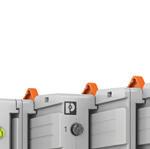



Intuitive circuit breaker system


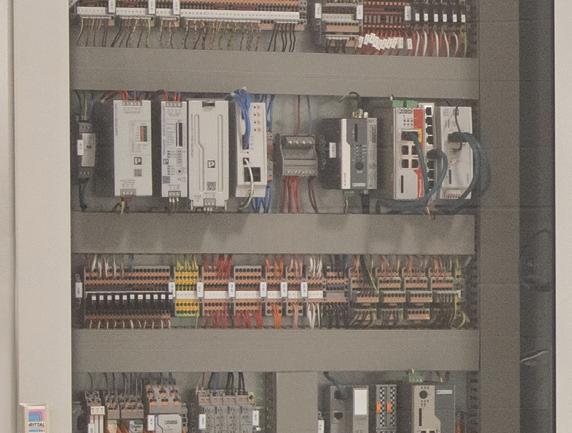
From connectivity on the machine to through-panel and in-cabinet wiring, Phoenix Contact gives you the confidence you need in your production systems.














CAPAROC is your customizable electronic circuit breaker system for overcurrent protection in 12 V to 24 V DC applications. The CAPAROC system uses data-driven power modules to customize overcurrent protection. With numerous feed-in power modules, circuit breakers, potential distribution modules, and current rails, CAPAROC makes it easy to design an intelligent communication system.
Learn more at www.phoenixcontact.com/us-caparoc
For example, AWC is particularly proud to be a key partner in the success of the U.S. Navy Fleet Oiler (T-AO) Program. This fleet of oilers for the U.S. Navy is designed to transfer fuel and cargo to its carrier strike groups operating at sea. AWC was tasked with designing, building, and implementing critical power and control components of the lead ship in the class (T-AO-205), named in honor of Rep. John Lewis (D-Ga.).
The oilers feature the capacity to carry 162,000 barrels of oil, a significant dry cargo capacity, aviation capability and a speed of 20 knots. The first ship was successfully delivered, with Ship 2 (USNS Harvey Milk) ready for final delivery to the US Navy, and Ship 3 (USNS Earl Warren) preparing for Sea Trials later this year. As the company approaches Ship 9, the Navy has already committed to procuring 16 vessels in the T-AO(X)
Class, and excitement is building for future projects.
“Supporting and servicing customers with diverse challenges across multiple industries provides rewarding experiences and outcomes for our automation and controls experts and customers. It also allows us to remain strong during economic downturns or if one segment grows/ falls disproportionately to others,” recalls Goins.

However, in the present economic environment, AWC is experiencing a strong demand across all sectors, and the company is anticipating positive impacts from emerging advances in the Internet of Things (IoT) and artificial intelligence (AI).
“We are beginning to turn a corner in the ongoing global supply chain disruptions and workforce challenges affecting lead times and availability in the manufacturing and industrial parts
industry,” says Goins.
AWC is looking forward to seeing how the significant trend in reshoring manufacturing plays out in the North American market. Such trends and changes in the industry make for a dynamic and forward-thinking environment for AWC.
A dependable and connected supply chain is fundamental to the successful operations of AWC’s customers, therefore, technical partner relationships are the most important component of the company’s “Winning Together” mantra.
Despite facing recent headwinds in supply chain operations, the close collaboration with technical partners has carried AWC through the storm, so it can diligently continue to help its customers achieve success.
“WE LIVE BY OUR MISSION OF EMPOWERING PEOPLE TO MAKE THE GREATEST POSSIBLE IMPACT ON THE COMMUNITIES AND FAMILIES WE SERVE TOGETHER”
– KIRK GOINS, CEO, AWC INCORPORATED

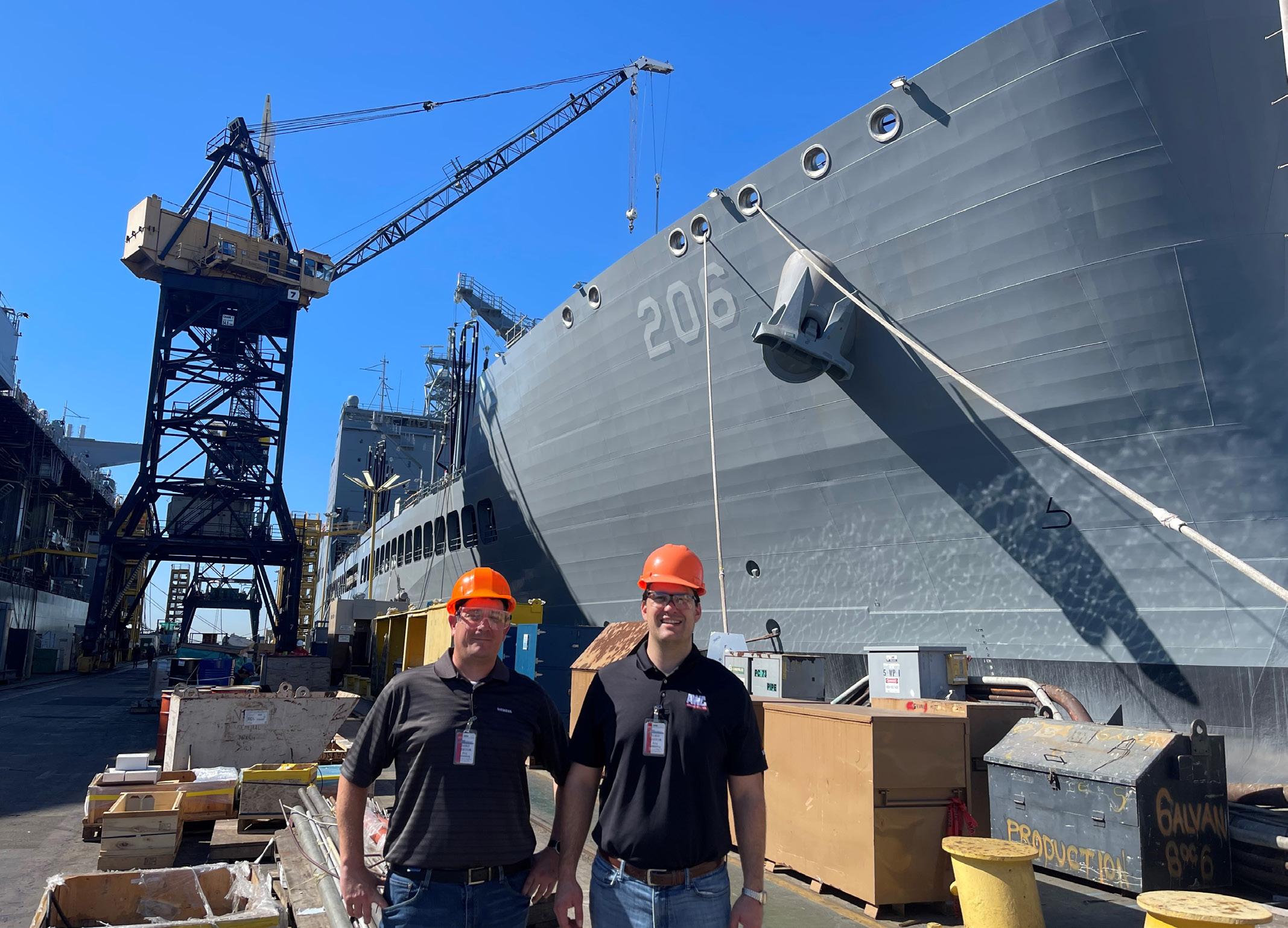
It’s an exhilarating time for industrial enterprises. The US is seeing considerable growth from reshoring and infrastructure projects are thriving. Although inflation and labor shortages are introducing new stresses, that pressure is accelerating the uptake of new optimizations and automations. The most momentous change, however, is artificial intelligence (AI). The pressure’s on for industrial businesses to digitally transform and harness AI to forge ahead in the modern industrial landscape. Seizing the moment will bring added precision, clarity, and foresight to business decision-making to maximize production and value. The baseline for those discoveries is, of course, data.
For many industrial companies, this is where the dream of digital transformation dissolves into a series of question marks. The predominant question is: “How can we get data from our industrial systems?” Those who run small-to-medium-sized operations have far-reaching goals, but the stakes are high. No matter how much capital there is to play with, digital transformation is a substantial investment.
For industrial leaders, digital transformation is a messy business. It’s not ones and zeros, instant uploads, and seamless connectivity. There’s the physical world to contend with. Industrial equipment might be bolted to factory floors in isolated regions or scattered through remote areas plagued by extreme weather. A single operation might encompass hundreds of pieces of legacy equipment in manufacturing facilities dotted across the country. Industrial companies are eager to embrace data and leverage digital tools to grow, learn, and scale. But, they need no-nonsense ways of extracting data from operational technology (OT) to succeed.

As with most significant change opportunities, the first mile is the hardest mile. It’s a challenge to access industrial data platforms from remote and rugged field sites. Any system worth the investment needs to be robust and resilient to survive those conditions and derive and deliver data.
Furthermore, a lot of perfectly well-functioning industrial and manufacturing processes have evolved over decades. Old machines that have stood the test of time are fixed to plant floors alongside state of the art equipment. That wild mix of legacy and new technology is commonplace but complicates data extraction. Industrial companies need simple data access solutions that can speak across their systems, however varied, unique, or outdated. Without them, data stays locked away.
Many enterprises consist of decentralized assets. To derive insights, they need to access equipment installed on site and securely bring data to a central location. That might involve access to older controllers and remote field sensors actuators and integration with multi-vendor environments.
Whether it’s robots in an automotive plant or wind turbines across a vast geographical area, those assets need to connect Installations need ruggedized networking solutions and industrial Ethernet switches to direct and secure outgoing data without interruption. Once that reliability is achieved, those can plug into analytics engines and optimization programs to drive industrial efficiency.
Finally, companies need to visualize data, to make it actionable on site and beyond. Operators need durable and flexible industrial panels to integrate data across multiple devices, protocols, and the cloud.
Access, connectivity, and visualization devices might seem like separate elements, but together they form the critical bridge between operations and information. OT and IT departments have traditionally had different priorities and strengths, but the right hardware and software configurations put them on the same path. Red Lion has worked with industrial systems and data for 50 years. We’ve seen IT emerge, and we understand the evolving needs of both IT and OT audiences. For OT and IT to serve each other, enterprise connectivity solutions need to be simple to use, resilient, intuitive, and secure. They need to be durable and deployable right out of the box.
Companies like AWC Inc., have helped businesses transform and thrive with Red Lion’s FlexEdge® Intelligent Edge Automation Platform. As a networking router, protocol converter, advanced

Industrial Internet of Things (IIoT) gateway, and scalable edge controller, it’s an all-in-one platform that bridges OT and IT –connecting assets, delivering data, and improving productivity at the edge.
DATA ISN’T MAGIC – IT’S AN INVESTMENT
Companies across sectors are seizing the moment by investing in digital technology to make operational improvements. The way industrial companies can get results from those investments is through data.

People who’ve worked in the industrial space for as long as we have are hardwired for different kinds of challenges and solutions. We’re entering an amazing new era of AI-powered productivity, but no matter how dazzling it might seem, data isn’t magic.
Industrial companies need someone who understands the particularities of industrial data and can traverse that treacherous
Red Lion is focused on being THE Industrial Data Company™. We empower industrial organizations around the world to unlock the value of data by developing and manufacturing innovative products and solutions to access, connect and visualize their information. Red Lion’s global manufacturing and support facilities serve customers in factory automation, alternative energy, oil and gas, power and utilities, transportation, water and wastewater industry segments. We provide scalable solutions for cloud connectivity, edge intelligence and asset management, industrial Ethernet switches and industry leading panel meters and operator panels, to make it easy for companies to gain real-time data visibility that drives productivity. Red Lion is part of Spectris plc, the experts in providing insight through precision measurement.
first mile. They need someone who can access data in hardto-reach spaces and from legacy technology that works well for a reason. They need someone who knows how to deliver that information efficiently, securely, and intact, to different communities of users.
They need a trusted partner to unlock the promise of digital transformation to maximize value from that investment. We are that partner. We are THE Industrial Data CompanyTM

To discover how Red Lion products can help you securely access, connect, and visualize your industrial data, visit www.redlion.net.
Worldwide Headquarters: 1750 5th Avenue, York PA 17403 USA
T +1 (877) 432-9908 | info@redlion.net
“When we work together, we achieve amazing results,” Goins highlights. “Through hard work, our processes and relationships will be even stronger when the supply chain is restored to pre-COVID-19 levels of reliability and robustness.”
AWC’s comprehensive network of people and technology partners sets it apart from other manufacturing entities in the North American market. The company is committed to its customers, partners, and employeeowners to create a collective focus on achieving its objectives and reaching success.
Moreover, as an employee-owned company, team members are the core of AWC, and as such have an unshakeable dedication to the business.
“We know this makes a difference as our teams are empowered to creatively problem solve for the benefit of our customers and technical partners,” Goins continues.
Technology Partnerships: Building unmatched technology insights and expertise as the local business partner for global technology manufacturers.
Applied R&D: AWC’s “Thincubators” allow engineers to continuously evaluate new automation and controls technology to find cost-effective solutions to industry challenges. Digital Technology Labs (DTLs), meanwhile, provide a safe place to test new ideas, validate technologies and work through integrations.
Consulting: The AWC consultancy team can highlight new opportunities in programmable logic controller (PLC) automation, flow control, electrical power, and much more.
Workforce Optimization: AWC ensures clients have the team they need (internal and external) to effectively design, build, operate, and support their customers’ automation and control systems.
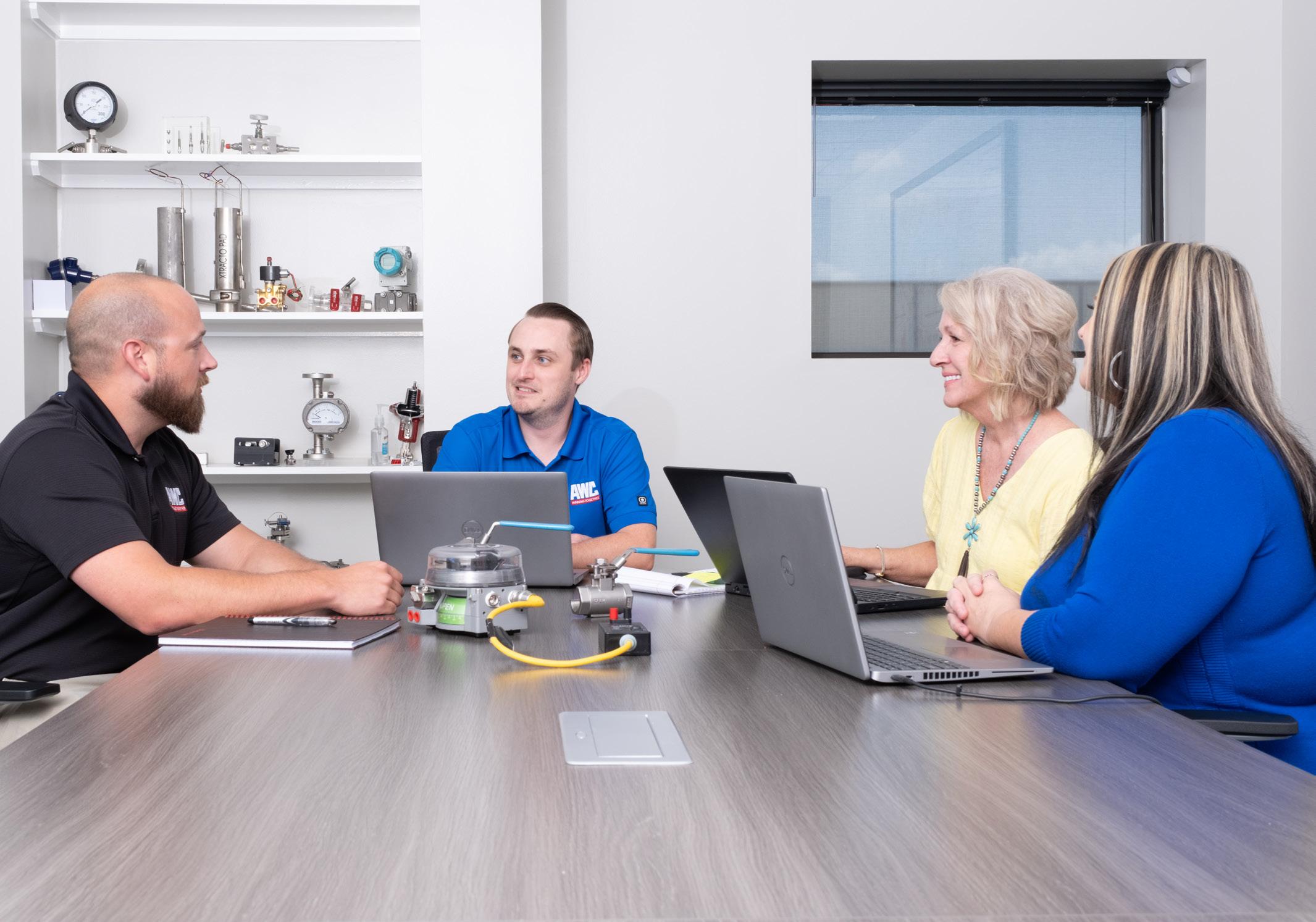
Distribution and Logistics: AWC’s supply chain team make sure clients have the right products at the right time and place.
Systems Integration: The engineering, design and project management teams can fill technical resource gaps in either an a la carte or turnkey approach with internal and certified partner resources.
Life Cycle Optimization: The technical support and services teams provide proactive and responsive support.
When it comes to bringing energy efficiency to your business, where should you begin? And how can you implement quick and easy changes without affecting your long-term strategy?

The answers could be hiding in plain sight: Your fans and pumps may seem a small part of your overall operations, but reducing their speed even a little can result in substantial energy savings. With AC Drives, you can easily optimize your fans’ and pumps’ performance and instantly save on your energy bill.
Scan the QR code below to see 9 tips to start saving on your energy bills.
Scan to view 9 tips to start saving on your energy bills

 Deer Park team
Deer Park team
“WHEN WE WORK TOGETHER, WE ACHIEVE AMAZING RESULTS”
– KIRK GOINS, CEO, AWC INCORPORATED
The team structure guarantees efficiency and streamlines operations for swifter responses and more nimble, customized solutions.
Another core belief of AWC is its wider responsibility to the communities in which it operates. “At AWC, we feel it is critical that we are responsible members of the communities in which we live, work, and conduct business. As such, we live by our mission of empowering people to make the greatest possible impact on the communities and families we serve together,” Goins comments.
As AWC rapidly expands its workforce, it is positioned to continue enriching the lives of even more communities. “We have the best team in our sector, and we want to ensure continued investment in hiring, development, and training.”
To facilitate this, AWC continues to invest in tools and technology in support of safety, quality, and

efficiency. In recent months, several exciting initiatives have been launched, including specialized manufacturer-led training, investments in STEM programs and projects, plus a robust college-level engineering internship program.
Beyond community-centric activities, AWC is a vital part of industries shifting towards a greener future. AWC’s technologies and services are becoming increasingly critical, particularly for aiding customers in the adaptation and conversion to electric capabilities via innovative energy technologies.

AWC is on the front lines of several innovative developments which will incorporate its vast portfolio of Factory Automation and Process Technology services and capabilities. One such initiative utilizes hydrogen as the green energy of the future
to create portable power units for customer equipment, vessels, and remote facilities. AWC’s experts are harnessing the newest technologies to marry together the chemical and electrical segments to create a holistic solution within the context of green energy.

Other innovative green projects AWC is currently working on include an electric vehicle (EV) manufacturing and charging station design, space exploration initiatives, and 3D home building technology, all designed to amplify the work the customers are making in green energy.

Much like the high precision components that are its specialty, Precision Solutions by Hyperion (Precision Solutions) is a meticulously manufactured enterprise.
As a business unit of esteemed manufacturer Hyperion Materials & Technologies (Hyperion), Precision Solutions excels in working with hard and ultra-hard materials, such as tungsten carbide, ceramic, and diamond.
The unit itself has been carefully formed over the past few years through the acquisition of companies and the attentive cultivation of strategic relationships to form an entity that boasts the US’ leading precision capabilities.
For Precision Solutions’ Senior Vice President, Biju Varghese, this gradual assembly sought to fill a customer demand that had been previously unmet in the market and subsequently provided the
fundamental reason for the unit’s formation.
“We identified a need and a demand for a credible and comprehensive supplier of precision hard and ultra-hard components and solutions,” he introduces.
Serving a vast array of over 1,000 blue-chip customers across the energy, aerospace, general industrial, medical and electronics industries, the demand that Precision Solutions’ comprehensive offering caters to is
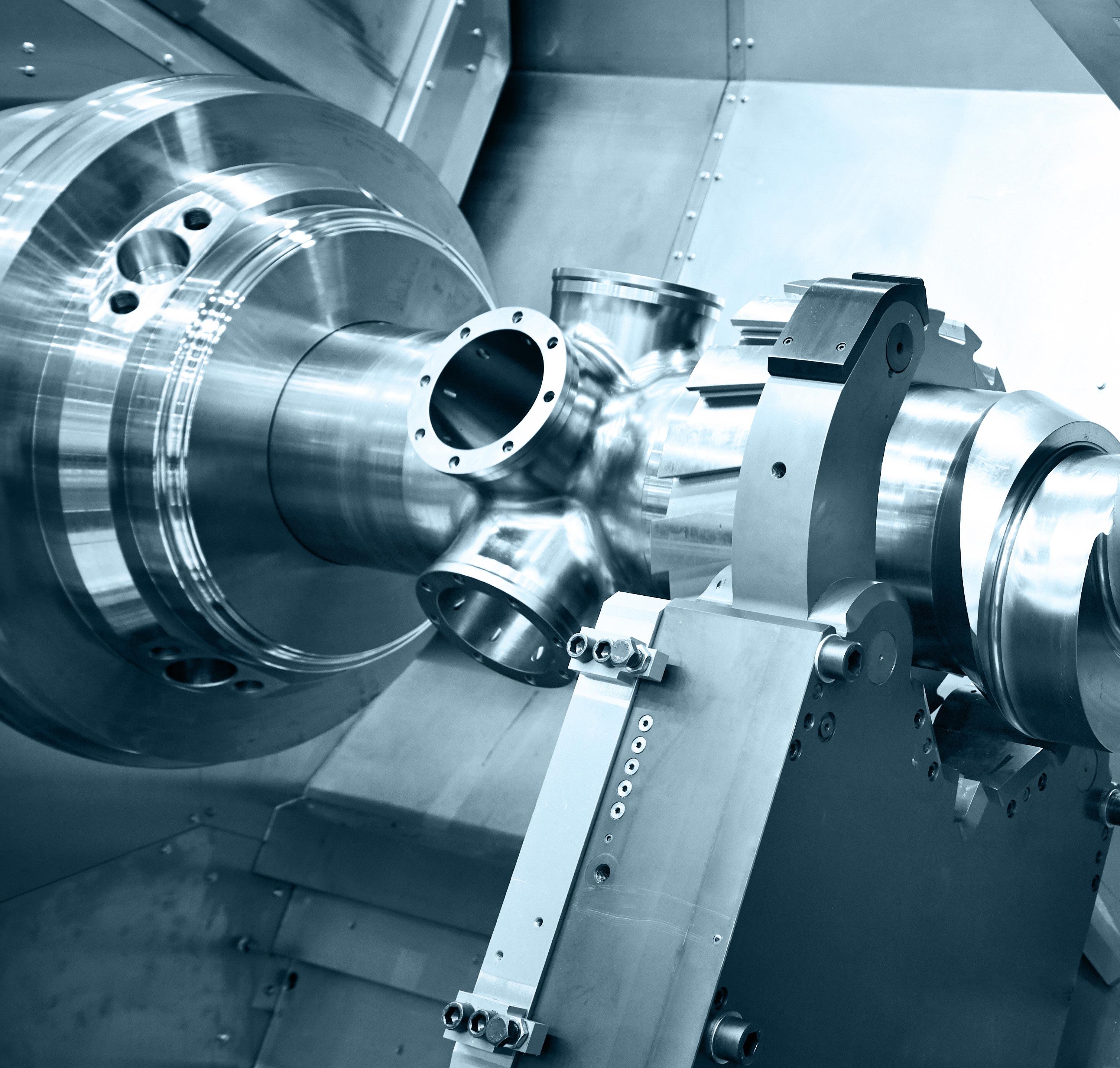
Channelling unsurpassed materials expertise, Precision Solutions is an integral business unit for Hyperion Materials & Technologies. Senior Vice

Writer: Phoebe Harper | Project Manager: Kieron Harvey
only anticipated to grow.
“Precision Solutions is our branded way of serving customers with our deep materials expertise and unmatched breadth of precision finishing capabilities and solutions under one roof,” Varghese continues.
The diminutive size of the products in which Precision Solutions specializes belies the vast impact that the company has across its wide-reaching
operations and their critical applications.
Its primary service offering entails the manufacture of precision components specifically to customer specifications, all the way from powder to final finished product. This could include the precision tools necessary for composite


trimming in aerospace, ultra-precise fluid dispensing nozzles capable of dispensing one nano-liter (nL) droplets at a time, miniature fiber optic wire drawing and gyroscope pins, or complex assemblies for oil and gas applications to name but a few.
In addition, Precision Solutions offers grinding, electric discharge machining (EDM) and other ultra-precision finishing processes as a service.
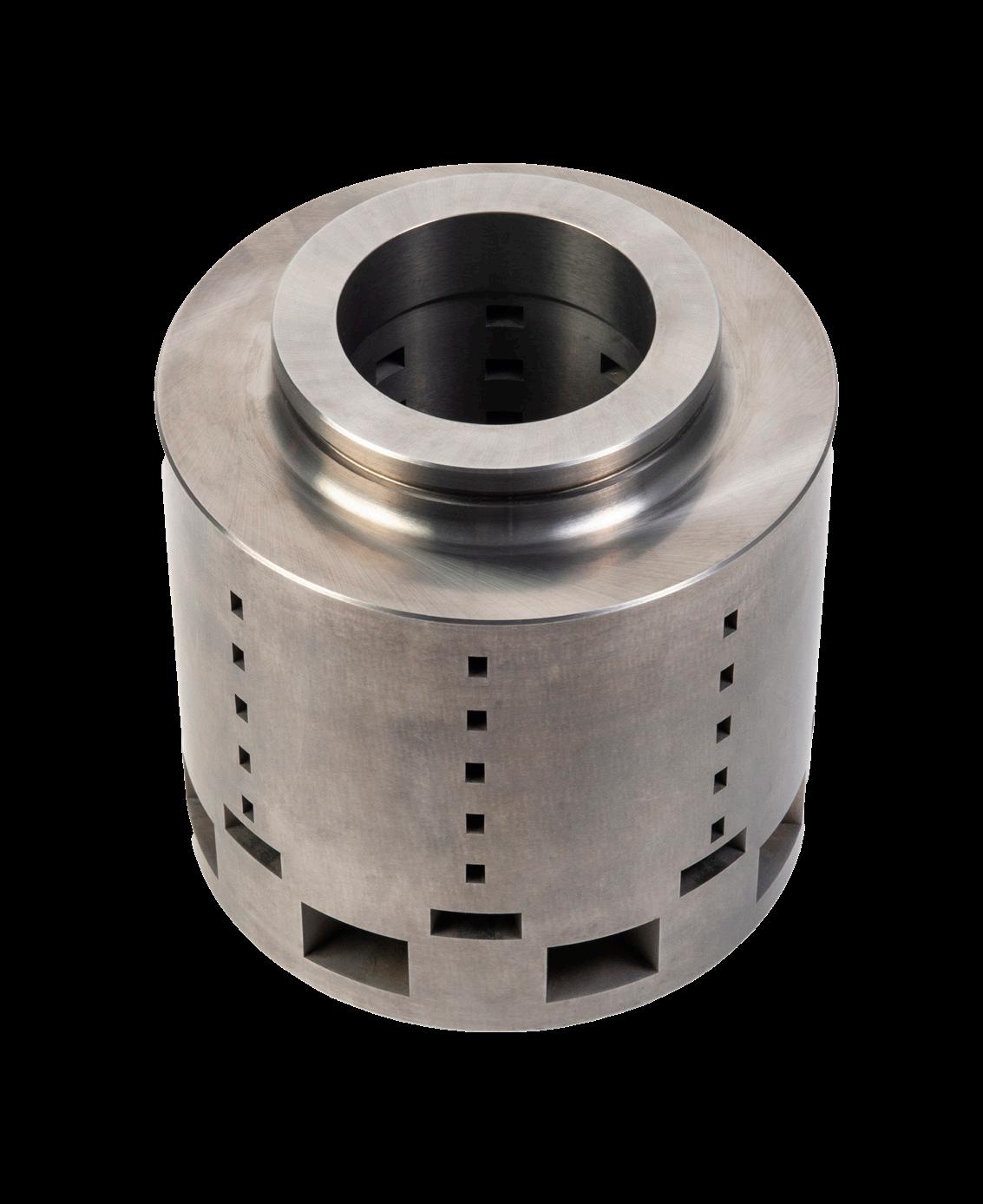
“Our capabilities include producing miniature products with features typically less than 0.1 millimeter (mm), holding tolerances of less than one micron and surface finishes less than 0.01 microns. We also produce large tungsten carbide components up to 0.5 meters (m) in diameter and everything in between,” Varghese elaborates.
The components themselves are produced within five plants located across the US in Michigan, Pennsylvania and near Chicago, needs. This includes an operational footprint of production facilities in
Europe and Taiwan, with a total of 17 manufacturing plants globally.
Each of Precision Solutions’ five plants brings a distinct set of capabilities that interact intimately on a daily basis. Crafts Technologies in Elk Grove Village (Illinois) specializes in precision micro-finishing, while GLE Precision in Bridgeport (Michigan) handles ultra-precision components and surface finishes. Elsewhere, the Aggressive Grinding Service plant in Latrobe (Pennsylvania) boasts the US’ leading capabilities of outer diameter (OD) and inner diameter (ID) grinding, and the unit’s latest acquisition of Dura-Metal Products Corporation in Irwin (Pennsylvania) specializes in EDM technology, multiaxis machining and large component grinding.

“They essentially form a network of facilities that Precision Solutions can use to produce products to our customers’ specifications,” he says.
For Varghese, the global coverage that comes with being part of the Hyperion umbrella and its subsequent ability to directly engage with clients and deliver customer-specific value is “a unique and differentiating aspect” that sets the business apart from other market competitors.
Another essential differentiator is the company’s unmatched breadth of precision capabilities, which effectively positions Precision Solutions as the ultimate one-stop shop in tailoring both material selection and production to the bespoke request of the customer.
“Our finishing capabilities span the entire breadth of the finishing process, including 3- and 5-axis machining, OD, ID, surface and jig grinding, all types of EDM, lapping, honing and superfinishing – all within one company,” Varghese explains.
Diamond-carbide valve assembly – The valve is used to accurately meter the flow of fluids in a complex oil and gas extraction assembly. Fluid flow control is realized by two mating surfaces with complex porting patterns that slide relative to each other. In order to reduce the wear experienced by the surfaces during repeated opening and closure of ports and to enable ultra-precise control, the mating surface is made of polycrystalline diamond (PCD) and precisely aligned and attached to a carbide valve stem. Manufacturing of this valve assembly involved more than 12 precision finishing operations – many of which had to be made using external vendors. Precision Solutions’ network of plants allows it to internalize all of those precision finishing operations and implement an optimized product flow path. As a result, the number of hand offs reduced by 67 percent, the distance travelled reduced by 70 percent and the lead time reduced by 40 percent, delivering a major win for the customer.
“This example is a testament to the power of how our network of plants can work together” - Biju Varghese, Senior Vice President, Precision Solutions by Hyperion
“While a typical component producer may only have a few of these capabilities and have to sub-contract the rest, we are in a unique position to produce almost any precision component within our business and produce them to scale. This helps deliver products and services to our customers with full responsibility for quality, lead-time and service.”
The third defining factor for Precision Solutions is its deep materials expertise in design for manufacturing (DFM) and precision manufacturing, particularly as an established leader in tungsten carbide and diamond materials.


“OUR REPUTATION AS A CARBIDE SUPPLIER, THE BREADTH OF PRECISION FINISHING CAPABILITIES, OUR PROFESSIONAL APPROACH, QUALITY AND DELIVERY COMBINE TO GIVE US A SIGNIFICANT COMPETITIVE ADVANTAGE”
– BIJU VARGHESE, SENIOR VICE PRESIDENT, PRECISION SOLUTIONS BY HYPERION
“We have a team of over 35 R&D engineers developing new materials for specific applications such as improved wear resistance, corrosion prevention, and lightweighting,” Varghese shares.
Electric vehicle (EV) battery slitting operation – The unit has developed a slitting tool used for cutting aluminum and copper foils that are used in EV batteries.
A key aspect of this operation is to ensure extremely high cut foil quality – i.e. the cut foil needs to have a clean-cut edge without any fraying. To achieve this high quality cut, the technical teams at Crafts Technologies, West Branch and Latrobe jointly worked to develop a high performance slitting tool. Subsequently, they designed a suitable tool that has extremely tight flatness tolerance and a superior cutting edge sharpness produced using a proprietary finishing process that includes a polished surface finish of 1-2 microinches.
This newly developed slitting tool was evaluated in a customer test and produced cut foils with “zero” frayed edges, which was a vast improvement compared to foil cut edges produced by conventional slitting tools used today.
“Our solution helped establish a credible, high-quality domestic supply for slitting tools. It was a major win for customers as it significantly reduces downtime and concurrently improves EV battery performance.” -
 Biju Varghese, Senior Vice President, Precision Solutions by Hyperion
Biju Varghese, Senior Vice President, Precision Solutions by Hyperion
Complementing this expertise, the company’s team of DFM engineers leverages decades of hands-on process engineering experience covering the entire journey of precision tungsten carbide production.
“We are not aware of any other company serving this space that can achieve the level of efficiency and quality Precision Solutions offers its customers,” he enthuses.

Looking to the years ahead, Precision Solutions will pursue growth
along three strategic vectorscommercial excellence, innovation and programmatic acquisitions – to achieve its ultimate ambition.
“We aim to be the premier supplier of precision solutions for hard materials in the Americas and Europe,” states Varghese.
This will involve significant investment in further bolstering the unit’s existing capabilities while simultaneously branching into new areas by expanding its portfolio, widening its geographic footprint and enhancing its access to attractive markets.
One such dynamic area is the European market, where Precision Solutions has identified the same emerging demands that initially led to its inception in the US.
“We are seeing trends that include an increased focus on secure supply chains, ever increasing needs for shorter lead times, and the regionalization of supply chains. These trends have reinforced the need for a European-based network of
plants within Precision Solutions and it is an area we are actively pursuing as a new strategic move,” he tells us.
As a result, the unit has started to significantly enhance its capabilities in the Barcelona production plant while investing to enhance its innovation and product development capabilities in Europe.
This European development is one of the trifecta of priorities that defines Precision Solutions’ outlook for the
future, alongside driving business growth at above market rates, and deepening customer engagement through improved prototyping speed and DFM consultation.
With these priorities in line, Precision Solutions will continue to evolve as the manufacturer of miniature components that make a mighty impact across the US and Europe.

Tel: 1-800-343-0636
precisionsolutions@hyperionmt.com
www.precisionbyhyperion.com

“WE AIM TO BE THE PREMIER SUPPLIER OF PRECISION SOLUTIONS FOR HARD MATERIALS IN THE AMERICAS AND EUROPE”
Plastic is a life-changing resource and one of the most influential inventions in history. However, the same qualities that make it incredibly useful as a material have led to a colossal global waste challenge.
Aiming to solve this dilemma while innovatively traversing the broad US manufacturing industry, Petainer was founded to develop packaging solutions that minimizes its customers’ impact on the environment.

“In the US, we focus exclusively on beverage markets – beer, wine, liquor, coffee and water - and it’s fair to say that these sectors are undergoing some drastic, revolutionary changes at present,” introduces Chris McEwan, President of Petainer.
Having joined Petainer in 2011, McEwan entered the company as Group Financial Controller, using his role in the financial division to drive growth and profitability.
He was later involved in overseas expansions and in 2016 took on the position of Group Business Development Director, tasked largely with growing the Petainer global footprint across Asia and Latin America, centered around the more unique parts of the product range.
Today, as Petainer’s President of the Americas region, McEwan is responsible for all commercial, supply chain and other activities taking place in the area.
Petainer is a responsible PET manufacturing business striving to design and produce highly innovative, circular products that can be collected, reused or recycled. We take a deep dive into the company’s success story with President,
Chris McEwan
“It was evident to me when I joined Petainer they had a slew of sustainability-based packaging products and ideas they wanted to bring to market,” he recalls.
“Even in 2011, it was clear that packaging had to evolve at a fast pace, and I felt the company had a great vision and position to do that – from its returnable bottle range to its appetite to lead the market in ever-higher proportions of recycled materials.”

 Water cooler bottle production at the Idaho plant
Water cooler bottle production at the Idaho plant
Petainer offers a wide range of lightweight, sustainable polyethylene terephthalate (PET) packaging solutions, helping its many clients grow their businesses and reduce their carbon footprint.


“We have over 35 years of experience designing and manufacturing high-quality, cost-efficient products with circularity at their core while meeting the highest industry standards for safety and product protection,” McEwan sets out.
Aiming to support decarbonization, Petainer produces one-way PET bottles, refillable and one-way water cooler bottles, one-way kegs, preforms and refillable bottles. This is part of the company’s wider ambition to create a circular economy for PET resin, in order to ensure all products are reusable or recyclable and to transform waste into a valuable resource.

“We guide our clients through every step of the packaging process to optimize the design of their products and provide lighter, easy-to-recycle, solutions tailored to their business,” he elaborates.
“In the packaging world, dropping small amounts of weight can have a
huge effect when multiplied across a year’s worth of supply.
“Proportionately, we are one of the largest users of PET in single-use containers and we lead the way in refillable bottles for the beverage industry.”
around 300 employees, with many team members now celebrating 20 years of esteemed service.
Petainer is proud to be owned by Ara Partners, a US-based investment house which specializes in carbon reduction-driven private enterprises. Its mission is to decarbonize the global economy through better, more environmentally friendly business models.
Founded in 2017, in Houston, Texas, the company’s investment strategy has now expanded successfully to Europe. Sectors which have been invested in so far include industrial and manufacturing, chemicals and materials, energy efficiency and green fuels.
Today, Petainer manufactures worldwide, aiming to supply products as efficiently and sustainably as possible. The company takes a regionalized approach to key markets in Europe, the Americas and Asia to ensure that it offers customers commercial, product and technical expertise. Across its sites, Petainer has

“The Ara Partners team itself is made up of carbon reduction specialists who can truly partner with our management teams to assist in improving the supply proposition for end users,” explains McEwan.
This investment strategy is based on supporting Petainer’s operating base. As part of the acquisition, Ara Partners has made clear its support of “reuse” as a key sustainability solution.
Funds have now been made
available for Petainer to expand the production of its refillable bottles and watercoolers to Western Europe and Central America, adhering to the core of Petainer’s mission – to support the decarbonization of well-established markets.
“We offer brands and producers a way to reduce their Scope 3 emissions, whilst giving customers
Chris McEwan, President: “People are our greatest asset. Unlike many companies with our global footprint, we operate as one with a very flat hierarchy that allows the easy dissemination of information and ideas to travel up and down the hierarchy at pace.

“Often, the best ideas come from those on the factory floor rather than plush boardrooms. That’s why we place a strong emphasis on creative freedom, trust, and respect in our company culture, giving everyone a voice, developing talent and getting our people as close as possible to the market they operate in. This is critical for employee satisfaction and business performance.
“Whilst we are a global business, we are still a relatively small business and as such everyone must ‘wear a lot of hats’. This is especially true during the start-up of new plants or projects – and that for me is the most enjoyable part of being in a business like Petainer.”
the option to select a carbon smart packaging option,” he adds.
2022 saw a huge transition year for Petainer and resulted in the opening of two new factories in the US. Both facilities are PET blowmolding locations with a range of production capacities from small 250 mililiter (ml)


bottles to large 30 liter (l) containers, sourcing preforms from elsewhere in the Petainer Group.
These investments came in response to increasing demand for such products during and after the COVID-19 pandemic as businesses were looking for other packaging solutions to complement or replace their existing options.
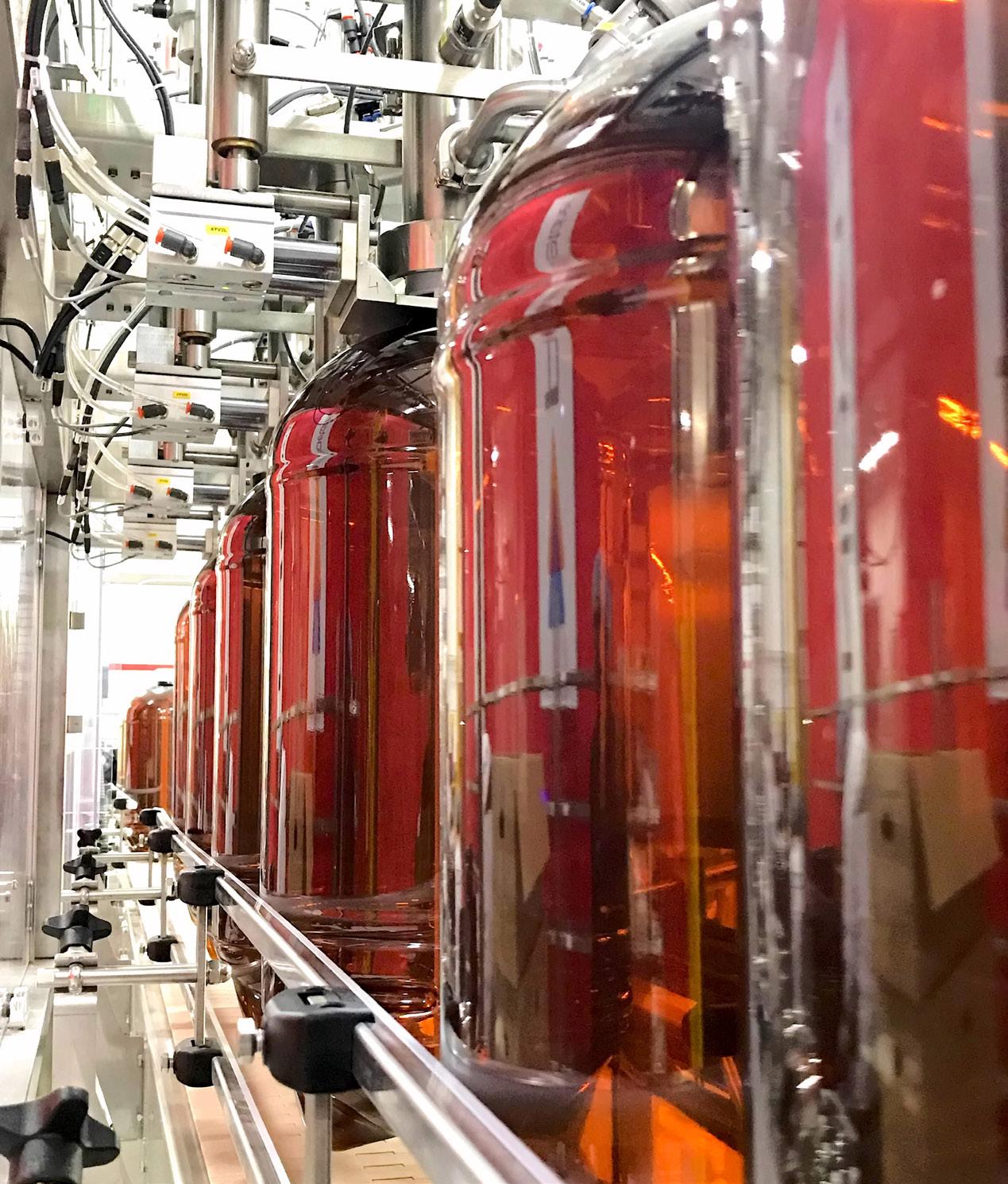






“Our products have broadened packaging choices for businesses and consumers alike. We are passionate about servicing the market and therefore it has been a great honor for us to select our locations in Western Idaho and West Tennessee, which offer quick communication and convenient freight rates, as well as providing jobs to specialists for those localities,” McEwan tells us.
Throughout the various markets that Petainer continues to serve, retail is pivoting towards climatesmart packaging, a form of material that possesses low emissions and is recyclable. This signifies a gargantuan industry shift in gradually moving from glass to PET bottles.

“We have seen an important trend developing where beverage companies have noted the environmental harm associated with heavy glass bottles that are extremely energy intensive to make,” notes McEwan.
“I see the market shifting away from glass towards reusable PET, and I think that is the path forward for our product solutions. I hope that as we move further forward, we will be introducing the reusable range into broader markets,” he expands.
Reusable PET is sustainable, with up to 81 percent less carbon emissions compared to refillable glass over its lifespan. Petainer has invested heavily in its refillable PET solutions and now uses technical expertise built up over two decades to constantly improve the life of its comprehensive reusable
product range.
“Likewise in the large format containers, we have options that reduce emissions. Our one-way kegs have weight benefits versus steel kegs, whilst also reducing logistics headaches for our customers. Our refillable and single-use water cooler bottles are made from PET instead of the industry standard polycarbonate. The key benefits here are that PET Bispehnol A is free and also doesn’t require an energy-intensive annealing (heating) process which is required to strengthen polycarbonate bottles.”
“OUR PRIORITIES ARE TO PRODUCE GREAT PRODUCTS MADE BY COMMITTED EMPLOYEES WITH A HIGH LEVEL OF CUSTOMER SATISFACTION”
– CHRIS MCEWAN, PRESIDENT, PETAINER
Petainer is a business that thinks of its customers and suppliers as partners.
“The best projects that we work on are those that involve a high degree of collaboration from third parties –whether suppliers, customers or other stakeholders,” McEwan tells us.
It is often in these discussions, where problems are shared, that new projects come about with the ability to truly create a win-win scenario for all parties involved.
“We are unlike most PET packaging companies as our supply base is more diverse due to the specialist nature of some parts of our product range,” he continues.

As such, Petainer has set up a Product Development, Commercial and Supply Chain team that works
collaboratively with third parties to achieve some of the ambitious goals that the company sets itself.
One key challenge that many businesses are facing today is meeting carbon reduction and sustainability targets. Making these goals credible and achievable calls for effective cooperation throughout the supply chain.
“We work with suppliers to ensure we are using the best materials to manufacture with, and so that our teams can offer cutting-edge solutions in the market,” McEwan adds.

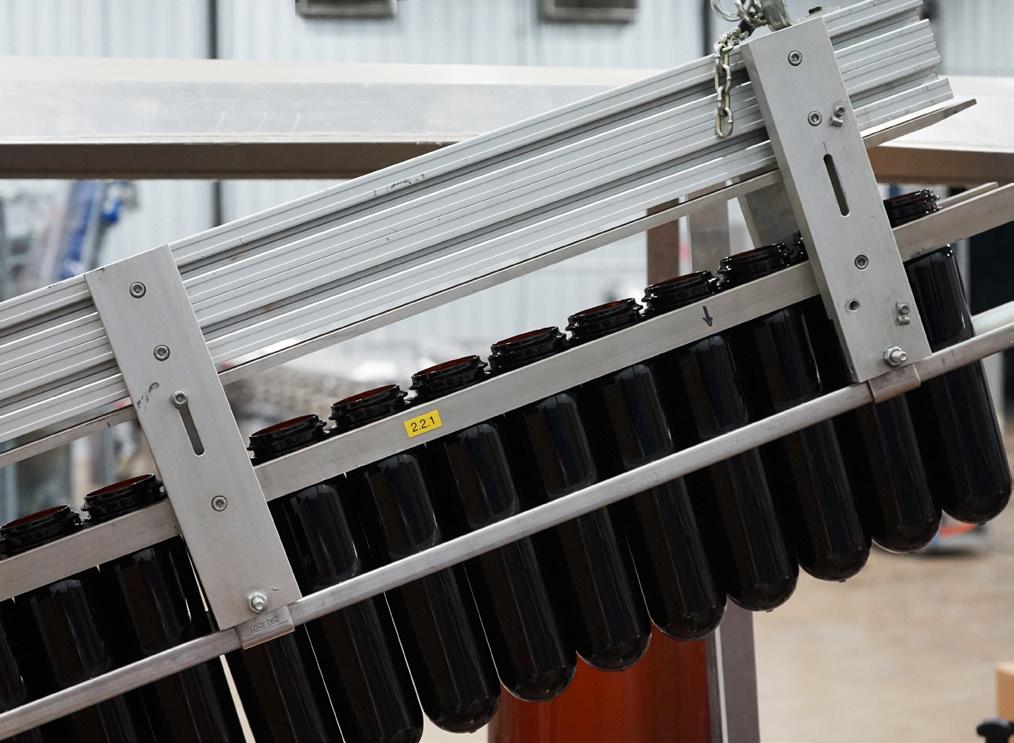
Similarly, Petainer remains committed to complete transparency in its manufacturing to allow customers and end-use consumers to make the most sustainable choices possible.
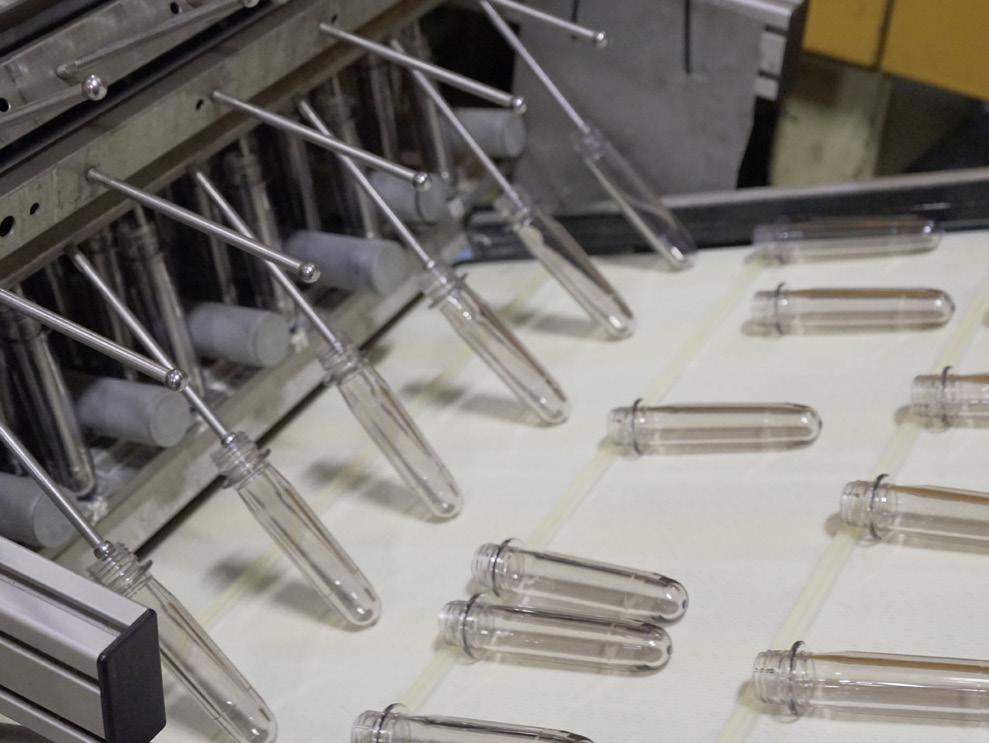

McEwan is excited for the next
chapter in the story of the company, as it continues to develop and evolve.
“As always with Petainer, there is a lot going on right now, including some exciting expansion plans and revolutionary product extensions. Our priorities are to produce great products made by committed employees with a high level of customer satisfaction – and if we do that then the financial performance of the business will naturally look after itself.”


Aerospace is booming right now, and the work is truly back!”
The enthusiastic opening words of Ron Felix, CEO and President of Moeller Aerospace (Moeller), perfectly reflect both the optimistic outlook of the aerospace manufacturing landscape across the US at present, and the flourishing fortunes of the company itself.
“The aerospace industry is currently witnessing increased pressure in the supply base on performance. Meanwhile, a change in business dynamics is upon us, starting with general inflation, availability of experienced labor, and the need for

precise cash management are also making this period of time a little different,” he introduces.
With the changing dynamics cited above, Felix believes that Moeller must constantly ensure that it invests in the correct projects and initiatives for its factories and people. The company’s number one priority is identifying and managing growth with the right initiatives and investments securing its future and continuing to support its many loyal customers.
Moeller, like many other similar players in the aerospace manufacturing industry, must now attempt to navigate a notably different environment to the unlimited growth that many businesses experienced from 2013 through to 2019. That growth, followed by a significant reduction of demand during the COVID-19 pandemic changed the business profile and left lingering impacts, both positive and negative, on the company as it prepares for the rebound this decade.

“We want to position ourselves to remain highly competitive and
financially viable while remaining aware of everything that is going on geopolitically and socially to make sure we’re not overcompensating for either a severe downturn or an aggressive upturn,” he sets out.
Further hurdles that Moeller is currently contending with include the reduction of an experienced and available labor pool in the wake of the COVID-19 pandemic, the task of attracting the younger generation into aerospace, whether skilled trades or engineering talent, and the overall lack of experience in the industry. This is now starting to become more prominent as a key limiter of growth attainability. “So many “like” businesses have shed large percentages of their staff in recent years, and we are all scrambling to entice a smaller labor pool which is compounding the challenge, especially as the economic model of employee retention changes to appease this new generation of workers.”
Despite this, Moeller remains laserfocused on executing an unrivaled
Moeller’s elite Quality Management System is dedicated to meeting its customers’ expectations through procedural compliance, continuous improvement, and effective problem solving. The company prides itself on its metrology expertise and continuously strives to improve measurement resolution with multiple inspection methodologies, including:
• CMM inspection
• Profiling systems
• Laser measurements
• Surface finish analyzers
• Visual inspection
• Manual inspection
Moeller remains incredibly dedicated to reducing process variation through continued investment in Statistical Process Control systems that provide effective methods of reacting quickly to process deviations, while improving visibility into the health of its manufacturing processes.
level of service. It knows all too well, service is the key discriminator of a product component business.
Established in 1949, Moeller now draws upon numerous years of experience as a full-service turbine engine component supplier, from raw material procurement to finished part assembly and delivery.
During this time, the company has evolved gracefully into an industry leader in complex precision components for aerospace and industrial markets, displaying expertise in milling, turning, conventional grinding, creep-feed grinding, electrical discharge machining (EDM), and super abrasive machining technologies.

“To this day we specialize in turbine airfoils and complex components including blades, vanes, nozzles, flow path parts,

seals, dampers, mounts, and locking parts,” details Felix.
Since 2010, the company has impressively expanded five times, adding 188,000 square feet of new manufacturing space to support the growing aerospace industry.
Marking a crucial time for the company, in 2016, Moeller was purchased by AE Industrial Partners, a private equity firm specializing across a vast array of industries including
spans a multitude of commercial, military, space, and industrial energy applications. As a result, Moeller’s machining solutions are now sourced by every major original equipment manufacturer (OEM) on over 70 engine programs.

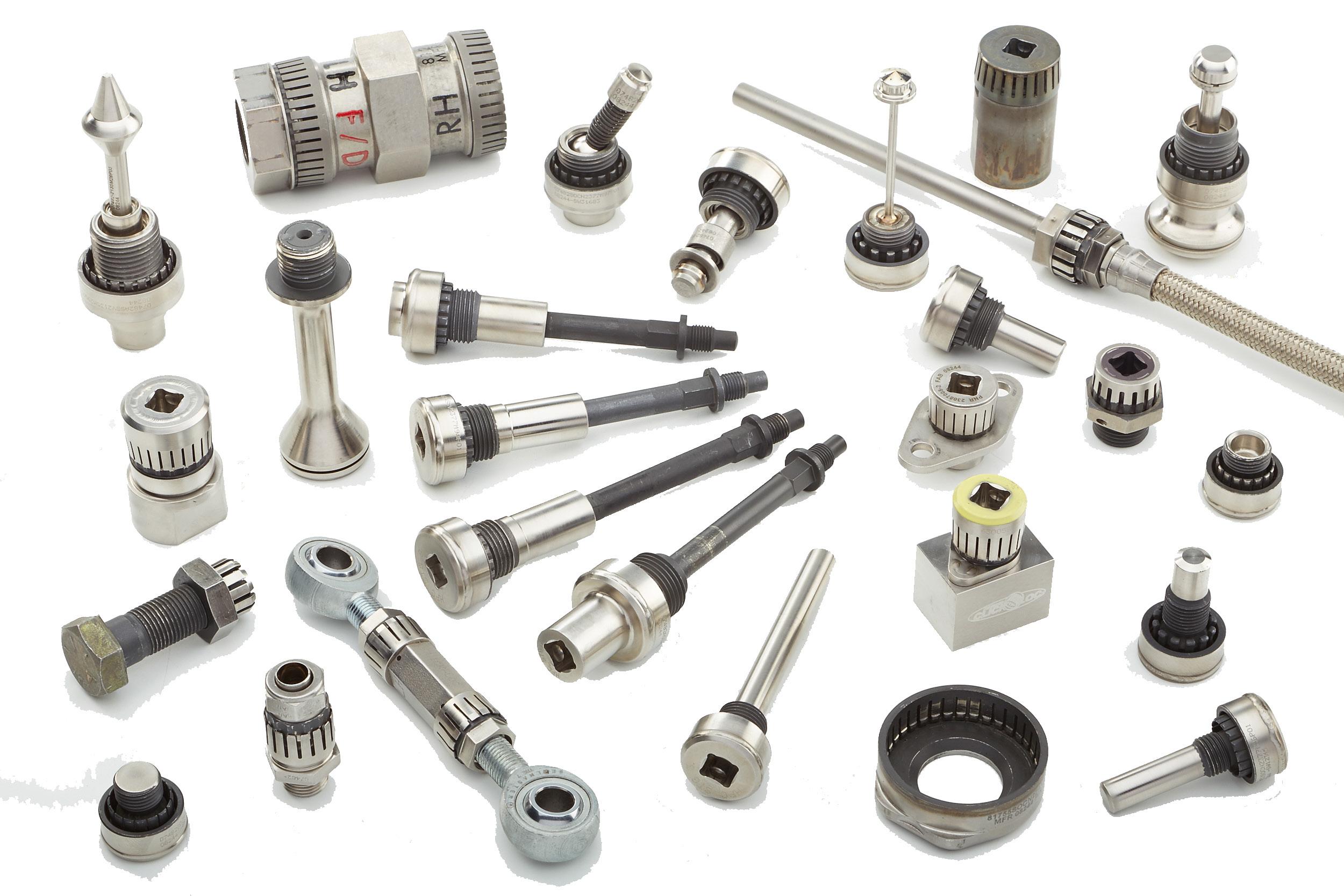
“We provide thousands of parts to our customers on a weekly basis and each part is manufactured to their precise technical specifications,” he affirms.

“AEROSPACE IS BOOMING RIGHT NOW, AND WORK IS WELL AND TRULY BACK”
– RON FELIX, PRESIDENT AND CEO, MOELLER AEROSPACE
of valued partnerships, Moeller has consistently raised the bar of turbine engine excellence by advancing its array of processes to meet new technical challenges, while always maintaining a competitive edge on quality, delivery and cost.
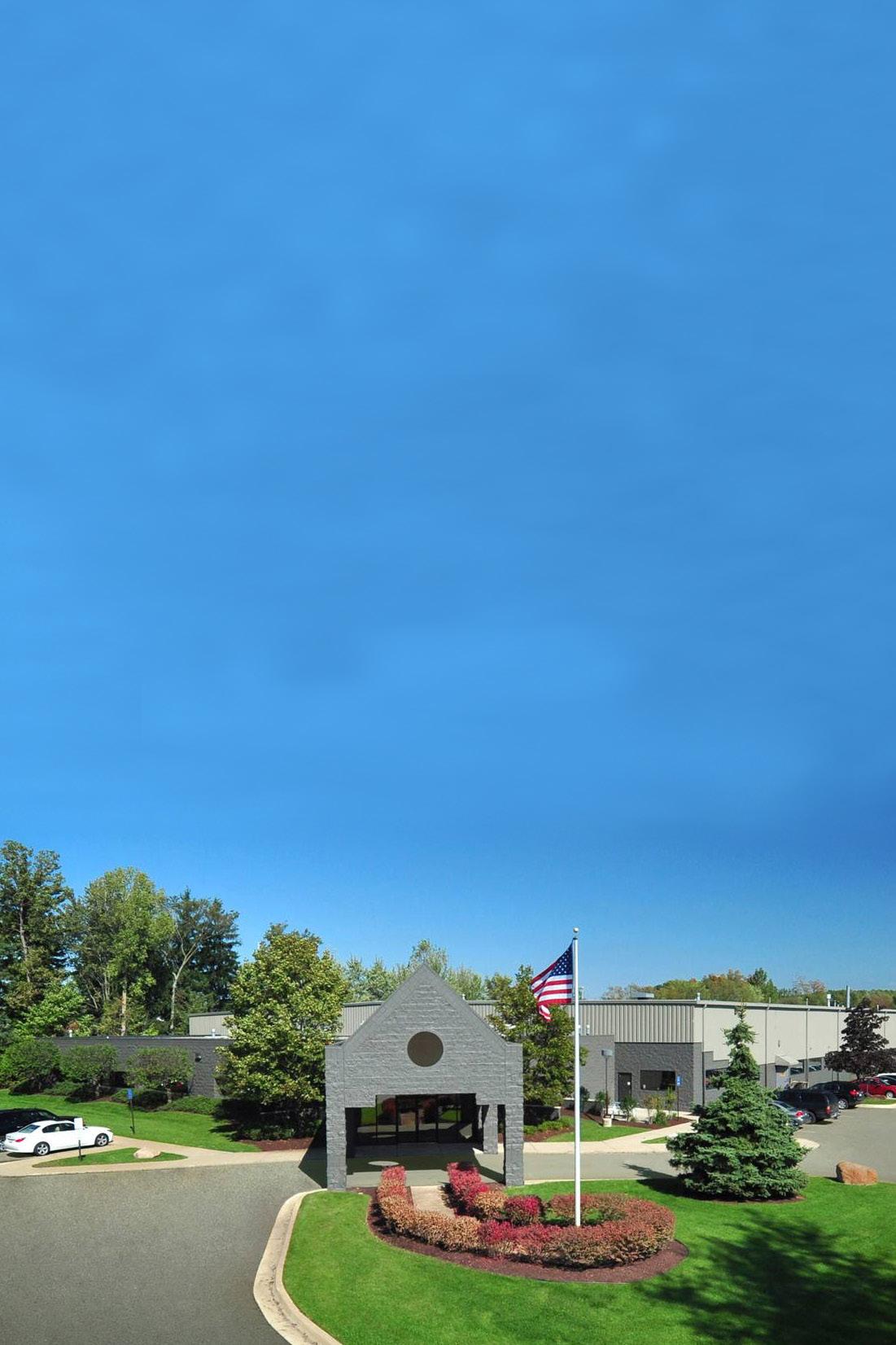
A true trailblazer in aerospace manufacturing, Moeller’s generationdefining technology, Click-Loc®, was invented in 1992 as an industry solution for lock wire and safety wire replacement.
“Click-Loc® is a custom-designed and patented self-locking technology that represents the next level of worldclass self-locking solutions, adding quality, reliability, and maintainability to any product while simultaneously driving down life cycle costs. Furthermore, its reusability surpasses hundreds of reuse cycles with no appreciable wear,” expands Felix.
The technology’s 100 percent positive-locking mechanism resists loosening due to stress, vibration, extreme thermal cycling, and other
environmental conditions and is a revolutionary alternative to lock wire, safety wire, tab washers, cotter pins, deformed threads, locking elements, and thread locking compounds. In this way, Click-Loc® has proven to be so reliable that it is now specified for flight safety-critical applications. This impressive technology has grown to become somewhat of a signature product for the company, demonstrating Moeller’s ongoing hunger for innovation and technological transformation. Offering virtually unlimited possibilities, Click-Loc® self-locking technology can also be applied to
aerospace, automotive, marine, locomotive, petroleum, and numerous other industries that rely on mechanical, electrical, hydraulic, or fluid system applications.
Whether the application is new or retrofit, Click-Loc® engineers will customize the perfect self-locking solution, encapsulating Moeller’s attention to providing its clients with the ideal product, tailored precisely to their individual specifications.
Moeller boasts a comprehensive portfolio of success stories across the aerospace landscape, with two of its
“WE WANT TO POSITION OURSELVES TO REMAIN HIGHLY COMPETITIVE AND FINANCIALLY VIABLE, WHILST BEING AWARE OF EVERYTHING THAT IS GOING ON GEOPOLITICALLY AND SOCIALLY”
– RON FELIX, PRESIDENT AND CEO, MOELLER AEROSPACE
most notable achievements coming in the form of its aforementioned Click-Loc® technology, which has proven to be an incredibly valuable addition to the F-16 and F-22 fighter aircrafts.
In 1992, the F-16 was experiencing a problem with fuel leakage on the main fuel manifold, creating the severe potential of onboard fires, and therefore rendering the aircraft dangerous to operate. These issues were attributed to a faulty lock wire, and so Moeller presented a new design of secondary fastener security as a lock wire replacement solution.
After extensive reviews of test data, the U.S. Air Force (USAF) selected Moeller’s design, which also required a policy modification for visual verification. Moeller’s Click-Loc® fluid fitting design was retrofitted onto the entire fleet of engines and has been proudly used ever since.
“We’ve had a great amount of success working in partnership with the military on projects like this, and we’re also starting to make inroads into being a standard supplier for space propulsion,” Felix adds.
In 2012, the USAF contracted Moeller for the design of a similar fluid
fitting for the F110-129/132 engine which the company continues to produce today with zero reported failures to date.
Similarly, in 1994, Lockheed Martin required a turnbuckle designed to operate to extremely tight tolerances to open and close the F-22 refueling door.
Upon contacting Moeller for a solution, the thread on the rod end of the turnbuckle had to be very fine to accomplish the tight tolerance that is nearly impossible to achieve.
Solving this, Moeller devised a strategy of using two different thread sizes whose only difference was the tight tolerance, which allowed the turnbuckle to be adjustable to the requirement.
The Click-Loc® self-locking turnbuckle design was implemented throughout the entire F-22 fleet, yet again perfectly indicating Moeller’s supreme design dexterity and showcasing its innovative array of manufacturing solutions.
The invaluable service provision that Moeller offers for the aerospace industry looks set to continue soaring sky-high, as the company accelerates exponentially from strength to strength.
• LEADERSHIP
Moeller’s leadership values are demonstrated through its history of investing in people, products, and technology while servicing its customers with honesty and integrity. The company remains committed to fostering these same values throughout the entire organization.
• ENVIRONMENTAL
Moeller is actively incorporating environmental management processes and procedures into its manufacturing operations to minimize waste streams and drive energy efficiency. The company remains committed to reducing its carbon footprint by monitoring objectives and targets for continually improving methods of preventing pollution.
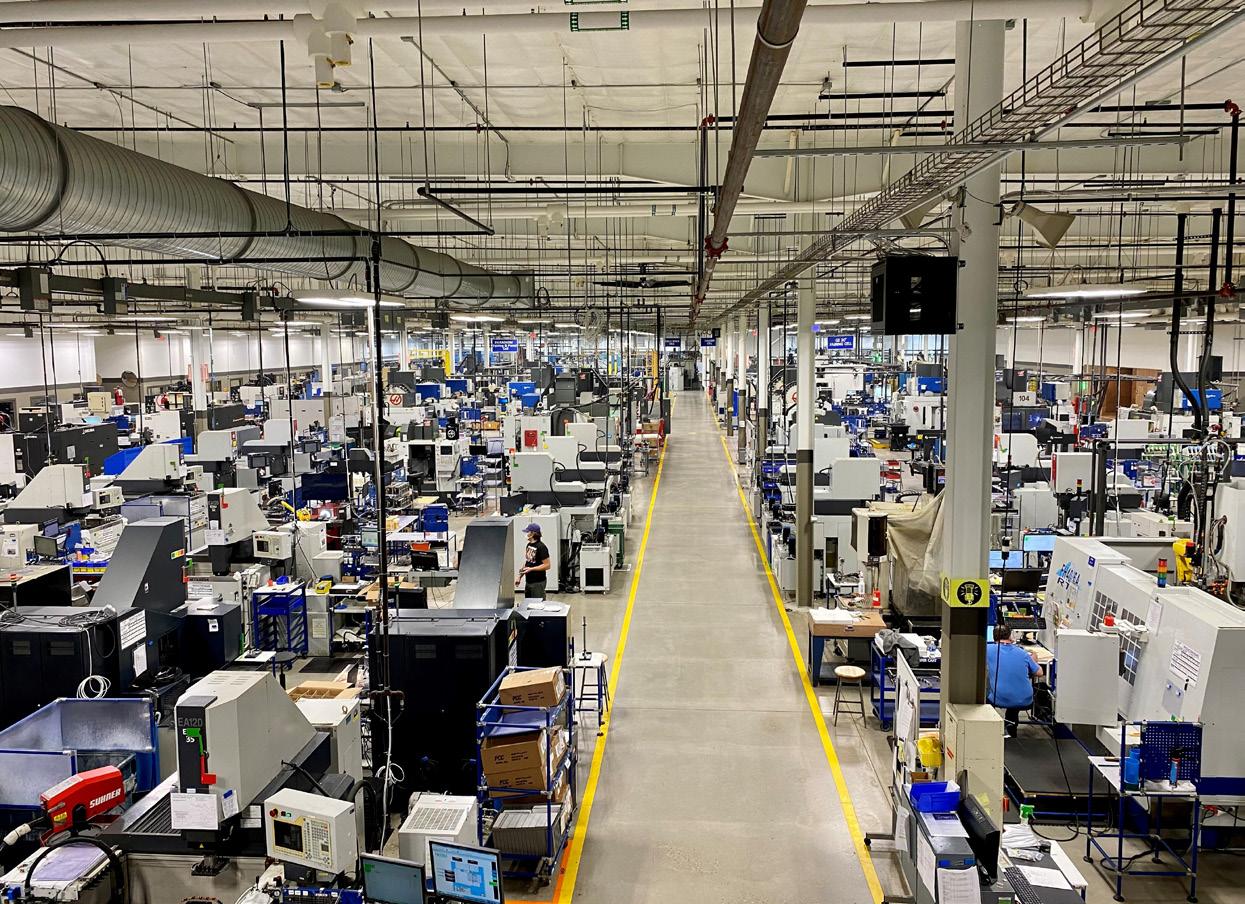

• QUALITY
Additionally, Moeller is certified to ISO 14001:2015, and operates in compliance with all federal, state, and local environmental legislation.
MOELLER AEROSPACE
moeller-aerospace.com click-loc.com


We take a deep dive into the deep foundation specialists, Morris-Shea, and discover the company’s involvement in critical infrastructure projects with Vice President, Richard Shea

Deep foundations are essential for safety and maintaining the integrity of a building.
There are various reasons why a deep foundation is desirable for structural stability, including weak, compressible or undocumented soils, as well as soil liquefaction.
Throughout the US, Caribbean, and South America, deep foundation systems are installed by MorrisShea for many of the world’s largest energy, manufacturing, and industrial projects.

“We now work across the entire
continental US and Hawaii, as well as numerous island countries in the Caribbean, and have even performed work in Suriname and Mexico,” opens Vice President, Richard Shea.
The company was founded in 1969 as a heavy civil contractor by Shea’s father, Dick, who at 81 years old remains very active in the business along with two of his other sons, Bill and Steve.
“I tend to take on the energy, oil and gas projects that are usually located west of Alabama, Bill handles everything up the east coast, and
we split the jobs that are nearby. Our younger brother, Steve, runs our equipment and trucking,” Shea tells us.
Morris-Shea began by primarily focusing on bridge construction for the new interstates and highways in the southeast of the US.
However, by the time these interstates and highways had been completed in the mid-1980s, and bridge construction became less abundant and profitable as a result, the company shifted to the deep foundation work it is known for today.
“There were a lot of new pulp



and paper mills being built in the southeast. Our clients were typically large engineering, procurement and construction (EPC) contractors such as Fluor, Brown & Root, BE&K and J.A. Jones,” Shea details.
In 1992, following a trip to Germany for bauma, the world’s largest construction trade fair, Morris-Shea negotiated a licensing agreement with DeWaal for its new drill displacement pile system, covering the entire western hemisphere.
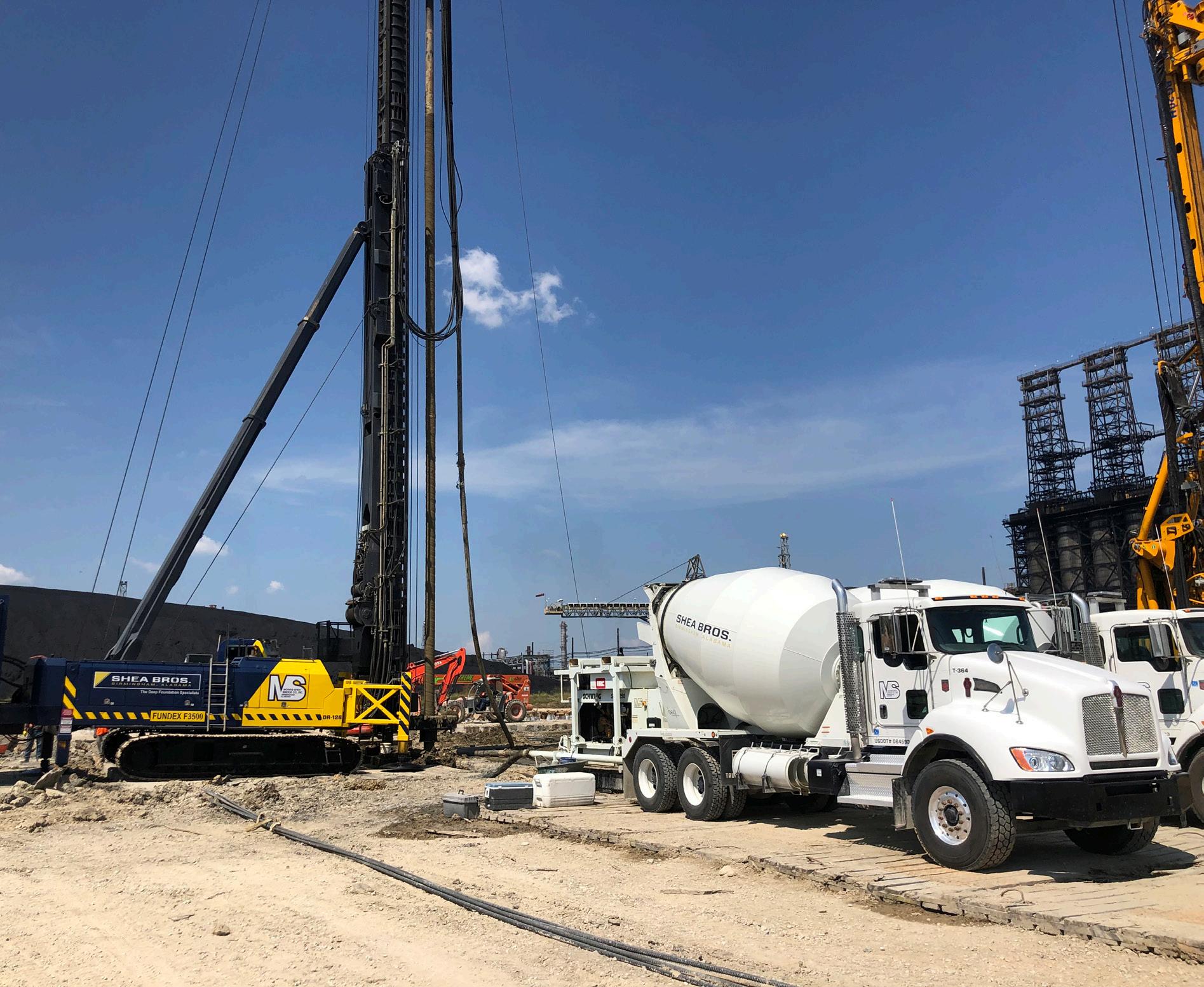
The DeWaal pile system provides foundation support for all types

“WE NOW WORK ACROSS THE ENTIRE CONTINENTAL US AND HAWAII, AS WELL AS NUMEROUS ISLAND COUNTRIES IN THE CARIBBEAN, AND HAVE EVEN PERFORMED WORK IN SURINAME AND MEXICO”
– RICHARD SHEA, VICE PRESIDENT, MORRIS-SHEA
GEOTECHNICAL ENGINEERING / FOUNDATION STRUCTURES / WATERFRONT STRUCTURES
WWW.MRCE.COM

SUBSURFACE INVESTIGATIONS AND DESIGN PARAMETER SELECTION
GEOTECHNICAL PROBLEM DEFINITION / SOLUTIONS / DESIGN / CONTRACT DRAWINGS
STRUCTURAL DESIGN / EXCAVATION SUPPORT / FOUNDATIONS
NUMERICAL MODELING / SOIL STRUCTURE INTERACTION
INSTRUMENTATION & MONITORING / AUTOMATED SYSTEMS / 24/7 WEBSITE REPORTING
SOIL MECHANICS AND ROCK MECHANICS LABORATORY (MRCE PROJECTS ONLY)
SPECIAL INSPECTIONS / CONSTRUCTION SERVICES
EMERGENCY RESPONSE / PEER REVIEW / LITIGATION SUPPORT
MRCE designed an earth fill cofferdam with deep cutoff to provide a stable watertight excavation for construction of a new hydroelectric plant on the Ohio River. MRCE designed the emergency spillway, cofferdam slopes, rock excavation for plant foundation, channel cut, and cofferdam breach process.


MRCE designed excavation support for the Norfolk approach of VDOT’s new immersed tube Midtown Tunnel in a deep soft clay soil profile. The Norfolk approach protected the existing Midtown Tunnel (left side of photo) and adjacent structures.
MRCE HAS PROVIDED SPECIALTY GEOTECHNICAL AND STRUCTURAL DESIGN SERVICES FOR CHALLENGING MORRIS-SHEA PROJECTS ACROSS THE US.
LET OUR EXPERIENCED ENGINEERS ADD VALUE TO YOUR NEXT DESIGN.
MRCE provided geotechnical, structural design, and instrumentation for the cut and cover tunnel Design-Build team upgrading the CSX Virginia Avenue Tunnel in Washington DC.

LICENSED TO PRACTICE IN 27 STATES AND WASHINGTON DC

REACH US AT: WWW.MRCE.COM/HELP
Cannelton Cofferdam Norfolk Approach – New Midtown Tunnel Virginia Avenue TunnelSafety is firmly embedded in Morris-Shea’s corporate culture and deep foundation construction methodology.
The company’s environmental, health and safety (EHS) program operates in full compliance with all health and safety regulations established by federal, state and local governments.
The program includes site-specific planning, accountability, attitude and ongoing training initiatives. Each project is closely analyzed to identify and mitigate risks to the health and well-being of its workers and the public.
Every team member has the shared responsibility to maintain a safe working environment at Morris-Shea, whose ultimate goal is to have zero harmful incidents through the effective management of safety in all its operations. The company’s Experience Modifier Rate (EMR) is currently 0.7, which is one of the lowest in the industry.
of structures, including high-rise buildings, hospitals, water treatment, manufacturing, industrial and petrochemical facilities.
“Shortly thereafter, we started purchasing machines from Europe that were specially built to install the DeWaal pile system,” says Shea, who has worked for the company since 1992 after graduating from college.
“We have grown from one drill rig to nearly 30 since I began working for Morris-Shea.”
Today, it is one of the largest foundation contractors in the US, based in Harpersville, Alabama (AL) and complemented by Shea Brothers Engineering LLC, an engineering company that works solely for Morris-Shea.
Additional yards and fabrication shops are maintained by Morris-Shea in Lake Charles, Louisiana (LA) and Angleton, Texas (TX), each of which is equipped with three robotic cage making machines along with a further two in Harvey, LA.
Reinforcing steel cages are
manufactured by Morris-Shea for installation in most deep foundation applications. Construction of each pile is completed when drill tenders outfit a prefabricated steel cage with alignment spacers and place it into the concrete in the drilled hole.
“We perform our own reinforcing cage fabrication for jobs. Cages are tack welded at every intersection rather than being hand tied on projects,” Shea explains.
“This creates a much higher quality cage and saves a lot of laborers having to be on site. We deliver cages to jobs as needed to minimize the required amount of site laydown.”
Morris-Shea’s backlog of projects, perhaps the biggest to date in the company’s history, includes the recent installation of deep foundations at Ford’s expansive new electric vehicle (EV) manufacturing facility near Stanton, Tennessee.
Nearly 10,000 DeWaal piles were drilled in sites throughout the

South Texas Steel Service Company LLC, is a full service reinforced steel fabricator and concrete related product supplier which opened for business in June 2007. Located in a 53,000 square foot facility at 201 E. Crestwood Dr. in Victoria, Texas, South Texas Steel Service Company is dedicated to provide outstanding quality service to general contractors and concrete sub contractors in the South Texas area including Victoria, Corpus Christi, San Antonio, Austin and Houston.
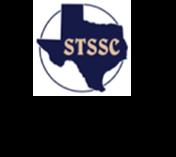

Our primary strength is our people. All of our production and detailing staff have experience in steel fabrication along with enthusiasm for DOING THE JOB RIGHT.

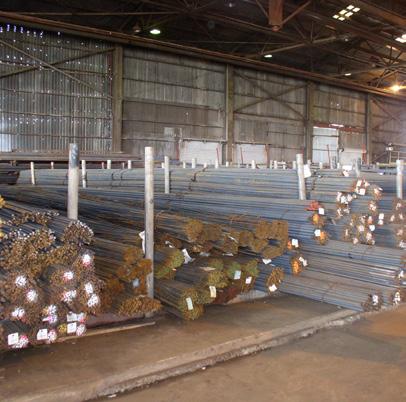
We believe that SAFETY of our employees, customers, visitors, and vendors is our first priority. We also believe that each individual must take charge of their own safety and that no amount of reward is worth any amount of risk to the well-being of our people. Wearededicatedtoservingourcustomer’sneeds,andourgoalis 100percentcustomersatisfaction.Westrivetobringyouthebest inqualityservice.Ifsomethingisn’tright,pleaseletusknow.

complex, ideal for the soil profiles found at the job site, as well as more than 600 rigid inclusions.
Installation of the DeWaal pile system was performed in a single pass process that densified the soil, improved shaft friction, and increased overall pile capacity.

“That project was originally designed on drilled shafts, however, we offered a value engineered alternate to drilled shafts and collaborated with the owner’s engineers to implement the design,” outlines Shea.
Value engineering accounts for around 75 percent of the work carried out by Morris-Shea, whose designbuild services allow the company to provide savings to clients while improving margins.
The DeWaal piles minimized contamination and disposal concerns, eliminated the expenses associated with waste removal in conventional drilled shaft applications, and provided the necessary load strength requirements.
Morris-Shea was able to successfully convert all but one building on-site over to DeWaal piles, which proved to be faster and less expensive than the drilled shaft design.
“We ended up doing around 80 percent of the total foundation work on the Ford project, and we also performed shoring on two portions of the stamping plant,” Shea states.
Elsewhere, in Port Sulphur, LA (30 miles south of New Orleans), the company is actively working on the Plaquemine LNG export terminal, owned by Venture Global.
Morris-Shea is installing a total of 24,000 DeWaal piles in the first phase of the plant, which is being constructed by KZJV, a joint venture between Zachry Group and KBR.

A further 18,000 piles could be installed by Morris-Shea should it be selected for Phase Two, which is yet to be awarded.
“We have 11 rigs on site installing up to 150 piles per day, as well as three concrete plants and 75 trucks dedicated to our operation,” Shea informs us.
“Phase One will be completed in August, and Phase Two could stretch into 2024. We’ve been verbally told that we will be awarded the work, but don’t have the change order yet.”
Another four Morris-Shea rigs are currently working on the installation of 27,000 piles and a large sheet pile supported excavation for the third stage of Cheniere’s Corpus Christi Liquefaction (CCL) facility, which continues to be built by Betchel.
Once construction is complete, it will add approximately 10+ million tons per annum (mtpa) of production capacity to CCL, bringing the facility’s total nominal capacity to more than 25 mtpa.
“This is about an 18-month job for us. There is a lot of site work to perform, so we are unable to use more rigs,” notes Shea.
The company is also working at Novelis’ aluminium recycling and rolling plant in Bay Minette, AL, which is one of the state’s most prominent construction projects supporting the growing demand for aluminium beverage packaging and automotive solutions.
A $70 million job, Morris-Shea offered a value engineered proposal to change the foundation from DeWaal piles with very large pile caps to high capacity, large diameter, continuous flight auger (CFA) piles, which reduced the schedule, required fewer drill rigs and reduced the pile cap concrete by around 20,000 cubic yards (CY).
“We will be using the 24 inch (in) and 36in diameter CFA piles, and will also construct well over 1,000 feet (ft) of shoring walls for support of deep excavations which range from 17 to 40ft deep. Shoring walls will be performed using a 70-ton excavator equipped with a KEMSOLID Sword, which is similar to a trencher.
“Neat cement grout will be pumped down each side of the sword and create a 24in wide, 43ft max depth soil-cement wall in the ground, with wide flange beams placed vertically every four to six feet depending on the retained height.”

“WE ENDED UP DOING AROUND 80 PERCENT OF THE TOTAL FOUNDATION WORK ON THE FORD PROJECT, AND WE ALSO PERFORMED SHORING ON TWO PORTIONS OF THE STAMPING PLANT”


– RICHARD SHEA, VICE PRESIDENT, MORRIS-SHEA
At Tractor & Equipment Company (TEC), we believe in building lasting relationships with our partners. Our longstanding collaboration with Morris-Shea is a testament to the trust and confidence they have placed in our products and services. Together, we have achieved remarkable milestones in the construction industry. We applaud Morris-Shea for all its success and are proud to assist the company as it continues to grow and thrive.
The cornerstone of our partnership lies in the utilization of advanced Komatsu equipment. Known for its unparalleled reliability, cutting-edge technology, and exceptional performance, Komatsu machines have become a key part of Morris-Shea’s projects. These machines enable them to tackle complex challenges with ease, ensuring projects are completed on time and to the highest standards.
TEC takes great pride in our commitment to minimizing downtime and maximizing efficiency. We understand that even the slightest delay can have a significant impact on project timelines and costs. That is why we have implemented robust


measures to keep downtime to a minimum. Our proactive maintenance practices, comprehensive spare parts inventory, and expert technical support are tailored to meet the unique needs of Morris-Shea and to keep their operations running smoothly.
We are grateful for the trust and confidence that Morris-Shea has placed in TEC as its longstanding partner. Our continued collaboration is a testament to our unwavering commitment to its success and to providing industry-leading equipment and service.
If you have any questions or would like to learn more about our partnership with Morris-Shea, or the range of Komatsu equipment we offer, please do not hesitate to reach out to us. Our dedicated team is here to support you and help you achieve your construction goals.


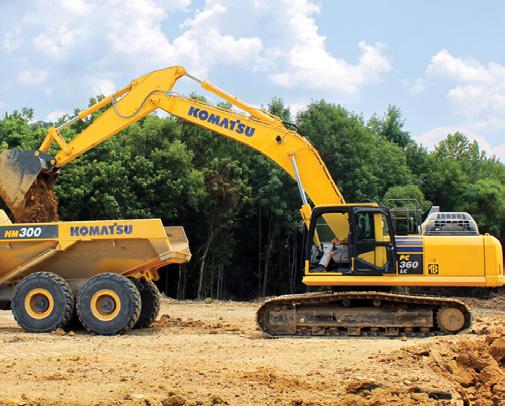

Thank you for your continued support and trust in TEC. We look forward to serving you and exceeding your expectations in the years to come.
Visit us at tec1943.com



As well as working extensively on a number of deep foundation projects, Morris-Shea has invested heavily in machinery and equipment.
Since October 2022, the company has ordered four new Fundex drill rigs (two F3500s, F2800 and F5600), two used Fundex machines (F2200 and F2800), a new Woltman 90DR, and a KLEMM 806 to name a few.

“We have two Bauer BG28s and a Liebherr LRB355 on rental purchase, as well as the KEMSOLID Sword and a big STS grouting plant that is fully automated. We’ve also purchased a couple of lattice boom crawler cranes such as the Kobelco CK1100 and the Link-Belt 218,” Shea adds.
Morris-Shea likewise keeps a large inventory of spare parts in stock at its equipment yard in Harpersville, including engines, hydraulic pumps, winches, cylinders and electrical components, to try and prevent delays amid supply chain issues.

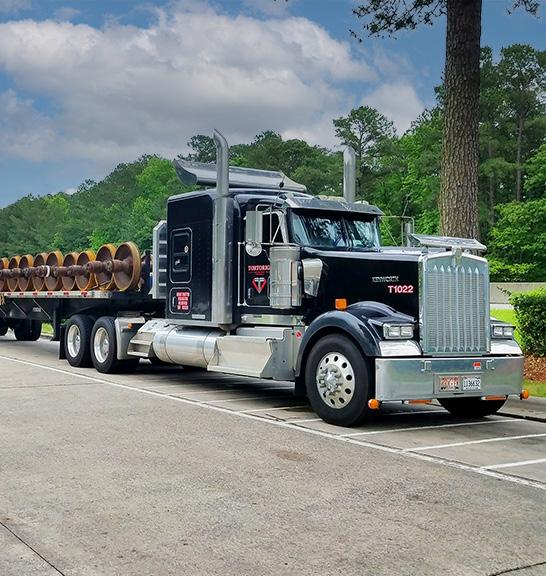
Tortorigi Transport is a full service thirdparty logistics (3PL) company specializing in affordable, on-time delivery of large, small and over-sized shipments to locations throughout North America and worldwide.

-
-
-
-
Even though machinery and equipment are very expensive, and lead times are longer than normal due to ongoing supply chain shortages, the biggest challenge that faces the construction industry is finding enough qualified workers, according to Shea.

“Labor is the most difficult challenge that we face daily. Our crews all travel full time, so it’s even harder for us to locate and retail labor than most construction firms that do not travel outside of their home area,” he acknowledges.
Morris-Shea therefore offers competitive wages and great benefits to its employees, and equally provides value to clients and project owners with competitive prices, schedules, and an excellent safety record in order to keep its pipeline of work full.

“We are swamped right now, but our jobs are much shorter in duration than those of our clients or typical general contractors, so we have to be
tortorigitransport.com
on the hunt for new work all the time,” emphasizes Shea.
Having lost out on a significant body of work during the COVID-19 pandemic, the biggest risk for MorrisShea would be for any more projects to be cancelled in the event of a recession.
For this reason, the company now maintains separate project pipelines for commercial and oil and gas projects, the latter of which is more susceptible to cancellations or delays due to the current price of oil, to be more resilient in the future.
MORRIS-SHEA
Tel: +1-205-956-9518
info@morrisshea.com
www.morrisshea.com
Freight Forwarding: - Specialized Hauling Over Dimensional Shipments OS/OW) Truckload Freight (Full/LTL) International Shipments Just-in-Time Fulfillment
R.S. Andrews was founded in 1968. We’ve been delivering smiles every day since.”
For Dari Payrow, President of R.S. Andrews and orator of the opening statement, it is the customer’s journey and experience that lies at the fore of the company’s operation.
Based in the US and headquartered in Atlanta, Georgia, R.S. Andrews is a family-run service provider offering heating, ventilation, and air conditioning (HVAC), electrical, plumbing, duct cleaning, and insulation services for businesses or Atlanta-area homes, carrying a reputation backed by industry excellence.

R.S. Andrews employs over 200 people, with a secondary location in
Bluffton, South Carolina. Combined, the company’s team of honest, hardworking employees ensure that R.S. Andrews ranks among the best in the business from both a capability and professional standpoint. Part of this professionalism materializes in the way that the company values its clients.
“In the field, we arrive when promised, get right to work, and we’re not finished until the client is delighted,” Payrow tells us.
“While doing so, we treat our customers with the care which we’d expect of our own family. Integrity is not a commodity or a word we take lightly. That’s why we provide up-front, no-surprise pricing before any work begins, so the client is in control every step of the way.”
Evidently, R.S. Andrews has operated in such a way since its establishment 55 years ago. To this day, the company remains proud of the decades of expert and dependable home comfort services it has provided to countless homeowners throughout the Greater Atlanta area, Savannah, and the Hilton Head area of South Carolina.
R.S. Andrews’ customer-first philosophy and unmatched knowledge of heating, air conditioning, electrical, and plumbing systems certainly places it at the head of the industry as the right choice for all HVAC service needs. But according to Payrow, nothing embodies the team’s culture, pride, and dedication
more than “Smiley,” the familiar mascot who appears at local events and gatherings.
“Our motto, “Story After Story, We Deliver Smiles,” is the principle we live and work by,” he says. “Our team is known for brightening our customer’s days, and we often say that many of them have a smile bigger than Smiley’s! Leaving a smile on a customer’s face at the end of a job will always be our greatest accomplishment.
“All fun aside, we’re grateful for the opportunities our customers have given us to be of service to the community. We love being their air conditioning, heating, plumbing, and electrical contractor of choice!”
Dari Payrow, President: “R.S. Andrews is a family business. My wife’s Dad, Jack Dowling, owned the company. When I was presented with an opportunity to purchase the business, we knew the family component mattered more than ever in this age of corporatization of local companies.

“I believe it matters to customers knowing the decision-making owner is in the building and available. It matters to our team, too. It shows how this family takes care of Atlanta families.”
R.S. Andrews holds the belief that strong relationships are the foundation of business success. Moreover, client testimonials attest to the company’s dedication in providing the absolute best service to all its customers.
According to Payrow, one of the largest issues the US faces is a shortage of skilled tradesmen, coupled with surging home prices. Despite this, Atlanta’s job market remains robust and the region’s cost of living is less than in other cities its size, making Atlanta an attractive location to buy into.
“I believe it’s our duty to create opportunities for those who are willing to do the work to access the opportunities this industry presents. That’s why we make training and growing our people a core value at R. S. Andrews,” he elaborates. “While other cities are losing population, Atlanta is gaining new families every day.”
“WE ARRIVE WHEN PROMISED, GET RIGHT TO WORK, AND WE’RE NOT FINISHED UNTIL THE CLIENT IS DELIGHTED”
– DARI PAYROW, PRESIDENT, R.S. ANDREWS
It’s more than a collection of vehicles, it’s a message to your customers, your community and a promise to your employees.
See how far an exceptional fleet program can take your organization. We’ll save you thousands with local, hands-on management, award-winning technology and the infrastructure and expertise of Enterprise.

• Access to all major manufacturers
• Financing available directly through Enterprise
• Flexible options that consider vehicle use and resale market
• Factory order for the lowest possible cost
• Expertise to identify vehicles with the lowest cent per mile expense



• ASE certified technicians
• Negotiated rates and pricing for parts and labor
• Flexibility to use your facilities
• Network of 65,000+ providers
• Accepted at over 90% of US retail fuel locations
• Helps you track and enforce your policies
• More than 700 dedicated remarketing professionals
• Our team manages the entire process to get the best resale price.
• Alerts for regular maintenance
• Improved efficiency, that can help reduce overtime
• Helps ensure driver safety
• 24/7 accident roadside assistance
• Insurance claims handling
• Arbitration management
• Vehicle replacement
The city is a strategic hub for business in the Southeast and across the country. It boasts great economic opportunities as well as the combination of Hartsfield International Airport and the Savannah Port, making reasoning behind Atlanta’s expected growth easy to see.
This growth then leads directly to opportunities for companies in a multitude of sectors, including home services. For R.S. Andrews, this goes hand-in-hand with a present and foreseeable demand for HVAC, electrical, and plumbing services in the industry.
When it comes to the latter, R.S. Andrews’ licensed plumbers deliver smiles to customers with excellent service, upfront pricing, and a 100 percent satisfaction guarantee. Additionally, R.S. Andrews is committed to providing quality 24-hour emergency plumbing services in case customers experience a plumbing issue outside of standard business hours. Available around

the clock, R.S. Andrews’ plumbing specialists are able to respond to emergency calls from homeowners near Savannah, Roswell, Decatur, and Marietta, to solve a range of issues spanning burst pipes, water heater leaks, and much more.
Then there is Atlanta’s climate and the demands that follow. Atlanta is no stranger to a slew of weather throughout the year. Because of this, it’s crucial that homeowners have a reliable HVAC system ready to kick in to meet whatever their needs may be, from heating in the winter to air conditioning in the hot summer months. For a whole range of services, R.S. Andrews’ team of professionals can provide top-notch services such as installations and repairs.
Due to the necessity of HVAC systems in the region, R.S. Andrews also provides 24-hour emergency HVAC services in the area, responding to related issues professionally, on-demand, and with the customer in mind, always.
“Yet what’s seldom spoken of is
10 REASONS TO CHOOSE R.S. ANDREWS
• Professional team
• Customer testimonials
• Current special services
• 100 percent satisfaction guarantee
• Up-front pricing
• Infrared camera inspections
• The smiley advantage plan
• Money-saving tips
• Service area
• Industry membership, accolades, and licenses
what that opportunity demands,” Payrow continues. “This is not a nineto-five business. It’s not work that can get phoned in, either. Success in trades such as ours requires an
Lennox is more than HVAC. It’s a promise.




We believe that the key to a healthy, comfortable home starts with the air with which we live and breathe. Our dedication to the pursuit of perfect air has been a driving force behind each and every innovation since 1895. We make the air cooler, warmer, dryer, cleaner and better with premium, award-winning systems that are exceptionally quiet and energy efficient. All brought to you by Dealers armed with the expertise and resources to deliver complete home comfort.
www.lennox.com

investment of time, effort, and persistence. Most of all, it demands a servant’s heart. How far you go and how high you reach will be defined by how well you serve your team and your customers. That’s why R.S. Andrews really does aim to deliver smiles on every call, every day.”
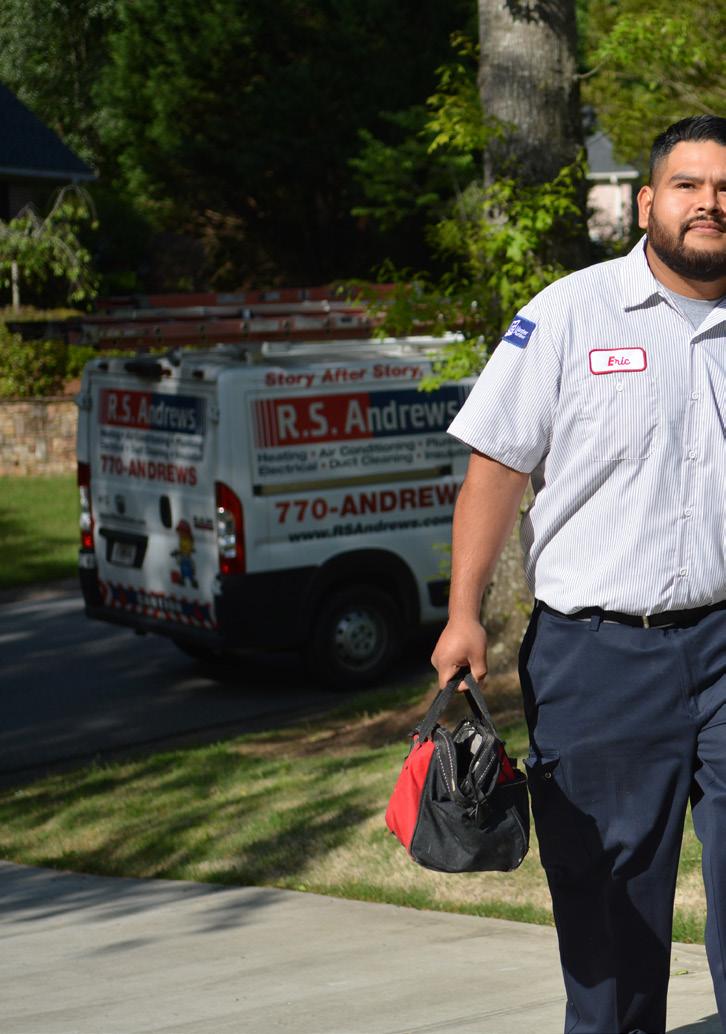
There is an enduring and practical mindset that runs throughout R.S. Andrews - the company is only as good as the team that delivers its promise. It is Payrow’s goal to
create a positive workplace that invites participation, recognizes contributions, and offers advancement to all employees who perform. In light of this, R.S. Andrews regularly recognizes and rewards the service contributions made by its office support, customer service representative (CSR), and dispatch teams with awards relating to service improvement, and achieving goals.
This company-wide recognition of efforts and continued professionalism is matched by the rate of growth the company is experiencing.

“R.S. Andrews continues experiencing double-digit percentage growth organically,” Payrow explains. “While adding acquisitions in both Atlanta and Bluffton, our most important growth investment is in our people. We continue investing internally to support our enhanced skills and capabilities to ensure every R.S. Andrews professional delivers the most advanced solutions possible.”
At the same time, R.S. Andrews also continues watching for the right companies to acquire in the Atlanta and Bluffton markets. The company’s
“LEAVING A SMILE ON A CUSTOMER’S FACE AT THE END OF A JOB WILL ALWAYS BE OUR GREATEST ACCOMPLISHMENT”
– DARI PAYROW, PRESIDENT, R.S. ANDREWS
longer-term plans involve adding elite brands that mesh with its existing family culture under the company’s umbrella through acquisitions and expanding in new markets.
“We believe in the power of synergies,” Payrow says. “That’s why R.S. Andrews actively seeks out partnerships with vendors that can contribute cost-effective solutions to support the growth of our residential and commercial customer base. Another benefit of expanded
partnerships is that we’re able to provide even better work experience for our team.”
With an eye on growth in the year to come, R.S. Andrews is expanding its employee base, planning to establish a new, larger facility, and adding a training center to increase operational professionalism.

“Growth is good for the company, good for our team, and good for the families and businesses we serve. I want to put R.S. Andrews in a primed position for growth in 2024 and beyond,” Payrow adds.
“The ultimate reason R.S. Andrews should always be your first call when you have a heating, air conditioning, electrical, or plumbing problem or question is that we are fully committed to giving you the best service and best customer experience every time you call. So, call R.S. Andrews today and find out what your neighbors already know: Story After Story, We Deliver Smiles!”



R.S.
Tel: 770-525-6384
www.rsandrews.com
By collecting and recycling used cooking oil, Mahoney Environmental is addressing the issue of improper waste disposal. President and CEO, Dave Kimball, highlights this sustainable practice in the foodservice industry
 Writer: Jack Salter | Project Manager: Louis Locke
Writer: Jack Salter | Project Manager: Louis Locke
Cooking oil waste has become a significant environmental issue in recent years, as it can have detrimental effects on the planet such as water and air pollution.
For example, used cooking oil that is poured down the drain can travel through the sewage system and make its way into rivers and oceans, polluting the water supply and causing aquatic life to perish. Equally, when cooking oil waste is sent to landfill, it can release methane, a potent greenhouse gas (GHG) that contributes to climate change.
Failure to recycle used cooking oil can therefore cause significant environmental damage, and the food supply chain would be adversely affected if the sustainability of plant and animal life was impacted.
Fortunately, there is increasing awareness of the environmentally
friendly and sustainable practice of recycling used cooking oil, which can be converted into a renewable fuel source and used in place of fossil fuels, helping to mitigate climate change and reduce GHG emissions.
“The used cooking oil collection and recycling industry is getting more and more competitive,” notes Dave Kimball, President and CEO of Mahoney Environmental (Mahoney).
“Companies are realizing the potential of how used cooking oil can
 Dave Kimball, President and CEO
Dave Kimball, President and CEO
be recycled into beneficial products, so the demand for it is growing.”
Likewise, as world energy sources decline, demand is skyrocketing for renewables such as sustainable aviation fuel and renewable diesel, two of a growing list of useful products derived from used cooking oil.
As the topic of climate change has become an increasingly mainstream issue in the public domain, added importance has been placed on the work that Mahoney does.

“People might not know or see the connection between used cooking oil recycling and the environment, but we’re able to make the environment safer for future generations by turning a waste product into renewable fuels,” states Kimball, whose time at Mahoney has opened his eyes to the incredible things that can be done through sustainable initiatives.
Mahoney is the number one choice
for all cooking oil management needs in the US, with the goal of being the premier back-of-thehouse service provider to a variety of foodservice operators across the country.
“We are a nationwide provider, servicing over 60,000 foodservice operators across the US. Our customers range from wellmanaged independent restaurants to national chains, airports, casinos, and stadiums,” Kimball outlines.
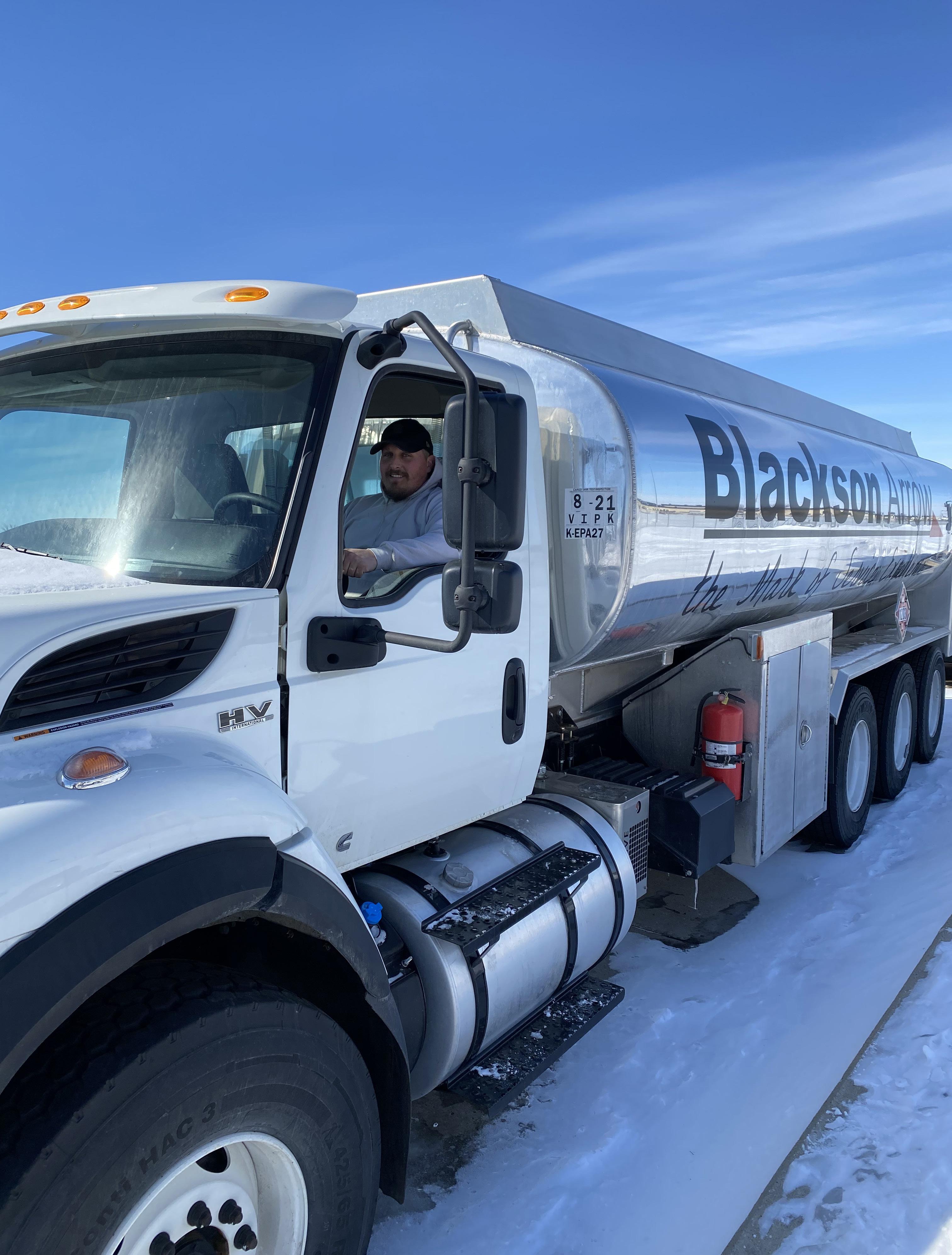

Arrow
Blackson Arrow is a facility management and services company that provides specialized facility operations and maintenance services, as well as aviationrelated services such as airfield management, logistics, and bulk fuels facilities operations to both commercial customers and the U.S. Government. Additionally, since many of our operations are at the intersection of oil and gas, and aviation, Blackson Arrow has become a leading provider of advisory services related to sustainable aviation fuel (SAF) logistics solutions.
Founded by U.S. Air Force veteran, Mike Blackson, we are classified as a disabled veteranowned small business. The firm operates in many locations around the US, such as Littlestown, Pennsylvania; Mountain Home, Idaho; Las Vegas, Nevada; Seymour Johnson Air Force Base, North Carolina; Columbia, South Carolina and Merritt Island, Florida. The company currently has just over 100 employees.
Blackson Arrow is committed to friendly, capable, and competent service to their clients. We continuously strive to improve our processes and operations to meet the challenges of the ever-changing marketplace.
Blackson Arrow recently partnered with Mahoney Environmental Solutions (Mahoney) to provide maintenance and repair on over 20,000 of Mahoney’s used cooking oil (UCO) storage tanks installed in restaurants across the US. In addition, we also coordinate the installation of new USO storage tanks in restaurants that do not yet have Mahoney’s system installed. Our extensive facilities management expertise and network of providers across the country enable us to provide these services in a manner tailored to Mahoney’s specific needs. This project also ties in nicely with our experience with sustainable aviation fuels and their component systems across the entire SAF ecosystem. From the smallest system in a single restaurant to a large bulk fuel storage facility holding millions of barrels, we are able to provide installation, operations, and maintenance services to the entire portfolio of equipment. These systems collect millions of gallons of used cooking oil each day that is collected by Mahoney, filtered and refined as a feedstock additive to produce SAF.
For several commercial consortiums that own large bulk fuel storage facilities on or near

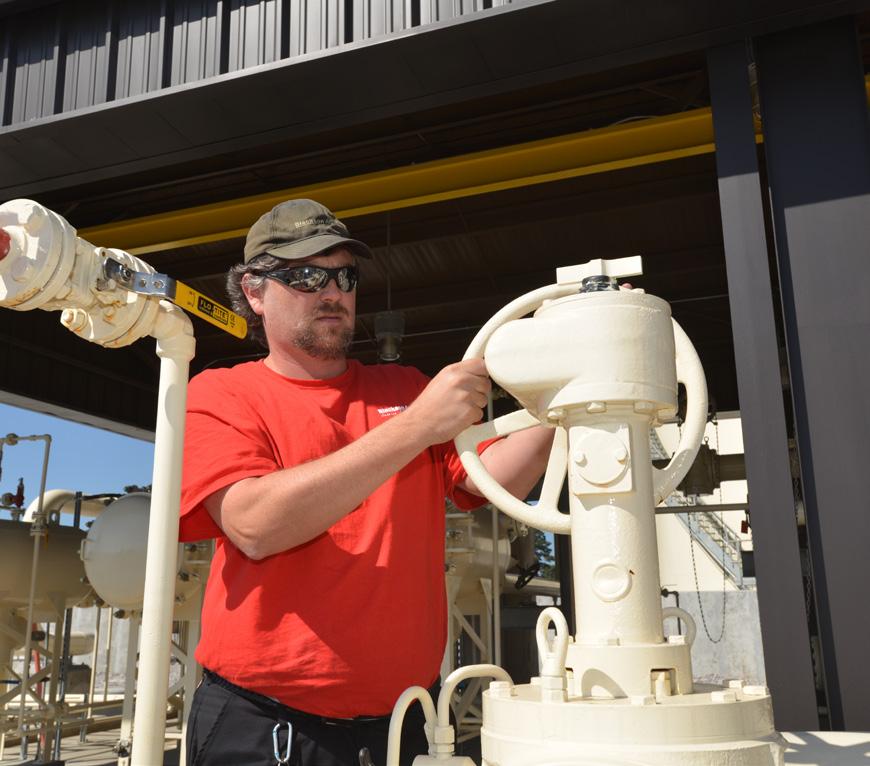
airports, we provide our integrated facilities management approach to these facilities that is unique from the other refuelling companies typically hired to provide bulk storage management. Coming from what the U.S. Government calls base operations services, we are able to manage the entire suite of facilities-related services, from providing reliability engineering and preventive maintenance on these complex systems to mowing the grass and even cleaning the facilities under a single contract umbrella structure.
What, for you, differentiates your business from the competition?
Blackson Arrow differentiates itself from the competition in that we are a facilities management company that also provides a variety of support services to our clients in a number of ways. For example, we have over 20 years of experience in airfield management, into-plane fueling, logistics, and bulk fuels operations and storage. This operational knowledge gives us a deep understanding of the challenges faced by clients and allows them to provide customized solutions that meet their specific needs detailed to both their infrastructure portfolio and the value chain served by that portfolio. On the facilities side, we have a team of professionals highly experienced and qualified in
maintenance engineering, reliability, and management of third-party vendors.
Could you tell us about some of the major challenges faced within the industry and then detail how these have been overcome?
Blackson Arrow has faced a number of challenges in the past, including:
• Competition: Facilities management, airfield management,
logistics, and bulk fuels operations and storage industries are exceedingly competitive. Blackson Arrow has had to compete with larger, more well-established companies in order to win contracts.
• Regulations: The government agencies that Blackson Arrow contracts with have a complex set of regulations that must be followed. Blackson Arrow has had to invest
in training and resources in order to ensure that they are compliant with all applicable regulations.
Blackson Arrow has overcome these challenges by:
• A focus on customer service: Blackson Arrow is committed to providing excellent customer service. We have a team of experienced and knowledgeable professionals dedicated to meeting the needs of their clients.


In October 2022, Blackson Arrow began a partnership with Mahoney Environmental to install and maintain over 20,000 used cooking oil (UCO) storage systems in restaurants across the US. These systems allow Mahoney to collect millions of gallons of used cooking oil each day that is then filtered and refined into a sustainable jet fuel additive used to produce SAF.
At the heart of our operation is our state of the art National Coordination Center (NCC) in Merritt Island, Florida. The NCC is to Blackson Arrow what Mission Control is to NASA. We like to say that each morning we start out with a Rubik’s Cube, and we spend the day lining up everything – maintenance, equipment, weather, technical difficulties, monitoring, and much more to keep
these systems running and our customers happy. The strength of our approach comes from a relentless focus on performance management and coordination of work activities. Using our advanced maintenance management system and relying on our years of expert facilities O&M experience, the NCC integrates and manages hundreds of vendors and technicians by providing the strategic and tactical decision-making that keeps these systems running. Here, our customer service team of dispatchers are directly responsible for the oversight and movement of our technicians and service providers.
Contact us today to learn more about how Blackson Arrow can help you reduce your carbon footprint and achieve your sustainability goals.
BLACKSON ARROW IS A LEADING PROVIDER OF SUSTAINABLE AVIATION FUEL (SAF) LOGISTICS SOLUTIONS.Investing in technology: Blackson Arrow invested in technology to improve their efficiency and productivity. This allows us to reduce costs and improve the quality of our services
As a result of these efforts, Blackson Arrow has remained a successful company in a challenging industry. We have positioned our company for continued growth in the years to come.
Here are some specific examples of how Blackson Arrow overcame challenges:
• In 2009, the economic downturn led to a decrease in government spending. Blackson Arrow responded by reducing costs and focusing on providing high-quality services. As a result, we were able to win new contracts and maintain profitability.
• In 2022, Blackson Arrow made a bold move to become the leader in sustainable aviation fuel (SAF) logistics solutions and now installs and maintains over 20,000 used cooking oil (UCO) storage systems in restaurants across the US.


What are your major future ambitions going forward and how will these goals be achieved?
Our future is all about supporting sustainable power solutions and the infrastructure associated with these upcoming changes. We are now providing support and advisory services related to SAF, electric
and battery-powered systems, and hydrogen-powered systems as the aerospace industry moves toward an ambitious goal of de-carbonizing by the year 2050. For example, in the SAF arena, both SAF blended fuels and neat SAF can use the existing bulk storage and transfer systems in place today. However, to meet the coming demand, it is likely that production facilities will have to be installed on, or close to airports and seaports that are much closer to the end user of the commodity. These are new and different systems at these locations that must be operated and maintained to support the end users. Additionally, to be truly sustainable, these systems must be powered by sustainable power, which in turn means new and different power production will also be needed in these locations. Further, the move to more battery or fuelcell-powered ground equipment and aircraft will require new and different infrastructure than what exists today. Ultimately, entirely new heavy-power systems, such as hydrogen-powered airliners and large cargo planes will replace the large fleets of fossil fuel-powered vehicles of today. This will result in extensive infrastructure evolutions in places like airports.
What does the next 12 months look like for the business?
Blackson Arrow is very excited about the next 12 months. We
believe there will be a strong continued need for specialized facilities management, ground handling, logistics support, and bulk fuels management.
Here are some of the trends that are expected to drive growth in this industry in the coming year:
• Explosive growth in aviation: Commercial aviation alone will see a near doubling of passenger and cargo numbers by 2036. What is certain is that innovations in sustainable fuel, technology, and approaches will be needed to sustain this growth.
• Expansion of drone operations and urban air mobility.
• Increased demand for training and education: As the aviation industry evolves, there is a growing demand for training and education. Businesses, like Blackson Arrow that can provide training and education solutions to the aviation industry will be well-positioned for growth.
Because innovation is in our blood, Blackson Arrow is wellpositioned to capitalize on the emerging environmental trends as well as the explosive growth that will drive our industry into the future.
Around three billion gallons of used cooking oil per year is generated by restaurants, hotels, stadiums, and other venues across the US, enough to fill more than 4,500 Olympic swimming pools.
In fact, eight percent of GHG emissions are emitted by restaurant food waste, such as used cooking oil, of which large amounts are generated by the foodservice industry.
A lot of this used cooking oil currently goes to waste; however, the company’s national footprint plays an important role in attracting business from such venues to help solve their disposal problems.
Indeed, complementing Mahoney’s headquarters in Joliet, Illinois is an expansive network of processing facilities across the country, which can recycle close to 100 percent of the materials processed.
“At our Mendota facility, for example, we use basically every ounce of material we pick up, from the water
being used as fertilizer in the adjacent corn fields to the methane from the anaerobic digester fueling our facility,” shares Kimball.
With this coast-to-coast service network, the company can collect, handle, transport, and process used cooking oil, maximizing value through its transparent service programs and recycling process.
The company is building an additional two plants in Orlando and Kansas City, respectively, which will be state of the art and allow Mahoney to improve its operational efficiency.
“Several new expansion projects are on the horizon, as well as more sustainability projects. We are focused on growing the business, so we can continue to spread the word on sustainability.
“These projects allow us to do our part in making the world a better place for our children. We feel that it is our responsibility to help take care of the planet,” Kimball adds.
Mahoney’s commitment to quality begins with the collection of high-quality, used cooking oil from restaurants by highly trained specialists, using proprietary equipment designed to safely and cleanly transport the oil.
Incoming material is screened to remove contaminants before the oil is heated to remove fine particles. Mahoney then transfers the oil to its heated settling tanks, where the water and emulsion are separated from the fryer oil.
The emulsion goes through an evaporator to remove the remaining water, which goes through Mahoney’s wastewater treatment operation. Using anaerobic respiration to convert organic compounds into carbon dioxide and methane, the water is then used for organic farmland fertilizer at the Mendota location.
Oils, and any remaining solids from the emulsion, go to a centrifuge where the oils are separated out.

Since 1953, Mahoney has helped foodservice companies recycle used cooking oil and other waste forms and turn them into useful products, such as renewable diesel and sustainable aviation fuel.
Licensed by the Environmental Protection Agency (EPA), the company has thus been at the forefront of collecting and recycling used cooking oil for 70 years. This extensive experience is particularly timely, as today, government regulations surrounding the disposal of restaurant waste have never been more stringent.
Mahoney manages the entire recycling process from equipment set-up to collection and processing, right up to the finished product. The added value that the company captures from used cooking oils is then passed on to restaurants and other foodservice operators, positively impacting their bottom lines.
Mahoney’s cooking oil services don’t stop there, however, as the company also offers foodservice entities indoor and outdoor grease trap maintenance, automated equipment for collecting used cooking oil, and in select markets, fresh oil.
This unique, integrated business model enables the company to provide an unparalleled customer value proposition.
All aspects of Mahoney’s differentiated service model are supported by Neste, the world’s leading producer of sustainable aviation fuel and renewable diesel produced from waste and residue raw materials, who fully acquired the company in 2020.
By acquiring Mahoney, Neste has gained substantial access to used cooking oil, and is now working with a growing business that knows how to safely collect and pretreat it.






For Mahoney, it means joining a larger company that’s focused on creating a positive environmental impact and presents an exciting opportunity to find more ways to help the environment by turning more used cooking oil into sustainable fuels.

“I quickly learned that recycling waste cooking oil was very important in reducing emissions and that through Neste’s technology, it could become renewable diesel, sustainable aviation fuel, or even polymers,” says Kimball.
Mahoney provides the most durable, easiest-to-use, and most reliable oil waste management and recycling equipment in the foodservice industry to help with the disposal of cooking oil.
It starts with a careful assessment of the client’s kitchen operations, to design a system of cooking oil equipment that best suits their needs.
The company’s equipment can even
The fleet that Mahoney utilizes exemplifies its commitment to the environment and the removal of used cooking oil from the waste stream.
Supporting sustainability at every turn, the company’s fleet of trucks not only ensures reliable service to customers, but also supports its goal of environmental responsibility.
Mahoney strives to support the recycling efforts of its customers by operating trucks that lower its carbon footprint and have the capacity to service a greater number of customers in a shorter timeframe, built to hold more product and improve route efficiency.

be retrofitted into kitchens to help streamline used cooking oil usage and disposal.
A plethora of cooking oil equipment is offered by Mahoney, including automated systems, which are the safest, easiest, and cleanest way to manage used cooking oil.
These automated systems automate the handling of used cooking oils, so employees do not have to handle the oil manually and are a key differentiating factor between the company and its competitors.
Mahoney offers three types of automated systems, including direct connection recycling, which connects directly to the fryers.
Hot, used cooking oil is pumped from the fryer directly into their equipment, which is positioned either inside the restaurant or outside in its own storage compartment. A portable filter machine can also be used if the fryers do not have built-in

filtration capabilities.
Restaurants across the nation are legally required to recycle their cooking oil, and automated oil management systems are one of the safest ways to do so, as it eliminates the need to transfer hot oil waste to and from storage areas and then to the fryers.
“Direct connection recycling allows employees to flip a switch and dump their used cooking oil, which makes it safer for staff and eliminates slips, trips, and spills,” explains Kimball.
“Safety is one of our core values, and we feel that with our innovative automated equipment, we are able to provide a clean and hassle-free process for foodservice employees to dispose of their used cooking oil.”
Automated indoor systems are also designed and installed by Mahoney in restaurants that have enough interior floor space.
With this system, the holding tanks are installed indoors with pipelines

that run directly into the fryers.
Heated outdoor bulk containers, meanwhile, are outdoor installations that are insulated and heated to handle used cooking oil and leftover solids.
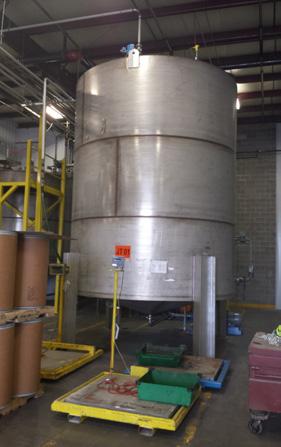
The used cooking oil is then taken to the container from the fryers using an oil shuttle or caddy. These containers filter debris from the cooking oil, whilst select indoor and outdoor containers can be installed with a remote reporting level sensor to monitor the oil levels.
In addition to automated equipment, Mahoney can help to design custom cooking oil systems based on the kitchen layout, the operation of the kitchen, and the volume of frying, with all used cooking oil handled in a clean and safe manner.
The company is therefore able to provide the piece of equipment that is most appropriate to each kitchen for
different types of customers.
“Depending on the size of the location, tank placement, and additional features to consider, we can accommodate them to create equipment that meets our customers’ needs,” says Kimball.





Almost all the cooking oil collected and recycled by Mahoney via its equipment is distributed as feedstock for sustainable aviation fuel and renewable diesel production, the former of which reduces GHG emissions by 86 percent compared to petroleum diesel.
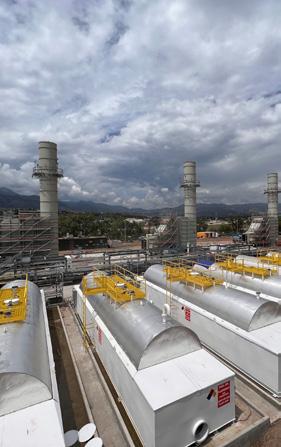
Mahoney provides transparent reporting on the amount of used cooking oil it collects from each customer, and how much of it is transformed into renewable fuels.
“We provide this data in our Fryer Oil History Reports. This way, customers have full insight into their used cooking oil collection and recycling information,” Kimball tells us.
Focused on reaching more restaurants and providing the best customer service in the industry, the coming year is set to bring many opportunities and challenges for the company and its 500 employees across the US.

“Our employees are the backbone of our company, and together, we are focused on creating a healthier and safer planet for future generations,” concludes Kimball.
“They work hard every day, knowing they are making a positive impact on our environment, helping our restaurant partners be focused on their customers, and contributing to reducing their carbon footprint.”
We are a Commercial Plumbing, Process Piping, Heating, and Cooling contractor. We work in the Southwest portion of Washington State. We perform New construction, Remodels, Service/Maintenance and/or Replacement of Plumbing, Heating, Cooling and process Systems and equipment (Boilers, Pumps, Heat Exchangers, Air Handlers, Coils, Tanks, AC equipment, Cooling Towers, Chemical Treatment systems) Office: 253-284-0306At its core, South Jersey Industries (SJI) provides safe, reliable, affordable energy services, ensuring the safety of its employees, customers and the communities it serves. We discover more with
 Leonard Brinson Jr., Senior Vice President and Chief Information Officer
Leonard Brinson Jr., Senior Vice President and Chief Information Officer
 Writer: Ed Budds | Project Manager: Louis Locke
Writer: Ed Budds | Project Manager: Louis Locke
The company is working hard to achieve carbon-neutral operations by 2040 through a combination of energy efficiency, clean energy and carbon reduction initiatives.
“While we are confident that natural gas will continue to play a role in future energy delivery, we are also excited about our portfolio of innovative renewable energy projects and initiatives,” opens Leonard Brinson Jr., SVP and CIO of SJI.
Furthermore, SJI is an energy infrastructure holding company based in Folsom, New Jersey, delivering energy services to customers through two primary subsidiaries: SJI Utilities (SJIU) and SJI Energy Enterprises (SJIEE).

SJIU currently houses SJI’s regulated natural gas utility operations, delivering safe, reliable and affordable natural gas to residential, commercial and industrial customers across New Jersey via its South Jersey Gas and Elizabethtown Gas subsidiaries.
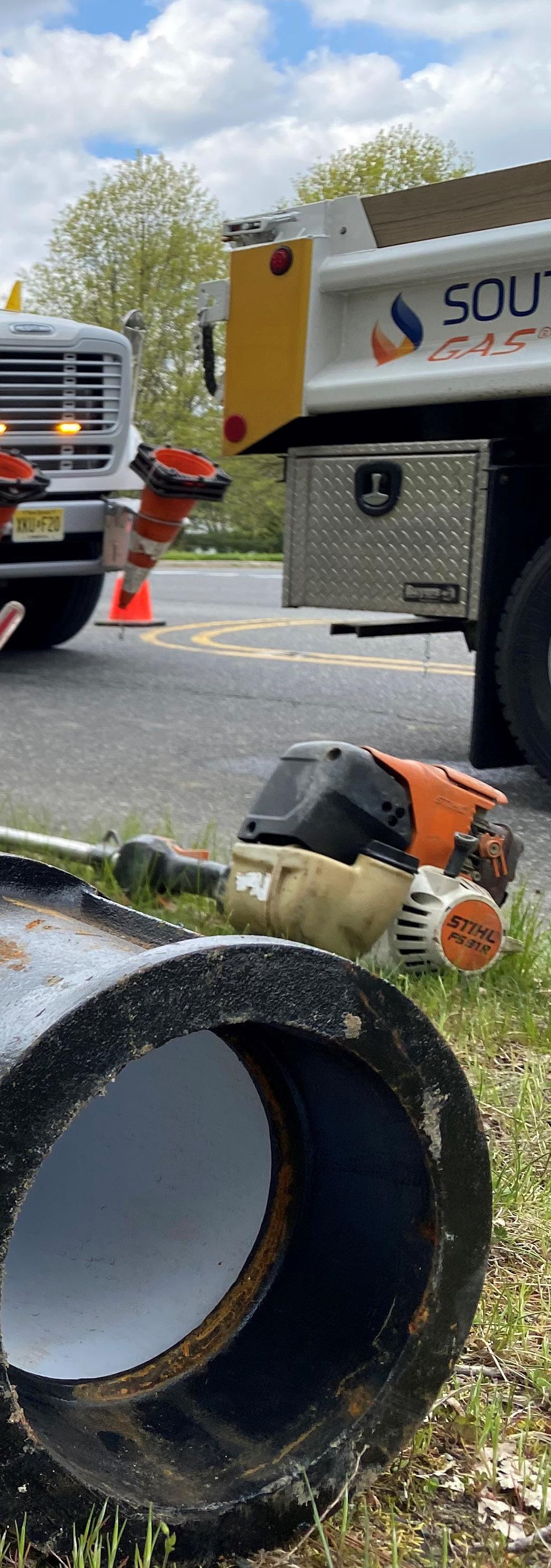
Alongside this, SJIEE houses the company’s non-utility operations primarily focused on clean energy development, decarbonization via renewable energy production, and energy management activities.
Climate change is a modern challenge that affects us all. As an established energy provider to more than 725,000 customers, SJI takes great pride in being directly involved in creating a clean energy future for the communities it serves, in the face of the current climate crisis that threatens to engulf our world.
“Together, our team of over 1,100 employees drives growth for our business, delivers our purpose, and brings us closer to achieving our vision of a clean energy future,” Brinson sets out.
A lot has changed at SJI throughout the company’s distinguished history. Still, one thing that remains the same is the company’s commitment to its customers, the communities it serves, and the environment which we all share.
Through its utility subsidiaries, SJI plans to commit $1 million each year for five years in support of local communities.
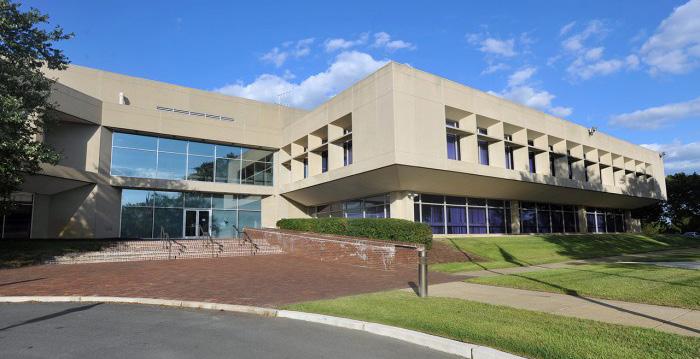
“Our employees also spend a
significant number of hours serving local communities at food distribution centers, community centers and schools,” states Brinson.
“In addition, we’re committed to our employee’s health, well-being, and development. We offer flexible work environments, employee resource groups and other professional development and personal well-being programs to help employees feel like their best selves,” he adds.
Elsewhere, continuing to differentiate itself from the vast competition in the industry, SJI’s carbon reduction goals are some of the most aggressive among all gas utility companies in the US, putting the company ahead of schedule for state and regional clean energy initiatives.
SJI will continue to invest time and human and financial resources into these key strategic areas of importance, mirroring the core values of the company’s culture of care that it has meticulously nurtured throughout its history.
Throughout Brinson’s tenure at SJI, one of his proudest accomplishments has been integrating IT into every facet of the organization.
“While our geographic information system (GIS) continues to be adopted by SJI’s various departments and teams, the system has played its most significant role in our utilities’ safety operations. We’ve also now created a detailed digital twin of our underground infrastructure through GIS,” he affirms.
As a result, technicians can pinpoint the exact locations of underground pipes, connections, system shutoff valves and customers. Service management software also enables operations teams to record and view where, when and how pipes are repaired after damage due to severe weather events.
“For our utilities’ leak detection teams, the technology allows them to access maps showing the precise size and type of pipe involved, the locations of cut-off switches and which residences and businesses are affected.”
In addition to creating utilitylevel safety solutions, SJI deploys cybersecurity systems using a defense-in-depth approach, continuously assessing, improving and strengthening its external and internal posture to identify and prevent attacks.
Similarly, the company constantly leverages its relationships with government and industry peers in several cybersecurity programs to maintain situational awareness of threats and vulnerabilities.
In addition to Brinson’s passion for integrating IT into the fabric of the organization’s business, he remains equally enthusiastic about making science, technology, engineering, and mathematics (STEM) educational and professional opportunities accessible to the local youth population.
Since 2021, SJI has partnered with
the Mark Cuban Foundation to host free, introductory artificial intelligence (AI) bootcamps for high school students based within its utilities’ service territories.

Over the course of four half-day sessions, students learn what AI is and is not, and how this technology manifests in their daily lives. So far, South Jersey Gas and Elizabethtown Gas have delivered the program to 75 students.


“At present, we are working with Bergen Community College and Atlantic Cape Community College on the development of a cybersecurity program that will help students start in high school and extend their studies to college,” he describes.
Along the way, the students in these programs can register for internships with SJI and other local businesses. The company also welcomes several students each year to participate in its IGNITE Internship Program, many of whom then work in Brinson’s department as information technology interns.
At its core, SJI is committed to continually reducing greenhouse gas emissions and looks forward to achieving carbon-neutral operations by 2040. The company plans to reach these benchmarks through three primary initiatives: infrastructure modernization, clean energy investments, and increased energy efficiency and conservation programs.
“Our investments in clean and renewable energy are the most exciting of these initiatives,” Brinson adds passionately.
By investing in renewable energy technologies such as solar, fuel cells, green hydrogen and renewable natural gas (RNG), SJI generates positive environmental outcomes that would otherwise not be possible via other alternative methods.
NORTH AMERICA OUTLOOK: COULD YOU PROVIDE US WITH SOME INSIGHT INTO YOUR JOURNEY SO FAR WITHIN THE UTILITIES INDUSTRY?

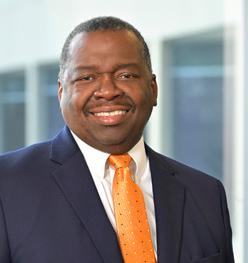
“In 2021, I was appointed SVP and CIO. Through these roles, I provide strategic guidance, leadership and direct oversight at the corporate level for all technology and business information system initiatives for the company and its subsidiaries. I’m also responsible for advancing and sustaining the corporate infrastructure and network for new technology initiatives, ensuring the integrity and security of our technology platforms. In addition, I serve on SJI’s Senior Leadership Team, where I help drive corporate strategy to ensure continued growth across the business.
(ESG) Management Committee has stringently supported the company’s commitment to diversity, equity and inclusion, safety, climate, health, human rights, human capital management and community support strategies.
For example, as a result of its development partner REV LNG’s strategic partnership to develop a portfolio of over 40 renewable energy facilities at dairy farms nationwide, SJI is now positioned optimally to become a national leader in waste-toenergy projects by 2025.
“With a long history of developing solar energy, we have also completed the installation of multiple solar arrays at our corporate headquarters and field operations facilities.”
Moreover, SJI is pursuing RNG
opportunities at several New Jerseybased landfill and wastewater treatment facilities.
Consistent with its commitment to delivering clean energy solutions and meaningful community support, SJI places great importance on its corporate social responsibility (CSR) practices and initiatives.
In addition, the committee has enhanced SJI’s alignment and ability to deliver on its CSR initiatives, including corporate and employee charitable giving, employee volunteerism, economic development, community partnerships and energy efficiency and sustainability projects.
“As we implement CSR practices into our organization’s framework, we will continue to monitor the success of our efforts and areas for improvement in our annual ESG report,” declares Brinson.
Each year, SJI’s primary mission remains the same: to deliver safe, reliable, affordable clean energy to the many customers who depend on the company on a daily basis.

“Moving forward, we will continue to deliver on this promise while also concentrating our investments on current and future clean energy initiatives and solidifying our place as an advocate for our employees and the communities we serve,” he concludes enthusiastically.
SOUTH
Tel: 609-561-9000
www.sjindustries.com
North America Outlook Issue 18 | 171 SOUTH JERSEY INDUSTRIES ENERGY & UTILITIES

Clients and culture are the bedrock of the Magnolia River experience. CCO, Robbie Laney, explores preserving the power of people in times of unprecedented change
 Writer: Phoebe Harper | Project Manager: Lauren Robinson
Writer: Phoebe Harper | Project Manager: Lauren Robinson
Much like the pipe and power lines that are its core expertise, Magnolia River’s prowess in the fields of survey, engineering, inspection and geographic information system (GIS) mapping, combined with its prevailing commitment to customers, runs deep. With a comprehensive service
offering that is dedicated to serving North America’s utilities, namely gas and power, the company also undertakes critical operations and maintenance (O&M) tasks, such as leak detection, and provides key resources through gas technician services.
“Magnolia River does everything it takes to put a pipeline or power
line in service except construction,” introduces the company’s CCO, Robbie Laney.
As a premier partner in the industry, Magnolia River works with over half of the top investor-owned utilities (IOUs) in the nation, over 100 municipals and several Engineering, Procurement, and Construction (EPC) partners.

However, when speaking with Laney, it immediately becomes clear that beyond these extensive technical capabilities, Magnolia River focuses above all on its treatment of people –whether clients or employees.
“We often use the motto, ‘Dedicated to making a difference, one relationship at a time,’” he affirms.
“We pride ourselves in doing what is right for the client – even if that is not to use Magnolia River.”
As Laney suggests, an emphasis on people and preserving healthy relationships is the cornerstone of Magnolia River’s approach, both in dealing with clients, and in fostering an inclusive company culture.

The company’s client-centric outlook, combined with its end-toend service offering, creates a focus and capability unmatched by the majority of market competitors.
Rather than spreading itself far and wide, Magnolia River chooses instead to dig deep into the areas it knows best with undivided attention.
“We are natural gas and power infrastructure specialists. We don’t do aviation, bridges, sewers, or a dozen
other things. We know what we are good at and we stick to it,” Laney confirms.
Internally speaking, the people behind Magnolia River are recognized as the company’s greatest strength. Consequently, great emphasis is placed on nurturing a culture that preserves talent and naturally encourages longevity in a welcoming and empowering environment.
“We strive to treat people with dignity and respect and get a little better each day. That, in turn, attracts great people who fit our culture,” Laney shares.
This approach ensures that talent is continually attracted to the company, reflected by the fact that in the last seven years alone, Magnolia River has quadrupled and now boasts almost 1,000 employees working across 34 states.
Within this, Laney highlights a few key individuals as integral threads to the company’s fabric, such as Sydney Gilmore, a former college cheerleader recruited at a college job fair, who has turned her hand to everything from engineering to systems administration and project controls within her seven year tenure at Magnolia River thus far. Another is the colorful character of David Love, who has been with the company for the past 18 years, and is often regarded as “Elvis”due to his popularity at industry associations.
The preservation and attraction of talent is proving to be crucial now more than ever, as the oil and gas industry faces unprecedented levels of change and uncertainty.
“It is estimated that 50 percent of the workforce (Baby Boomers) is set to retire in the next decade. Many of these are field technicians who know the ins and outs of how to keep the oil and gas flowing safely,” shares Laney.

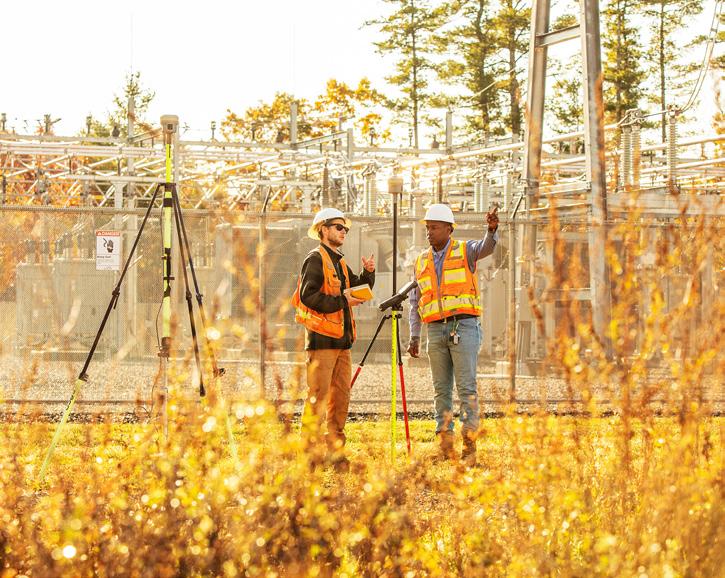
On top of this, the business must confront decarbonization efforts, gas bans, new technologies such as Carbon Capture, Utilization and Storage (CCUS), hydrogen blending, and renewable natural gas (RNG), and finally oil/gas market destabilization resulting from the Russia-Ukraine conflict.
“I honestly can’t think of a time when things were more in flux,” he continues. “The fastest increase in interest rates seen in 40 years has
“WE STRIVE TO TREAT PEOPLE WITH DIGNITY AND RESPECT AND GET A LITTLE BETTER EACH DAY. THAT, IN TURN, ATTRACTS GREAT PEOPLE WHO FIT OUR CULTURE”
– ROBBIE LANEY, CCO, MAGNOLIA RIVER
Robbie Laney, CCO: “We were fortunate to recognize through strategic planning efforts and industry associations where the market was going well in advance of the recent news. Many of our clients have announced net zero goals by 2040 and 2050 and we are trusted partners for them as they make the transition.
“In 2021, we decided to partner with a Canadian-based company, CEM Engineering, who specializes in RNG solutions. We recently participated in a ribbon-cutting ceremony with them and a key client of ours on a project, and are pursuing several more projects together.
“In 2022, we made an acquisition, SGC Engineering, that specializes in wind and solar interconnections to the Power Grid. We are undertaking engineering and leak surveys of hydrogen pipelines and are finalizing an acquisition serving the Carbon Capture and Storage (CCS) market.”


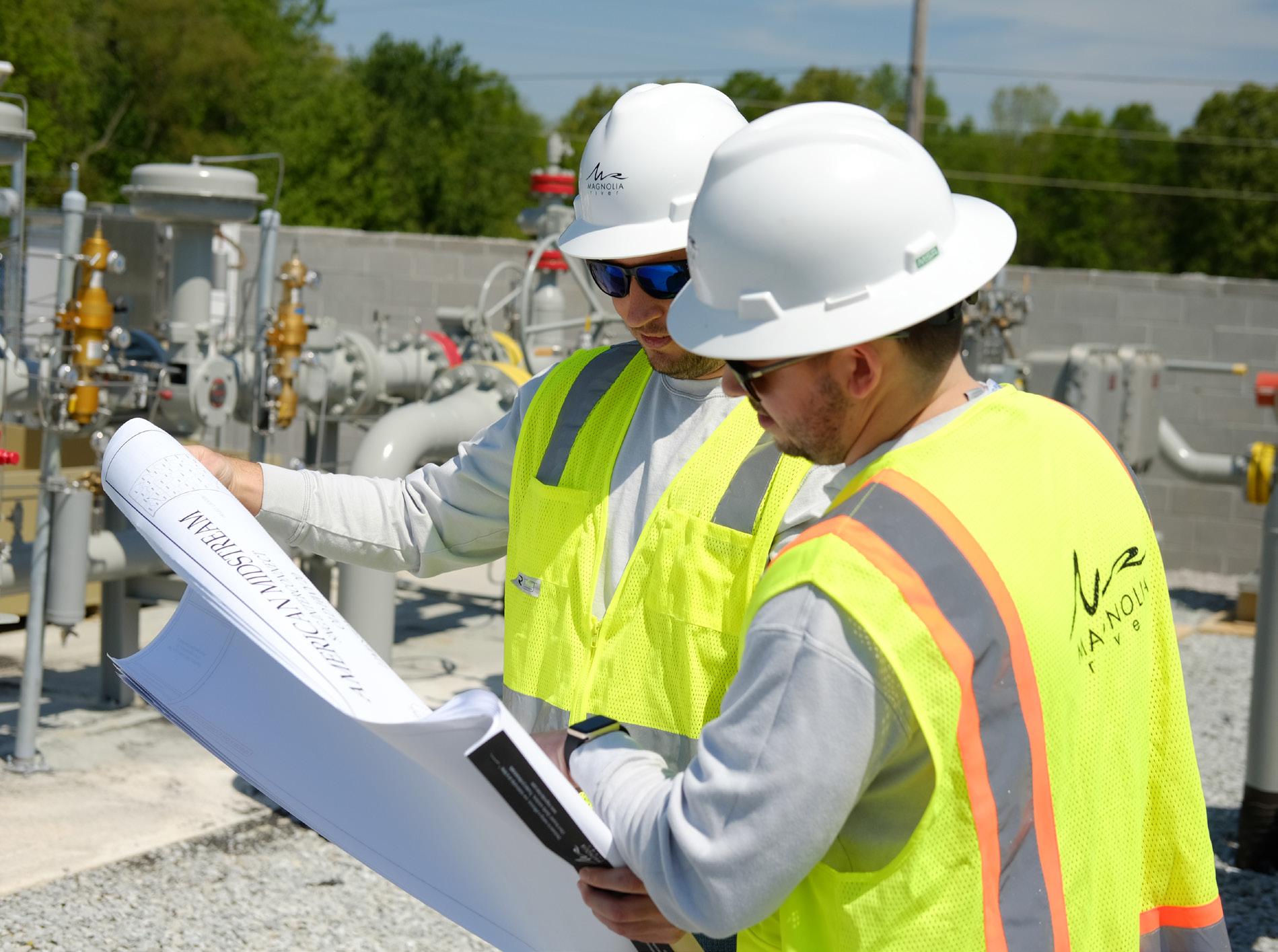

“Alonzo Breaux is a Chief Inspector for us with one of our top clients in Florida. He is so critical to this client’s operations that he often gets called by our clients to advise on a job (even when they haven’t selected us for the work to start with). He gets a job offer every other week from a competitor or from one of our clients, but he stays with us because of the Team culture that we have here.”
- Robbie Laney, CCOcompletely changed capital markets and modified utility infrastructure replacement schedules. Although difficult, it is an incredibly exciting time though for people who like challenges and change.”
On the topic of change, the company itself is still undergoing a transformation following its transition from a family-owned enterprise to ownership by a private equity firm in 2020. This change has introduced several key benefits. The acquisition has led to greater emphasis on strategic planning that analyzes industry trends, evaluates the current state of the business and enables it to craft new strategies accordingly.
“We’ve also gotten exposure to really intelligent people who have become mentors across operational, financial, and commercialization areas. Many of us have gotten opportunities to step up by learning things we’ve never been exposed to before or by changing roles to learn something new,” says Laney.
A key aspect of this acquisition is how it has informed Magnolia River’s own
approach to strategic future growth. Indeed, for the past two years, the company has embarked on a journey of steady growth through several mergers and acquisitions (M&As) and this pace shows no signs of slowing in the years ahead.
“We are very deliberate in our strategy around M&As. We would like to acquire between two and four companies a year in the natural gas or power space, specifically in professional services in key geographic areas (like West Coast and Midwest). We look for companies between 15-200 employees and between $5-50 million in revenues,” Laney outlines.
This not only expands the company’s footprint, but also enables Magnolia River to cross-sell its services to the customers of an acquired business.

“We’ve been fortunate to do that quickly with every acquisition we’ve made to date,” he adds.
After having grown organically by over 30 percent last year, Magnolia River remains “hyper-focused” on organic growth with a dozen business development team members
spreading the word throughout the market.
As the company pursues its vision of elevating from a regional firm into a national one, it will persevere with both growth and diversification.
“The acquisitions we pursue will not only help business line diversification efforts, but also bring great people with them that challenge us to get better,” Laney sets out.
While branching more towards the West Coast and differentiating its business lines to ultimately deliver superior value to its clients, Laney, and by extension, Magnolia River, understand all too well what this success ultimately rests on.
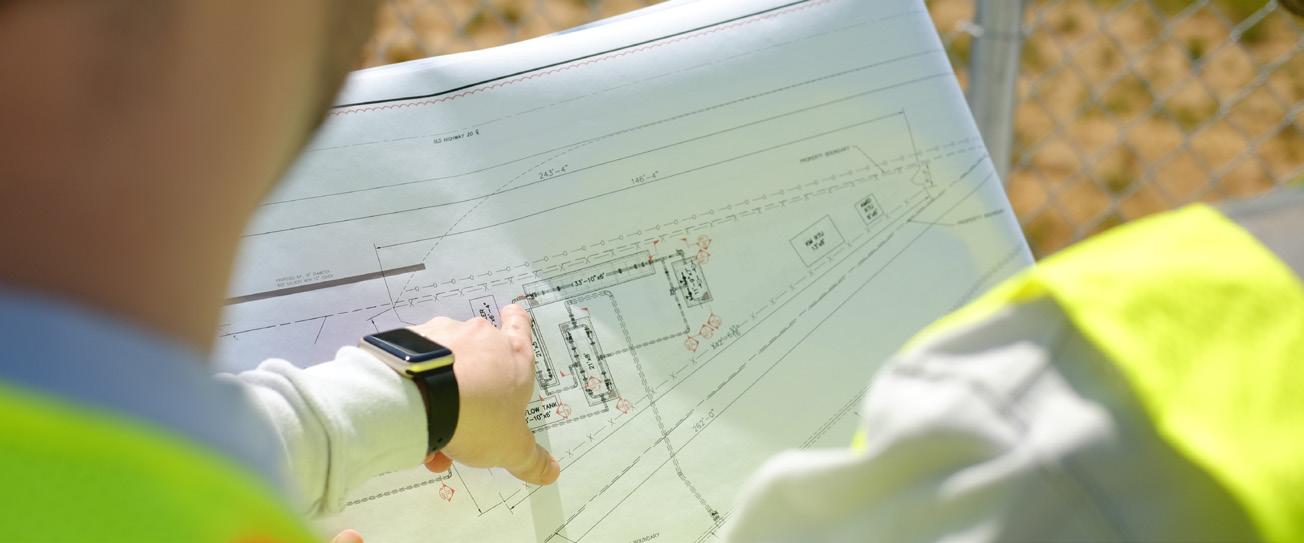

“We feel that it is our people and our culture that will help us meet those goals.”

‘DEDICATED TO MAKING A DIFFERENCE, ONE RELATIONSHIP AT A TIME’
– MAGNOLIA RIVER

Since 1987, Galileo Technologies (Galileo) has been a global reference in modular technologies for the production and transportation of compressed natural gas (CNG) and liquefied natural gas (LNG), as well as Bio-CNG and Bio-LNG.
Its product portfolio includes a wide range of gas compressor packages, gas upgrading plants and liquefaction stations, along with the Virtual Pipeline™ gas transportation system which reaches remote communities and industries without a pipeline network connection.

Characterized by its modularity and scalability, Galileo provides solutions for the production, distribution, and consumption of CNG, LNG, renewable natural gas (RNG), and hydrogen (H2). Due to the increase in demand for these products, the company has had to rapidly expand.

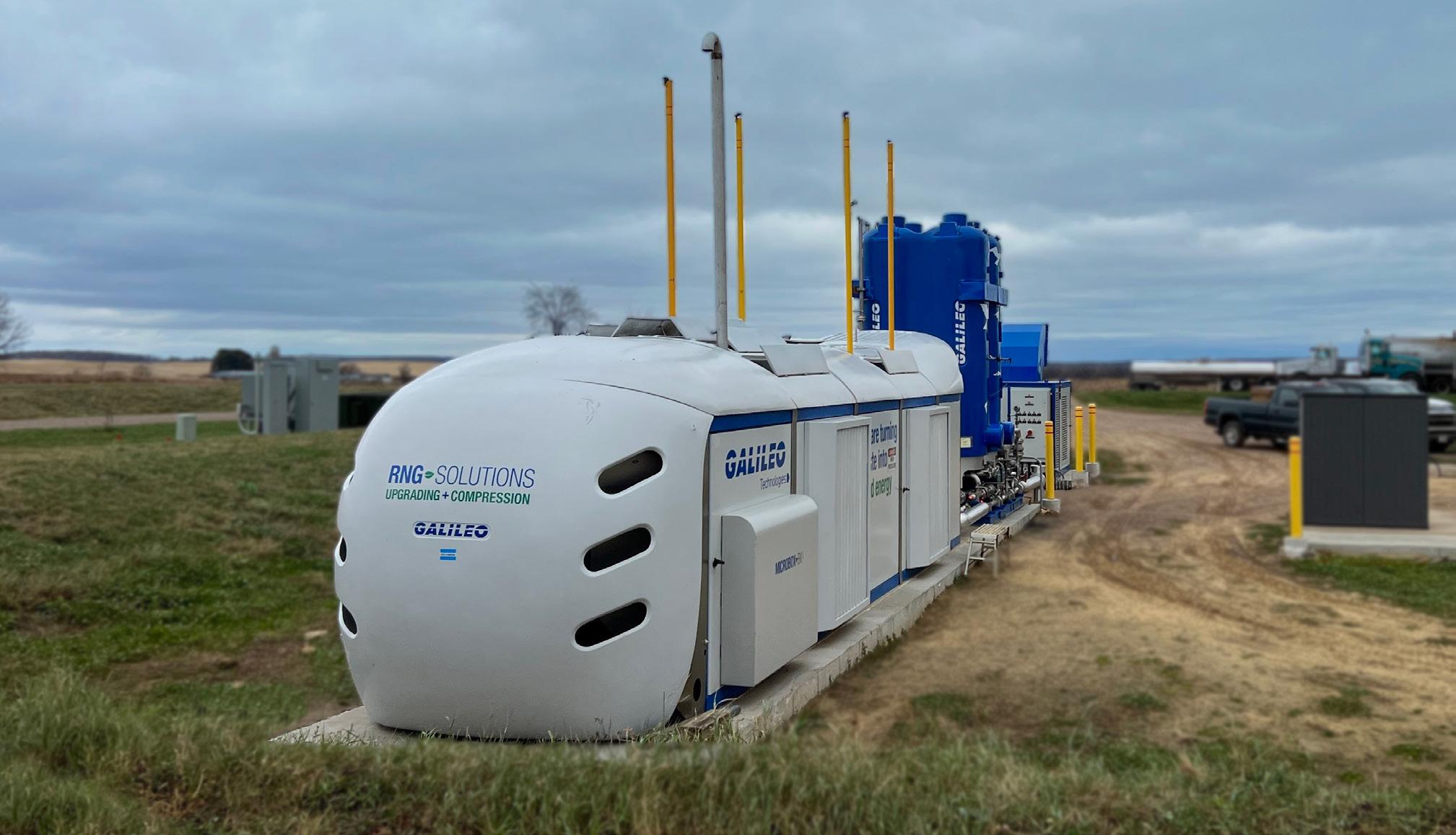
Headquartered in Buenos Aires and New Jersey, Galileo also has service centers in Texas, and Le Mans in France. It exports and provides ongoing assistance to customers in 70 countries in Latin America, North America, Europe, Africa, and Asia.
“Galileo introduced and popularized vehicular CNG, innovated in plants for urban CNG distribution networks, introduced plug and play CNG stations and introduced the Virtual Pipeline™ concept,” opens Ty Webb, Senior Vice President (SVP).
Webb was motivated to focus his career on advancing technologies within the oil and gas industry by evidence that availability and
access to energy are vital to societal development.
“As the US transitioned from a net importer of oil and was preparing to become an importer of natural gas, I truly saw the impact that new technologies could have on everyone. This inspired me to expand their technology to market, ensuring
As Galileo continues to illuminate cities and improve the lives of millions, from building the first gas fired power plant, supplied solely by trailers of
affordable and clean energy was accessible to all,” recalls Webb.
Prime Industrial Components Inc specialize in providing quality industrial control products to original equipment manufacturers, industrial end users, distributors, and engineering headquarters in the greater New York to New Jersey trading area. Its 50 years of experience and knowledge in the application of the technical products it sells is a major factor in Prime’s success over the years. Likewise, the company actively monitors the latest trends and innovations in the industrial controls field in order to offer cutting edge technology to its customers so that they can stay ahead of the game.
prime-industrial.com
LNG, to bringing on-demand LNG to the marine industry, the company has launched many innovations such as Galileo’s Virtual Pipeline™ concept. Furthermore, Galileo also created the Cyrobox® and is a pioneer in small scale LNG.

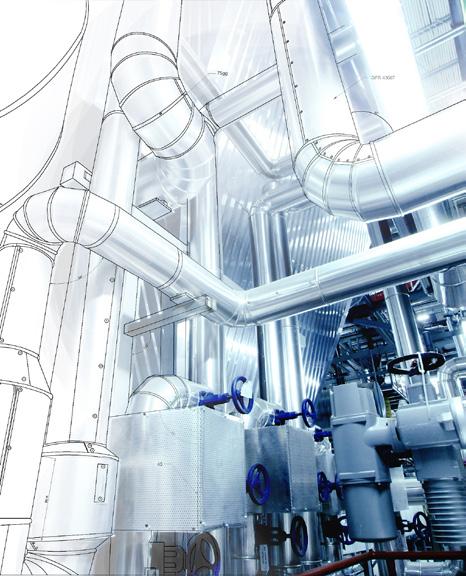
“This growth was worldwide, but
had a particular impact in South America, Southeast Asia, and Europe due to the availability of natural gas and the desire of these locations to transition towards cleaner burning natural gas in their transportation fleets,” Webb reveals.

The largest LNG facility is in Brazil,
with a capacity of 490 tons per day. The project consists of two facilities: one for LNG production and the other for regasification for power generation.
“Galileo provided, in total, 40 liquefaction units known as Cyroboxes®, five gas conditioning
TY WEBB, SVP: “When we interview potential members of our team, we perform a skillsbased segment and a behavioral segment which are both geared towards identifying not only the necessary technical skillsets, but also the behavioral traits that will enable a candidate to be successful at Galileo. We focus on qualities such as reliability, critical thinking, teamwork, and communication skills coupled with technical expertise and a willingness to learn and grow.
“In order to maximize incentivization, once a candidate is hired, we try to focus on offering them as many experiential and growth opportunities as possible. We invest in our employees’ individual development knowing that elevating our staff only elevates us as an organization and enables us to create a lasting effect that not only positively impacts our mission and goals, but also impacts our workforce and those related to them. Galileo believes one of its most valuable assets is our employees.”
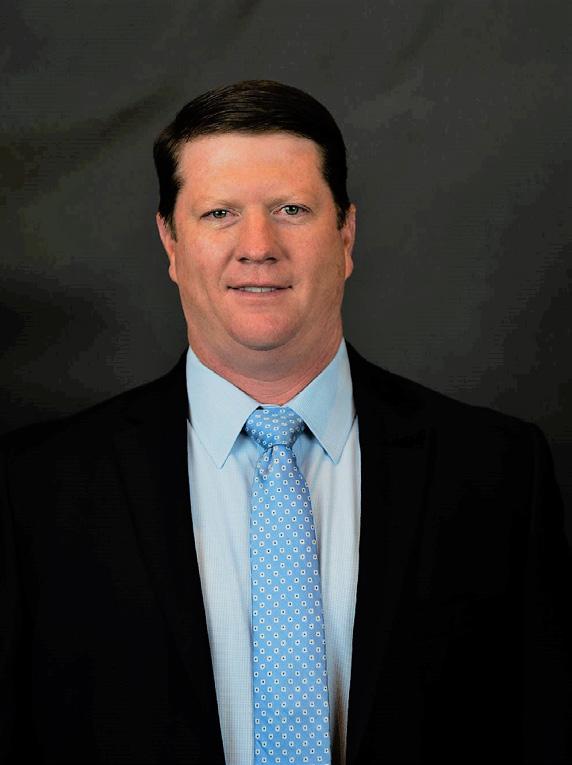
‘ZPTS®’ modules, several LNG transfer units, isotank bays for LNG storage, high pressure shell and tube LNG vaporizers, hot water boilers, boiloff-gas (BOG) compressors and auxiliaries required for the operation,” he details.
Despite all the setbacks caused by the COVID-19 pandemic, the company was able to meet its delivery and commissioning deadlines.
“The project shows the breadth of the scope that Galileo’s technical team can execute, in addition to the design and manufacture of a vast majority of the equipment on site – all within schedule.”
EDGE LNG in Texas is a subsidiary of Galileo’s operations in the US. Currently, it has 15 Cyrobox® Trailers 600s and 750s operating with a capacity of 290 tons per day of LNG production.
“These special design trailer units are gas driven by Caterpillar engines and enable the fast redeployment of gas conditioning and liquefaction to help eliminate methane flaring, which is common throughout the world as a primary source of greenhouse gas (GHG) emissions in the oil and gas industry,” states Webb.
By continuously developing new technologies for the core markets of LNG, RNG, and H2 Galileo
ensures it stays at the forefront of the energy transition. Moreover, the company is part of the European Biogas Association (EBA), where it participates in helping farmers turn their waste into RNG for high pressure filling of CNG fueled vehicles.
Galileo has recently completed a project positioned within a sanitary landfill in Puerto Rico. El Coquí Landfill, located in the Municipality of Humacao, is the first source of domestic natural gas generated on the island. The company provided a comprehensive renewable liquefied natural gas (RLNG) plant to Biomas Green Fuels, and it will supply RLNG to industrial clients such as HewlettPackard, IPR AstraZeneca, and Banco Popular for electricity generation in their cogeneration (combined heat and power – CHP) systems.
“The plant was put into operation to carry out the conditioning and liquefaction process. 3,000 standard cubic feet per minute (SCFM) of landfill gas (LFG) will be processed daily to produce 20,000 gallons of LNG per day.
“This will be distributed to displace the expensive consumption of imported LNG in private cogeneration plants. In this sense, the Puerto Rico
liquefaction facility will be removing 27,090 tons of carbon dioxide (CO2) per year from the atmosphere, which is equivalent to CO2 removed by 4,515 hectares in a year,” Webb outlines.

LNG is an important feature for Galileo with the new unit in Puerto Rico and LNG investments across the globe.
“With the start-up of the only local source of fuel on the island, Galileo and our customers see no limit to the possibilities to utilize our unique technologies to help eliminate fugitive methane emissions from landfills, municipal wastewater treatment facilities or livestock and agricultural waste sources,” he continues.
Galileo is the only supplier that

designs and manufactures a truly turnkey solution to provide either CNG or LNG, plus it has the solutions to ensure these molecules reach the final consumer. Additionally, the company is a provider of the full equipment value chain for these solutions.
As Galileo pledges to reduce flare emissions, it has built the first thermal power plant which is independent from gas pipelines. The company also investigated and developed RNG solutions to turn waste biogas into Bio-CNG, and hydrogen solutions to reduce and mitigate emissions.
Webb highlights Galileo’s plans to
develop new alternatives for LFG. The unique solution will utilize LFG due to the patented process to efficiently remove contaminants and improve the efficiency of transporting gas to market.
“In the LFG treatment stage, the plant has a CSM upgrading station connected to the landfill to remove a majority of the CO2, volatile organic compounds (VOCs) and hydrogen sulphide (H2S), and an additional ZPTS® station to remove residual CO2 and moisture, upgrading the LFG to liquefaction quality.

“Already converted into RNG or biomethane, the gas is then liquefied by a standard Cryobox® LNG production station and loaded
directly into cryogenic iso containers for immediate distribution or it can be loaded into storage containers to be utilized at a later time,” explains Webb.
During the liquefaction process of the purified LFG, the nitrogen (N2) is automatically removed without the addition of expensive and technically complex equipment required by other technologies. LNG contains between three and four times more natural gas by volume than CNG, thus drastically reducing the transportation costs of clean burning fuel.
Galileo has solutions that enable the capture of flare gas at the source by utilizing its innovative equipment.
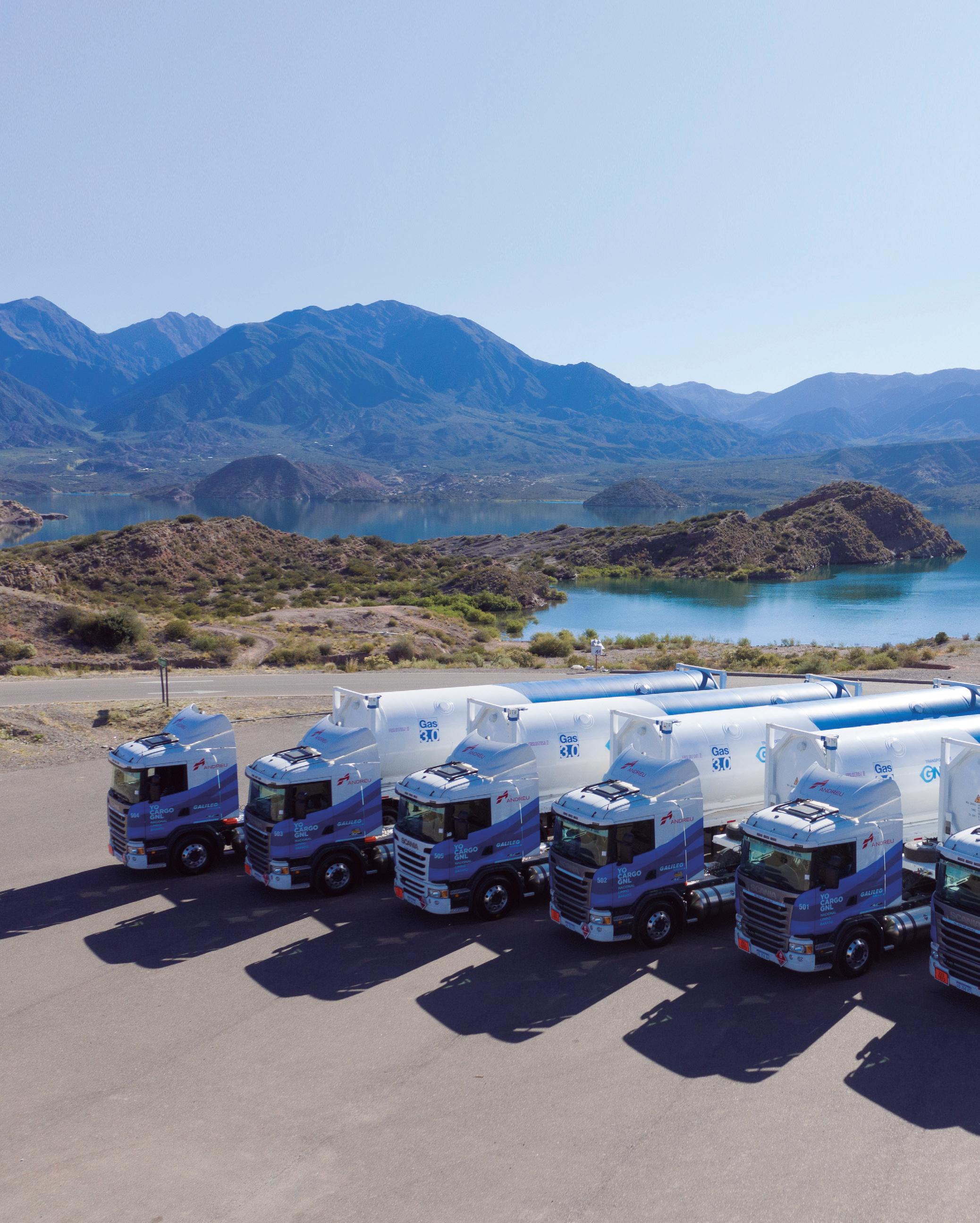
“THE US HAS ONE OF THE BEST MANAGED NATURAL GAS INDUSTRIES IN THE WORLD, THEREFORE IT GIVES AN INDICATION HOW BIG A WORLDWIDE PROBLEM FLARE GAS IS FOR A VARIETY OF REASONS”
– TY WEBB, SVP, GALILEO TECHNOLOGIES
This can enable the significant reduction of massive, global sources of GHG emissions. In the US alone, the equivalent of nearly 42 million passenger cars of GHG emissions are flared annually in the form of methane from oil/gas production.
“The US has one of the best managed natural gas industries in the world, therefore it gives an indication of how big a worldwide problem flare gas is and that solutions need to be implemented for a variety of reasons.
“These solutions have a compounding benefit for the environment by removing a major source of GHG emissions and utilizing this captured flare gas in applications which are displacing fuels such as diesel, gasoline or other higher polluting fuels,” notes Webb.
Galileo can utilize flare gas, which is typically provided at low pressure and of poor availability and quality and capture directly as CNG or upgrade and produce LNG at the source.
“There is no need to build complex gathering systems or pipelines, just simply connect our complete solution modules and eliminate the problem. Additionally, with the use of our Cryobox® trailer solution with natural gas engines, there is no need for electrical infrastructure on the site, which is rare to have at remote oil and gas wells,” Webb concludes.
With an innovative and economical approach to the gas compression and liquefaction sectors, Galileo will continue to be at the forefront of new technologies for years to come.
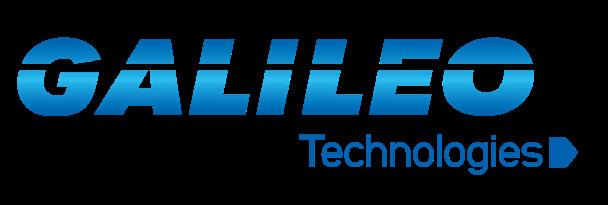
https://www.galileoar.com/en/

North America Outlook, Africa Outlook, APAC Outlook, EME Outlook and Mining Outlook are digital publications aimed at boardroom and hands-on decision-makers, reaching an audience of more than 800,000 people around the world; spanning the full range of industrial sectors.







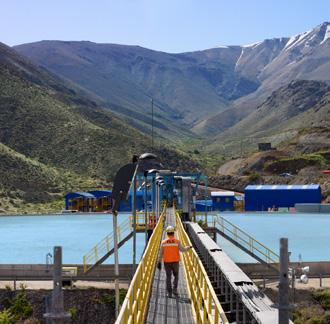









With original and exclusive content compiled by our experienced editorial team, we look to promote the latest in engaging news, industry trends and success stories from across the globe.



Your company can join the leading industry heavyweights enjoying the free exposure we provide across our platforms with a free marketing brochure, extensive social media saturation, enhanced B2B networking opportunities, and a readymade forum to attract new investment and to help you grow your business. Visit www.outlookpublishing.com/get-involved for details on how your company can feature for free in one of our upcoming editions.
www.outlookpublishing.com/get-involved



















Adding to its growing family of regional titles – EME Outlook, Africa Outlook, APAC Outlook, North America Outlook, and its sister sector title, Mining Outlook – Outlook













Publishing is proud to announce the birth of a dedicated platform for the healthcare sector. As organizations worldwide must navigate a new healthcare landscape defined by technological innovation in the wake of the COVID-19 pandemic, now is the time to showcase the strides being taken in this critical sector.


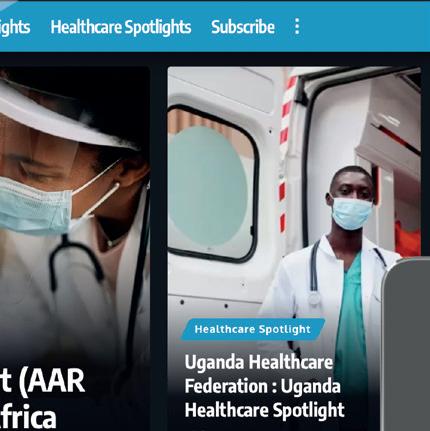





A multi-channel brand, Healthcare Outlook will bring you the positive developments driven by organizations across the healthcare industry through its various platforms. Discover exclusive content distributed through its website, online magazine, social media channels, and dispatches delivered straight to your inbox with a bi-weekly newsletter.




Through this compelling new venture, we intend to foreground the movers and shakers of the industry. To participate as a featured company and join us in this exciting endeavor, contact one of our Project Managers today.

www.healthcare-outlook.com





















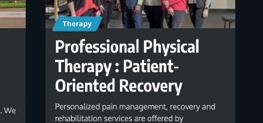









 Yarelis (middle), and Martha Holley Newsome (right)
Yarelis (middle), and Martha Holley Newsome (right)
International, Martha Holley Newsome, about the organization
support
Across the world, the work of humanitarian relief is paramount to the care and well-being of millions of people affected by conflict, natural disaster, or socio-economic unrest.
Led by faith and an unwavering commitment to equal opportunities in healthcare, Medical Teams
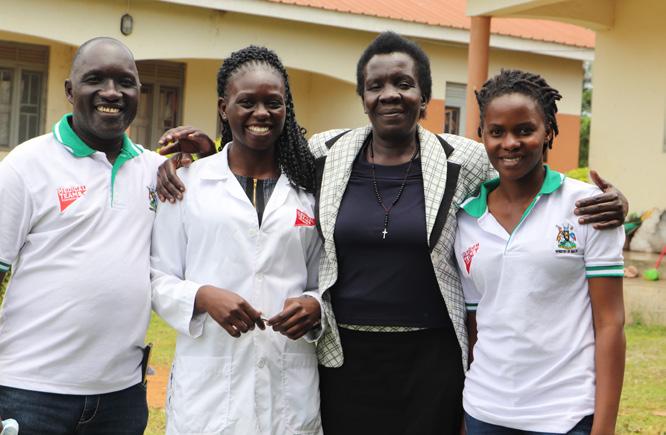

International (Medical Teams) is a Christian health and humanitarian organization that has provided medical care to those in crisis since 1979.

The organization’s founding principle is to provide life-saving medical care and support to those in need in the US and across the globe,
as it helps millions of refugees and displaced individuals receive urgently needed medical attention.
Medical Teams follows a threebranched approach to its services - providing basic medical treatment, offering an outstanding level of individual care, and working to strengthen the existing system through building trust between the healthcare services and the community. Such honorable commitments are underpinned by a vocation of: “daring to love like Jesus”.
“Like Jesus, we boldly break barriers to health and restore wholeness in a hurting world,” begins Martha Holley Newsome, President
and CEO of the company. “Not only do we desire to be the hands and feet of Jesus, but to also break barriers in access to places that have been the hardest hit by all kinds of difficult circumstances, whether that’s a natural disaster or a manmade conflict. We want to go where we are needed most, to bring medical care that is so urgently required.”
Such a commitment to aid carries Medical Teams to seven different global locations: the US, Ethiopia, Sudan, Tanzania, Uganda, Colombia, and Ukraine. In the US, it operates in the states of Oregon and Washington,
With an unmatched tenacity, resourcefulness, and level of support, we talk to the President and CEO of Medical Teams
that goes above and beyond in providing humanitarianWriter: Lucy Pilgrim | Project Manager: Felix Revell
and during the COVID-19 pandemic worked closely with the Washington State Department of Health and the Oregon Health Authority.
The support provided by Medical Teams in the US is structured through a comprehensive Care & Connect Program, which plays a critical role in extending healthcare to those without access and working to connect people to more permanent sources of health care. The program targets people who lack access, due to many barriers and the intersections of race and socio-economic status.
This theme of equity in healthcare has become more prominent in the aftermath of COVID-19, given the higher death rates experienced by different racial groups in the US. With this heightened awareness, Medical Teams is working to become more sensitive and attentive to utilizing a health equity lens in its programming.
“Minority populations are a huge proportion of who we care for - the majority, in fact. Whether they’re migrant farm workers who are working in the Yakima Valley of Washington, or
refugees, Hispanic or Black populations, veterans, the elderly - all these are key demographic groups for us,” Newsome highlights.
“We are just grateful that our
Alongside many healthcare institutions across the world, Medical Teams responded quickly and meticulously to the conflict in Ukraine, with teams traveling to Romania and Poland initially. The organization also continued its work in Moldova, which it had been conducting prior to the conflict.

Medical Teams was an invaluable counterpart to the aid provided by healthcare institutions in these countries, as they assisted in the receiving of refugees. Subsequently, the team was deployed into Ukraine, going to some of the areas they were needed most and continue to respond within, including the suburbs of the city of Odessa.
Medical Teams thankfully has numerous partner suppliers in this area. Consequently, the organization is pleased to report that they have supplied 115 generators to provide heat and electricity, as well as a large amount of pharmaceuticals and medical supplies.
team can serve and attend to these underserved populations.”

In Colombia, Medical Teams has also been working with Venezuelan migrants since 2019, who have been fleeing economic hardship caused by the collapse of the government in their home country. The community health workers (CHW) provide support in strategic urban areas, providing vouchers for medical care and sanitation and hygiene supplies, with a large percentage of vouchers being given to young women and children.

“We had the chance to go to a community known as Cienaga, which translates as ‘swamp’ because the area routinely floods. Like many of the communities we visit, Cienaga has dire sanitation and horrendous healthcare conditions,” Newsome informs.
It was within Cienaga that Yarelis, a well-loved Venezuelan member of the community team, became aware of
a heavily pregnant young indigenous woman named Keily, who had crossed the Venezuelan border. With no access to healthcare, Keily and her family fled across the border in search of aid. Consequently, Yarelis helped her gain access to vital medical care when it was most desperately needed by enabling Keily to overcome a dangerous infection and give birth to her son, Abar Jesus. Yarelis and Keily
have formed a special bond, as she checks on her daily to ensure she and Abar are thriving and helps schedule her post-natal appointments.
“Not only was Yarelis supporting her with her health needs as a mom with a newborn, but she helped the community rally around them, providing them with vital things to live, from kitchen utensils to furniture,” Newsome proudly tells us.
This fantastic case is just one of thousands, as Medical Teams excels in its responsiveness to the individual and community needs of every area in which it operates, showing examples of courage and perseverance in extreme conditions.
As a businessman from Salem, Ron Post, the founder of Medical Teams, had no prior involvement in medicine or humanitarian aid. And yet, he felt a calling one evening when he saw on television what was happening

“WE WANT TO GO WHERE WE ARE NEEDED MOST, TO BRING MEDICAL CARE THAT IS SO URGENTLY REQUIRED”
– MARTHA HOLLEY NEWSOME, PRESIDENT AND CEO, MEDICAL TEAMS INTERNATIONAL
to Cambodian refugees that were impacted by Khmer Rouge.
Post was particularly affected by the footage of a young girl he saw stagger across the border and collapse. It was at this point that he really felt God wanted him to do something. Two weeks later, Post was on a plane to Thailand to provide critical services for the Cambodian refugees in partnership with World Vision, which was running a hospital initiative on the Thai border at the time.
From such an impactful start, Medical Teams operates as a faith-inspired organization that focuses on what daring to love Jesus means in the world. Thus, with the prayer that the company can be the hands and feet of Jesus, Medical Teams demonstrates
love to its neighbors and, most importantly, helps them survive.
“Our values are to be courageous, tenacious, accountable, selfless, and not alone. We think about the latter in two ways. We want to come alongside people so that they know they’re not alone and work in partnership with others. However, we also believe that the contexts in which we work are so big that we need God as well,” Newsome highlights.
The notion of an international network of aid is paramount to the success of the organization, whether this is provided through private individual contributions or comprehensive supply chains. Regarding the former,
each donation is perceived as “gold dust,” Newsome describes, as it allows the organization to leverage resources.

“People feel moved by our work and feel the need to support us, even if it’s a personal check for $25 or corporate foundational funding, each contribution is greatly valued.”
Due to Medical Teams’ reputation and caliber of programs, it receives many grants from the United Nations High Commissioner for Refugees (UNHCR), and acquires resources from the US State Department’s Bureau of Population, Refugees and Migration (PRM).
Moreover, Medical Teams is supported by indispensable partners such as Kaiser, Seattle King
• Implementing electronic health records: ensures that patient data is easily accessible to partners and medical teams. By providing electronic records, the organization can offer a better standard of care and refer individuals to long-term healthcare.
• WhatsApp groups used by CHWs: link patients to private and public health clinics.
• Red Rose Initiative: operating in Colombia, this mobile system facilitates vouchers for urgent care. The initiative additionally provides medical supplies through local vendors, which is a dignified way to provide support as patients can choose the items they need.
County Public Health Department, and MultiCare. Each organization diligently works with Medical Teams as it recognizes the value of having proactive staff on the frontline, to achieve critical last-mile care.
From a wider supply chain perspective, it has become increasingly important to Medical Teams to work closely with both partners and donors to ensure that each individual country’s needs are being met, whilst following best practices to enhance low-resource health system strengthening.
For partners in-country, the need to have staff or volunteers who understand local custom requirements and can obtain tax-exempt status is pivotal to the success of an in-country supply chain. Medical Teams works with experienced expediters who can provide in-country agents if needed. Once in-country, medical supply management is key to the proper distribution of supplies.
Following the supply chain from donor to end user is one of the most challenging but rewarding aspects of
the organization. This year, Medical Teams has diverted 160 tons of medical supplies from landfills and served 490,000 people. The everchanging landscape of customs regulations, donor requirements, and meeting in-country needs leads to many of the much-needed changes to the medical supply chain. Being agile and responsive is key in the procurement and distribution process of these supplies, and this is one of Medical Teams’ specific areas of expertise.
Alongside the succinct organization of the international distribution of supplies, Medical Teams’ staff, from coordinators to CHWs, are the beating heart of the organization. In total, it has 2,503 employees, as the company has become more dependent on the national staff of each country to run the aid programs. This means that CHWs on the frontline are aware of the context of the crisis, as well as the people they are working with. This deliberate recruitment enhances the care provided by Medical Teams as it utilizes the skills of refugees and nationals.
Medical Teams is also determined to ensure that each staff member has the opportunity to develop their skills. Thus, it provides a multitude of learning programs in which team members can enroll and participate anywhere in the world.

As the organization continues to provide healthcare and humanitarian aid across the world, it works to sustain its Love in Action Campaign: a five-year plan to triple its impact around three aspirational goals.
Firstly, Medical Teams is determined to triple the number of refugees and displaced people that it serves, as well as triple its capacity to respond to natural disasters, and its ability to serve those in the US. This can only be achieved through the efficient mobilization of its resources, private contributions, and its global supply chain.

When the organization’s board approved the Love in Action Campaign in May 2017, the number of refugees and displaced individuals was 65 million. Five years later, that total now stands at 110 million, reflecting the urgency and necessity for the crucial work of Medical Teams.
“We endeavor to bring that number down, but unfortunately the level of conflict in the world and the impact of climate change in terms of storms and natural disasters means that the number is going in the wrong direction, which is why we think these three aspirational goals are so important,” Newsome concludes.

For decades, Direct Relief has provided medicine and medical assistance in both humanitarian and disaster situations. We speak to President and CEO, Thomas Tighe, about the organization’s important work
Writer: Rachel Carr | Project Manager: Felix RevellRelying entirely upon private contributions, Direct Relief has strived to equip healthcare professionals in resource-scarce communities since 1948.
Continually meeting the challenges of diagnosing and caring for people in need, both throughout the US and globally, the not-forprofit organization is also adept at responding to worldwide disasters.

Charities such as Direct Relief use private funds while receiving no government support. In fact, they operate in a similar way to businesses when providing goods or services
that benefit the public.
“It is a public service, but it just happens to be done privately. Nonprofit organizations exist to address important issues; it is not a compelling business case, but it is a compelling human case,” opens Thomas Tighe, Direct Relief’s President and CEO.


“I spent over two years in the Peace Corps as a volunteer teacher in rural Thailand, which was an eyeopening experience. I learned how unaddressed health problems and financial statuses affected the course of people’s lives.
“These were people with inherent talent, hopes and dreams for their
future and that of their families,” he observes.
Many of those issues remain today, both internationally and in the US, which is one of the most economically advanced countries in the world.
“Advances in healthcare have been remarkable, but the benefits are still limited to those fortunate enough to live in wealthier countries or have the personal means to secure them,” Tighe reflects.
This is where the important work that Direct Relief is carrying out makes a difference. Establishing strong ties with US healthcare companies, the organization provides aid in response to emergencies and refugee populations, alongside addressing the opioid epidemic, reproductive health, and health equity to fund and improve healthcare for marginalized communities.
Indeed, just as in 1948 Direct Relief’s humanitarian assistance is provided
without regard to ethnicity, politics, religion, gender, or ability to pay.
During the last few years, the world has experienced a series of major natural disasters, including the most destructive hurricanes and wildfires in history, and Direct Relief has been deeply involved in responding to many of them.




Not only are climate-related events becoming more frequent and intense, but they are also lasting longer than ever before. Moreover, the COVID-19 pandemic caused a large reallocation of resources to address, which left all the existing challenges and gaps in basic healthcare unattended.
“For the last year and a half, the war in Ukraine has been a significant focus for Direct Relief, as we have been the largest channel for humanitarian aid into the country thanks to the extraordinary level of support from
the healthcare industry and people all over the world,” acknowledges Tighe.
Furthermore, the devastating earthquake in Turkey and Syria has been a primary issue for Direct Relief in recent months.
“Responding to so many catastrophic events provides the perspective to see patterns. One of the recurring common issues that Direct Relief is focusing on is the availability of power, without which, health services grind to a halt.
“Power dictates everything, such as having electronic email records available, keeping drugs and vaccines properly stored, having oxygen available in hospitals, and just keeping the lights on to work and engage in communications,” he informs us.
Direct Relief has become more involved in helping health facilities install solar and battery systems to be resilient and be able to deliver services when they are most needed.
Sensitech helps Direct Relief improve its ability to provide essential medical aid to people in need with their real-time temperature monitoring devices

• Improved distribution success rates
• Active, in-transit event mitigation to prevent product loss
• Real-time supply chain visibility
• Shipping lane performance analyses
Learn more at sensitech.com
The Power for Health initiative provides grant funding to support resilient power projects across the US as the country continues to face challenges due to the impact that climate change has on global warming and the increased stress it places on the nation’s power grids.
As the economy of those types of investments is beneficial and given the nature of what the organization does, and how much of the world’s charitable supplies of insulin and other
critical therapies it handles, Direct Relief is keenly sensitive to this issue.
The distribution center in California has extensive cold-chain storage for medications and vaccines. Additionally, it was the first permitted microgrid in the continental US.
Direct Relief receives no government support, and the nonprofit is able to work in a streamlined way as a result.



This no-frills approach is reflective of the organization’s origins. Direct Relief was founded by war-immigrant businesspeople who were forced to flee Europe in World War II. Much of the initial effort was to support people caught in those historic events and in need of basic goods, including health commodities.
“They were using their own money and providing the services for free, which Direct Relief still does, so they wanted to make sure their funds were

serving their intended purposes in the most efficient way possible,” reveals Tighe.
This way of thinking – doing public good privately but doing it as efficiently as possible – has been present since the organization was founded 75 years ago.
“Most charitable causes are deeply compelling on a human level, but just because it is righteous, it doesn’t mean that every activity and expense done under that banner is carried out well or efficiently – we aim to do both,” says Tighe.
Direct Relief continues to focus on growing its global emergency and disaster response capabilities as well as expanding upon the vast network of healthcare facilities around the world, to provide ongoing support for the treatment of chronic illnesses.

“We are focused on improving and expanding logistics capabilities by continuing to partner with product donors, equipment and logistics suppliers, and community healthcare networks to gather the necessary information and training required to ensure a successful shipment, handling, and storage of temperaturecontrolled medicines.”
Direct Relief uses a simulated shipping lane assessment called Smart CAE. The software enables its team to analyze temperature variations along a transportation route. This assists in determining the correct qualified packaging configuration to use in order to maintain the required temperature of the product throughout its travels.
“We also work with our community healthcare networks to ensure they have the proper equipment and training to handle and maintain the temperature of the product upon receipt,” adds Tighe.
A sharp humanitarian imperative exists to assist those whose lives remain threatened by disease,
poverty, or disaster. It is what guides Direct Relief’s work in areas where governments and global markets are either unable or unwilling to engage in improving the health of people who are sick or hurt.
“Unwell people who do not receive care cannot work; they become poor or stay poor, and people who are in poverty are at higher risk of becoming sick.
“Breaking this vicious cycle is an enormously complex endeavor, which
requires change in many areas other than health services. Although, under any circumstance, access to better health services is essential.
“That is why we focus on improving community health and access to affordable prescription medications,” highlights Tighe.
Access is a main obstacle that patients at health centers and community clinics face every day, and Direct Relief helps tackle this challenge by providing much-needed
“ADVANCES IN HEALTHCARE HAVE BEEN REMARKABLE, BUT THE BENEFITS ARE STILL LIMITED TO THOSE FORTUNATE ENOUGH TO LIVE IN WEALTHIER COUNTRIES OR HAVE THE PERSONAL MEANS TO SECURE THEM”
– THOMAS TIGHE, PRESIDENT AND CEO, DIRECT RELIEF
medicines and supplies to those who require them the most. Its medical assistance programs equip health professionals working in resourcescarce communities to meet the challenges of diagnosing, treating, and caring for patients.

Direct Relief is a recognized international partner of Ukraine’s Ministry of Health and supports several groups in the country with requested medical aid, including trauma kits, cancer drugs, insulin, antidotes used in chemical attacks, and more. It has also supplied hundreds of emergency backpacks for first responders working in the field and dealing with injuries, trauma, infections, and other acute medical needs.
• Over $33.9 million in financial assistance
• $986 million in material aid assistance
• Over 1,450 tons of medical aid
• 283.1 million daily doses of medicine
Direct Relief has worked to assess and triage needs based on feedback from healthcare networks on the ground across both countries.
It has prioritized support in a number of areas, namely the ongoing need for medical assistance, restoring access to primary health services, providing secure accommodation for doctors and other health workers, expanding access to mental health and psychosocial services, and finally, bolstering post-operative care and rehabilitative service capacity.
• $4.5 million in financial assistance
• $88 million in material aid assistance
• 443 tons of medical aid
• 61 million defined daily doses of medicine
Direct Relief sources the majority of its medical products via in-kind donations from over 80 global pharmaceutical and healthcare companies. Furthermore, procurement of medicines and supplies is mainly limited to products included in emergency preparedness and response kits.
Occasionally, Direct Relief will procure small amounts of medical products for various ongoing programs, or to meet a crucial humanitarian need when a product is unavailable for donation from the private sector.
“To source donated medicines and supplies, Direct Relief has a dedicated Corporate Engagement team that manages relationships with current and prospective donor companies who donate through several different models,” explains Tighe.

In addition, Direct Relief has a robust team of licenced pharmacists, who in collaboration with its Emergency Response and Global Programs teams identify which medicines are most needed for various health crises around the world and for uninsured patients in the US. Mission-driven and providing critical help to millions of people throughout the world, Direct Relief is the result of motivational and inspiring leadership and teamwork.
DIRECT RELIEF
Tel: (805) 964-4767
info@directrelief.org
https://www.directrelief.org/

Vice
President and General Manager, Canada’s Wonderland“An amusement park career can be very rewarding. While it is true that it can be a demanding, busy environment with a lot of weekend and evening work, it also offers many rewards. It often happens that people start in this industry as students, spending their days making lifelong friends in a fun environment often compared to summer camp. The chance to develop marketable and transferable skills in supervision, leadership and many different disciplines make it a great investment in their career development. Hearing about their positive experiences and fond memories of friends and fun are a frequent reminder of what I love about this business.”
Jason Childs President and CEO, Saltchuk Marine

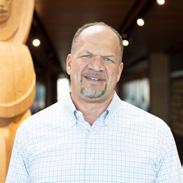
"Try it! It’s a great industry filled with interesting and occasionally eclectic people. You’ll never get bored working in the maritime industry, because it’s a huge market that is constantly changing and creating new opportunities. There is a lot of tradition that should be respected alongside a desire to improve. Many people in the industry have a natural curiosity and an adventurous spirit that leads to innovation and improvement."
Jeff McCorstin President of Global Freight Forwarding, UPS Supply Chain Solutions®
“Buckle your seatbelt!
It is quite a ride. If you are looking for
something routine and boring, you have looked in the wrong industry. If you are looking for something ever-changing that requires agility, innovation, being future-focused, and executing day in, day out on behalf of your customers then you have found the right place.”
Robbie LaneyCCO,
Magnolia River“The industry is going into such an interesting time. It beckons for people interested
in challenging the status quo and advancing energy infrastructure’s next evolution. As far as the personal characteristics needed, I think Patrick Lencioni summarized it best in his book, The Ideal Team Player, when he described the ideal candidate as “Hungry, Humble, and Smart".”
Are you a CEO/Director with a company story to tell? Contact North America Outlook now!
 Phil Liggett, Vice President and General Manager, Canada’s Wonderland
Phil Liggett, Vice President and General Manager, Canada’s Wonderland
To round off each issue, we ask our contributing business leaders for their views on the same question
Building on the global success of our regional titles – North America Outlook, Africa Outlook, APAC Outlook, and EME Outlook – Outlook Publishing is proud to introduce a platform dedicated to the mining and resources sector.

As mining organizations worldwide confront unprecedented change, embracing technological innovations and incorporating critical environmental sustainability agendas, now more than ever is the time to showcase the strides being taken in this dynamic sector.
A multi-channel brand, Mining Outlook brings you the positive developments driven by organizations across the global mining industry through our various platforms. Discover exclusive content distributed through our website, online magazine, social media channels, and dispatches delivered straight to your inbox with a bi-weekly newsletter.
Through this compelling new venture, we foreground the movers and shakers of the industry. To participate as a featured company and join us in this exciting endeavor, contact one of our Project Managers today.
www.mining-outlook.com


